Paul Finch's Blog, page 9
October 31, 2019
Galleries of Darkness - for October, Week 5
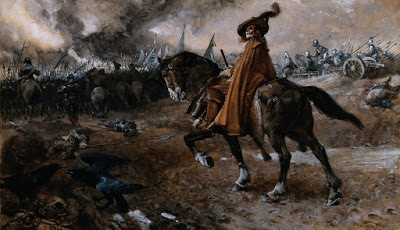
Halloween is finally here, so today I’m pleased to present my fifth and last GALLERY OF OCTOBER DARKNESS. You’ll find it further down the blog. In addition, I’ll be talking some more about SEASON OF MIST, which was my main autumn publication. Again, you’ll find that further down too.
I’ll also be reviewing and discussing in my usual forensic detail - and this is a very timely one, I think you’ll agree - THE MAMMOTH BOOK OF HALLOWEEN STORIES , as edited by the indefatigable Stephen Jones.
If you’re only here for Mr Jones’ latest epic anthology, shoot straight down to the lower end of this column. As always, you’ll find it in the THRILLERS, CHILLERS section.
However, if you’ve got a bit more time, just hang around here a little longer, and we’ll talk a bit about SEASON OF MIST .
 Starry nights, misty woods
Starry nights, misty woodsI relaunched this novella last September specifically so that it would coincide with the autumn. And now I need to elaborate on that a little, because you could be forgiven for thinking that this book is all about Halloween, and that as we’ve now reached October 31, there isn’t much point reading it (assuming you haven’t done so already).
I must refute that. While Neil Williams’ wonderful cover-art is entirely appropriate for SEASON OF MIST because there is a dramatic high-point in it that occurs on Halloween Night, there are similar dramatic events on Bonfire Night and later on, in December, when an autumn of red leaves and mist (just think Sleepy Hollow and you won’t be far wrong) gives way to a winter of snow, ice and hard, glinting frost.
So, please don’t make the mistake of assuming that, now Halloween is over, that’s it, SEASON OF MIST is done. Trust me, it really isn’t. And if you haven’t already taken a chance on it, now is as good a time as any.
Next meanwhile, something that actually is ending ...
The final gallery
All through this last month, you’ll hopefully have noticed that I’ve been posting what I refer to as GALLERIES OF DARKNESS, each week focussing on 20 different artists - painters, concept guys, book illustrators, game designers and the like - who have occasionally dipped their brushes, nibs, whatever into the darkest inks. We’ve seen some wonderfully scary stuff drawn from some truly fiendish imaginations and realised on canvas, paper, screen etc in the most handsome and evocative ways.
Here, now that October is over, are my final 20.
You can see from the painting at the top of this column - Death as General Rides a Horse , by Edgar Bundy (1911) - that classical artworks, and even modern art done in the classical style, has often dealt with ghoulish subject matter. So, it’s not something new. That notwithstanding, I’ve mostly tried to select only contemporary artists for this series simply because it might help introduce you chaps to a few wonderful talents whom you might not yet have encountered.
Again, I give my customary warning that, though I have never selected anything for these galleries that is simply revolting or obscene, always opting instead for the terrifying and macabre, none of these artists hold back. There is some pretty eerie and twisted stuff on here. So, you have been warned.
Enjoy ...
1. ANDREW FEREZ
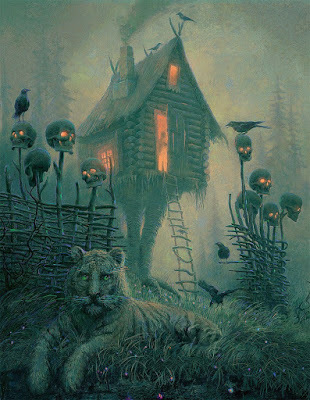
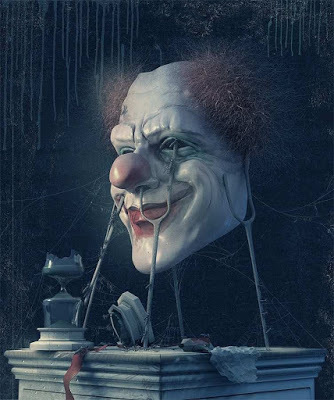

2. WES BENSCOTER
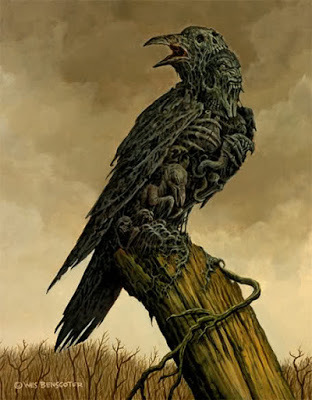
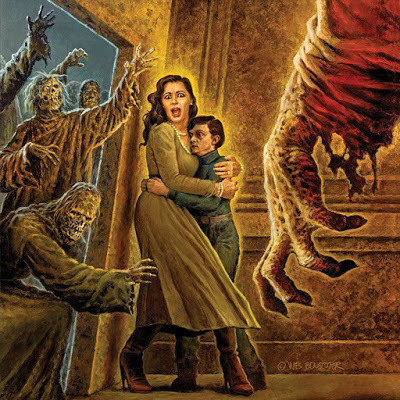
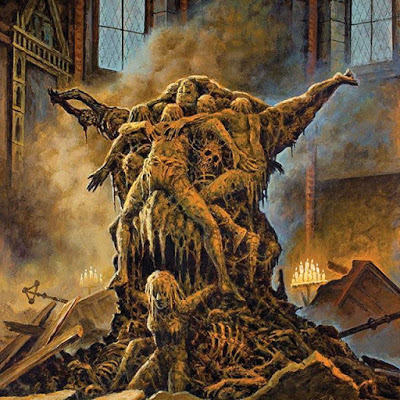

3. ALDO KATAYANAGI
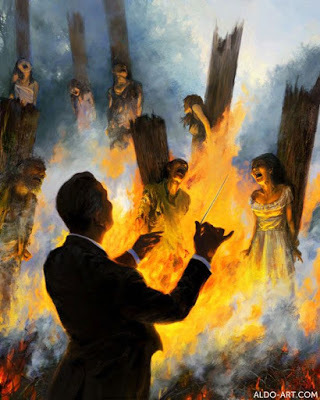
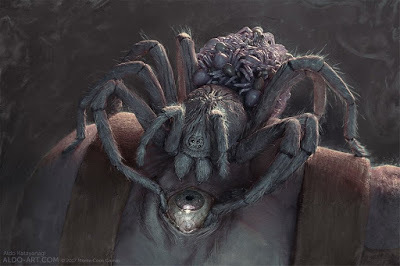
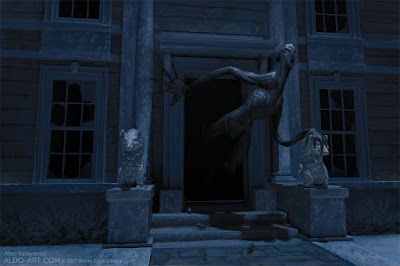
4. CHRIS MARS
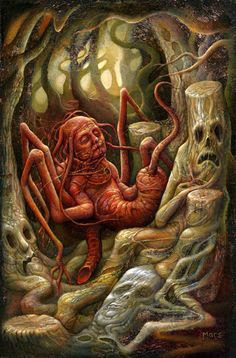
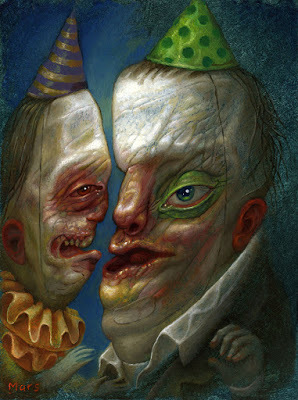

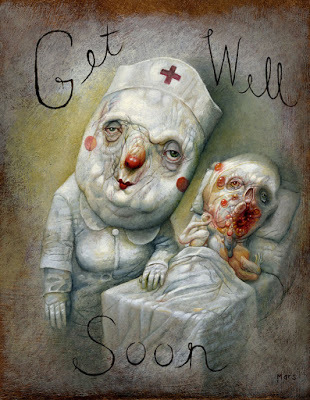
5. VINCENT CHONG
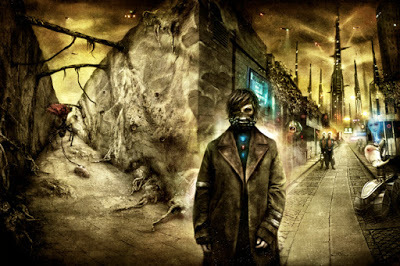
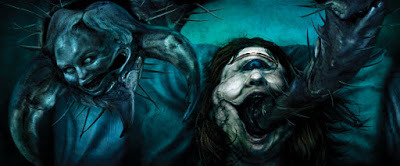
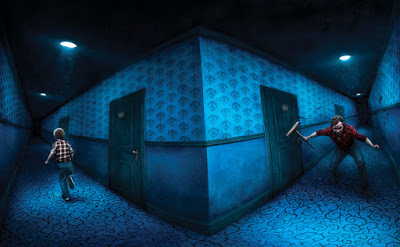
6. FRED EINAULDI
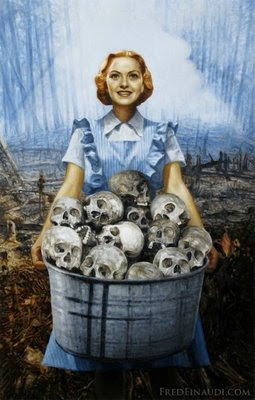
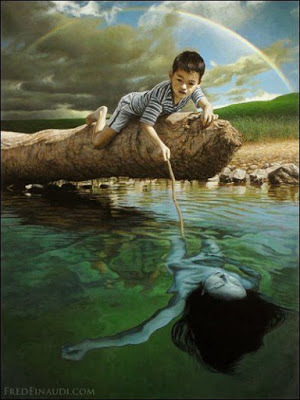
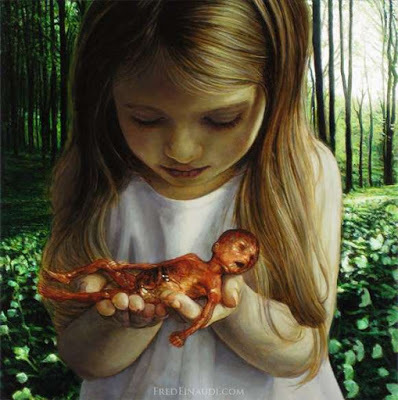
7. ANTON SEMENOV

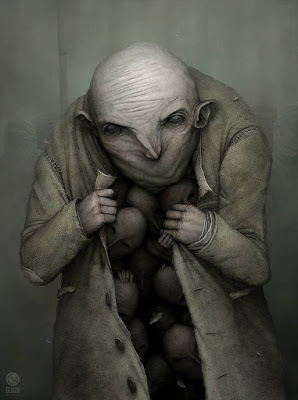
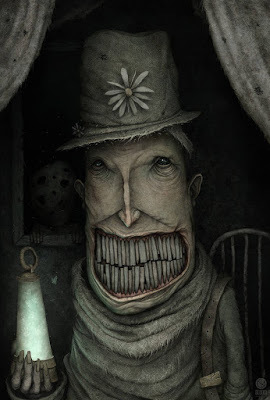
8. GABRIEL ASTAROTH
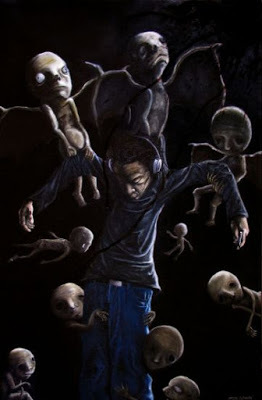
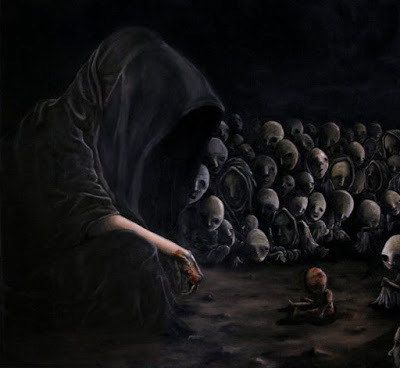
9. JEREMY ENECIO
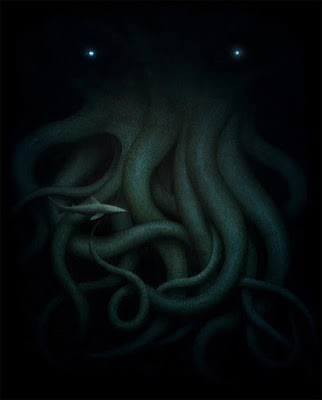
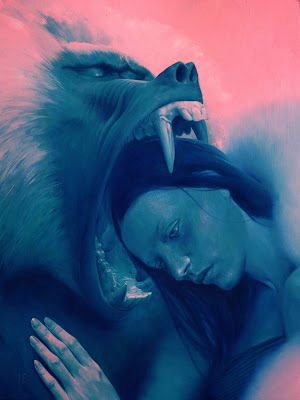
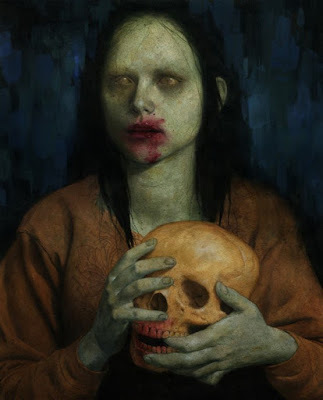
10. ZACK DUNN
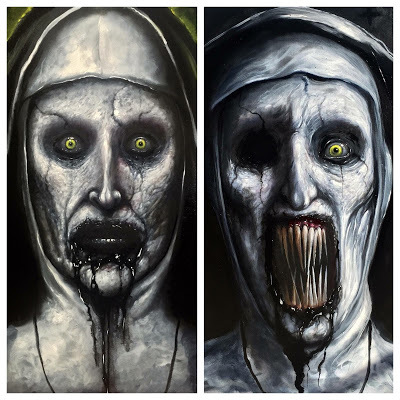
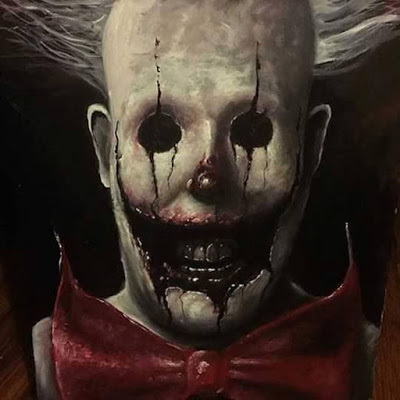
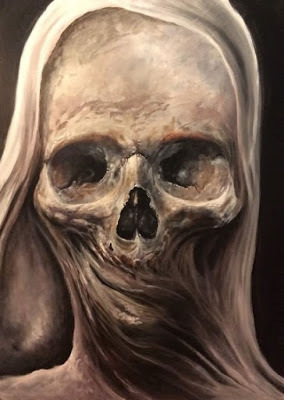
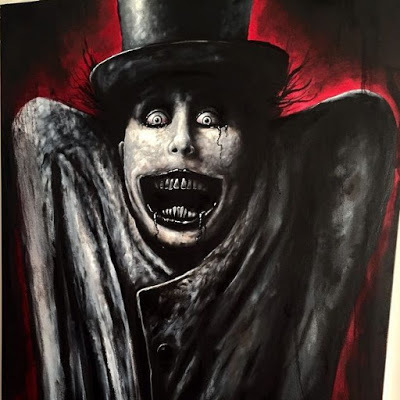
11. STEPHEN GAMMELL
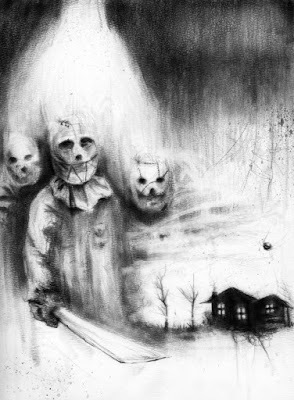
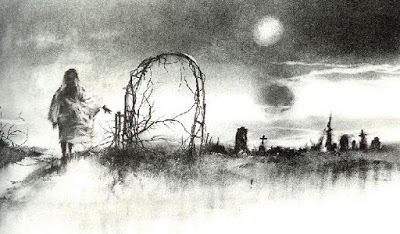
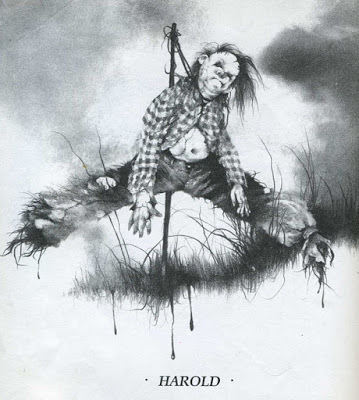

12. CHAPMAN BROTHERS
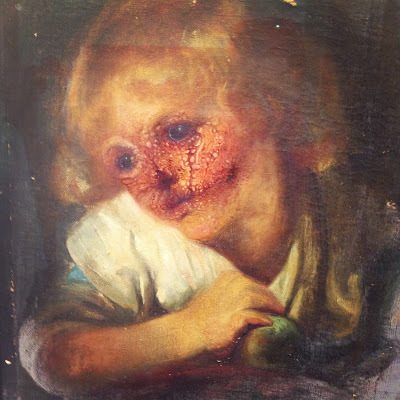

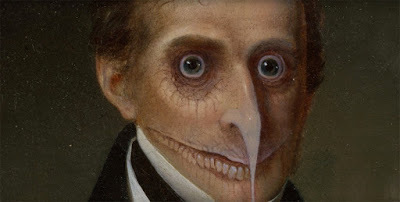
13. KAZUHIKO NAKARUMA
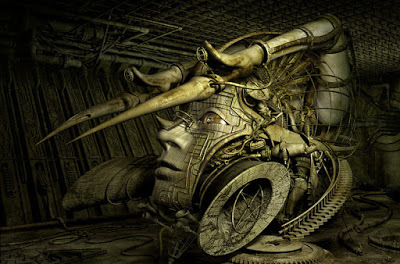
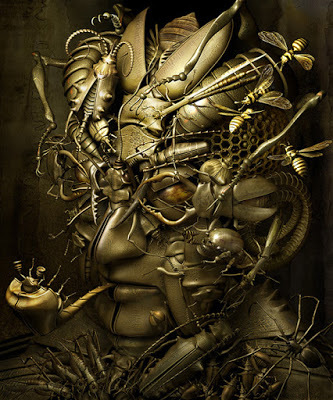

14. BEN BALDWIN
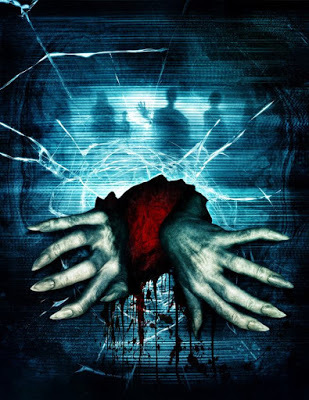
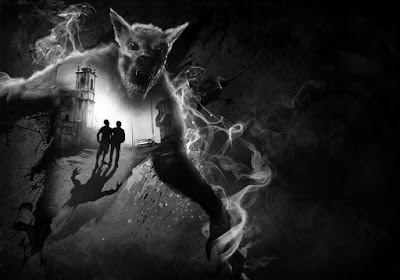
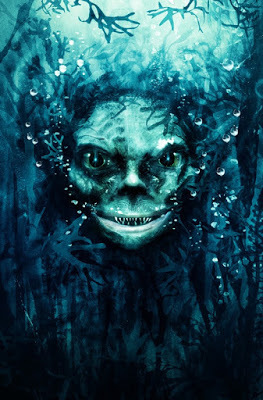
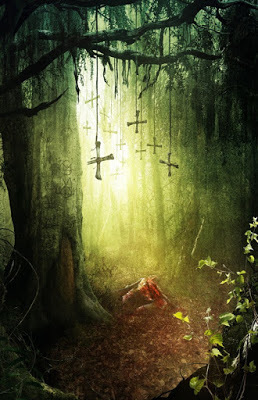
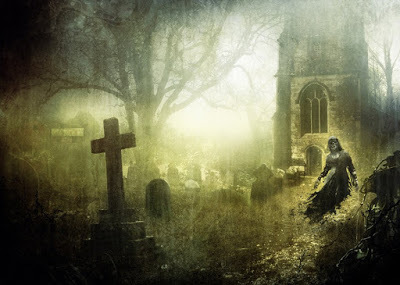
15. DANIELE SERRA
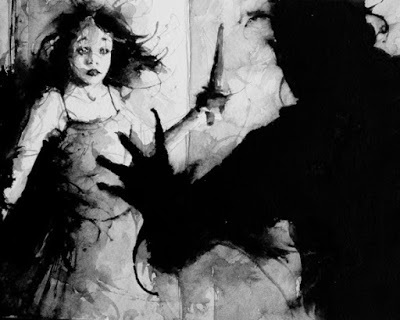
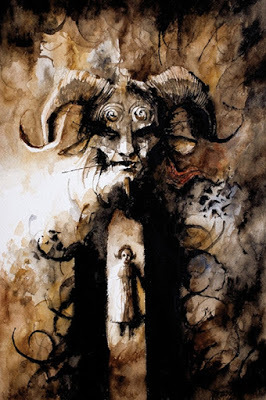
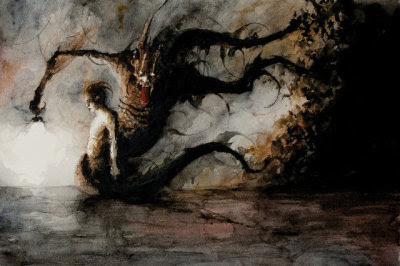
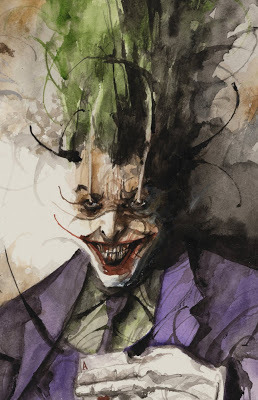
16. RUSSELL MARKS
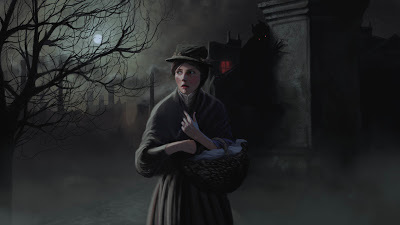
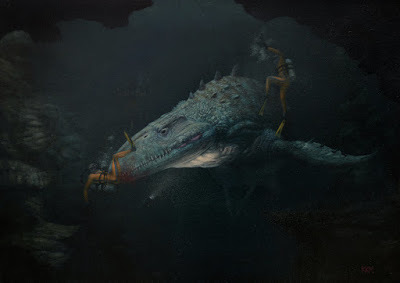
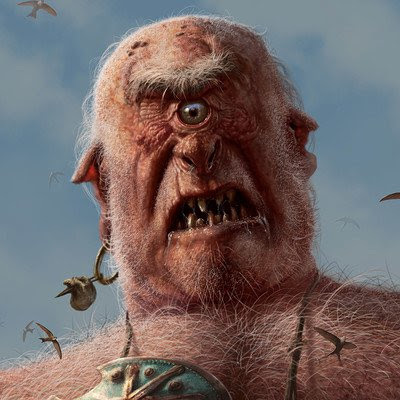
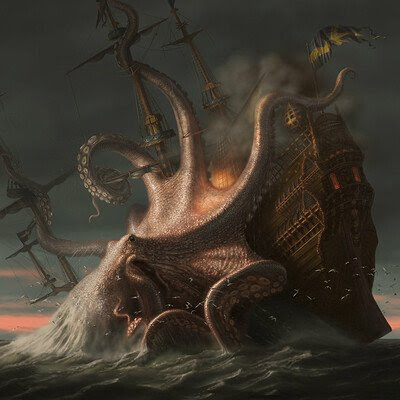
17. FREDERICK COOPER
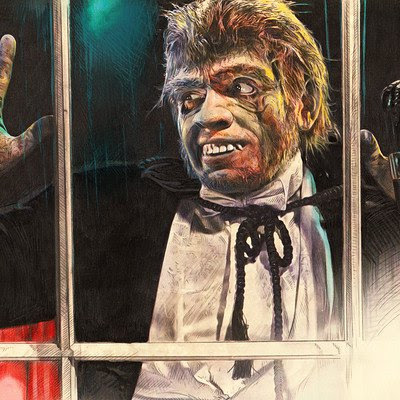
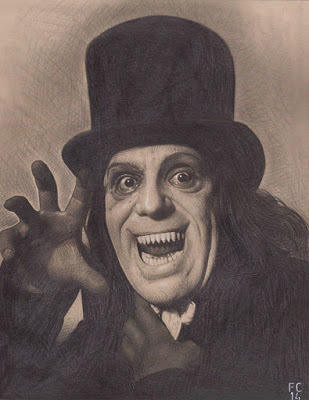
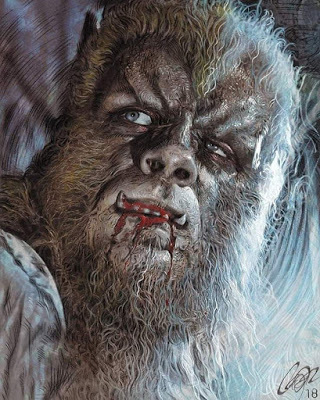

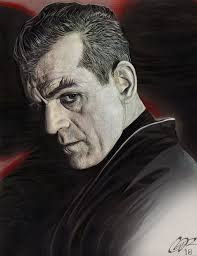
18. ALEXANDER REISFAR
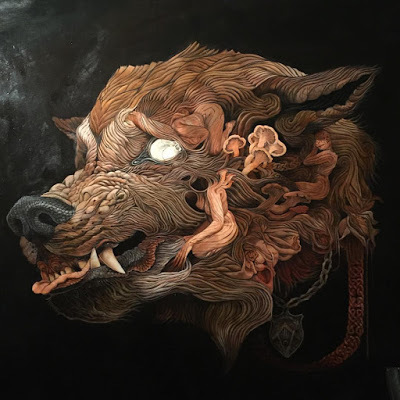


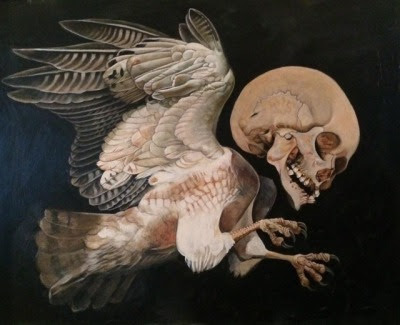
19. SVETLIN VELINOV
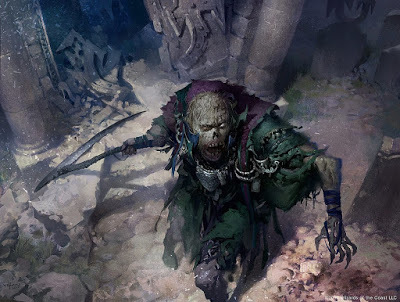
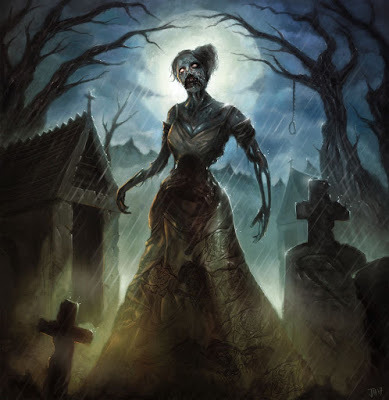
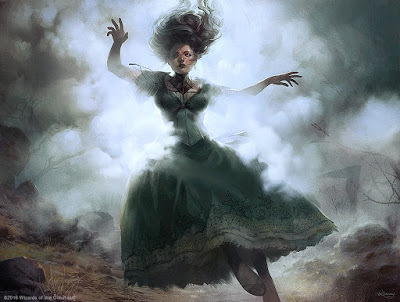
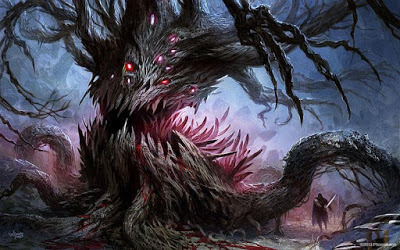
20. DHOLL
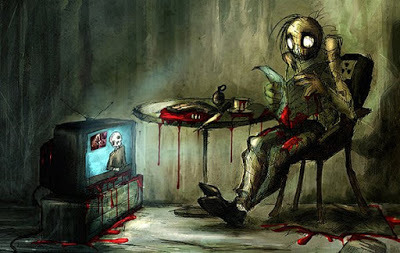
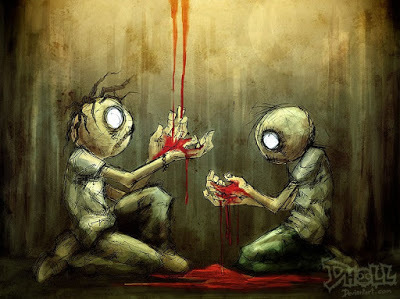
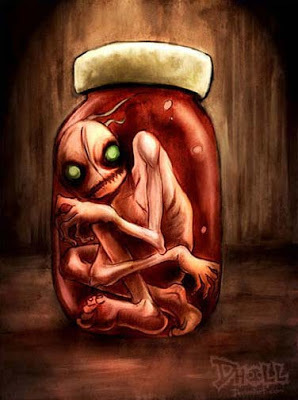
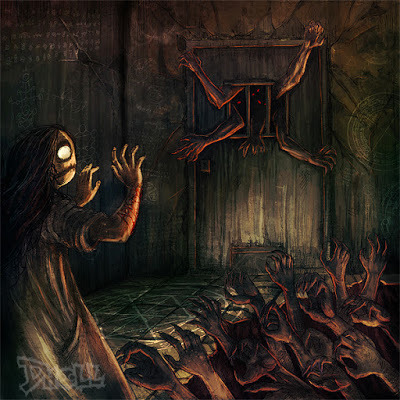
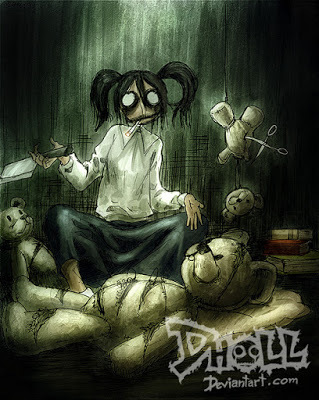
THRILLERS, CHILLERS, SHOCKERS AND KILLERS …
An ongoing series of reviews of dark fiction (crime, thriller, horror and sci-fi) – both old and new – that I have recently read and enjoyed. I’ll endeavour to keep the SPOILERS to a minimum; there will certainly be no given-away denouements or exposed twists-in-the-tail, but by the definition of the word ‘review’, I’m going to be talking about these books in more than just thumbnail detail, extolling the aspects that I particularly enjoyed … so I guess if you’d rather not know anything at all about these pieces of work in advance of reading them yourself, then these particular posts will not be your thing.
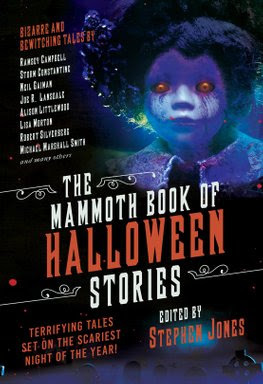 THE MAMMOTH BOOK OF HALLOWEEN STORIES edited by Stephen Jones (2018)
THE MAMMOTH BOOK OF HALLOWEEN STORIES edited by Stephen Jones (2018)As the title makes clear, a themed Halloween horror anthology, originally published in time for October 31 last year, though in truth it contains enough spooky tales and timeless treats to be readable at the misty, murky tail-end of any year.
Rather than simply hit you with a succession of brief short story outlines, I’ll first let the publishers give you their own official blurb, which neatly lays out the autumnal chills lying ahead:
Treat yourself to some very tricky stories! Halloween … All Hallows’ Eve … Samhain … Día de los Muertos … the Day the Dead Come Back … When the barriers between the worlds are at their weakest – when ghosts, goblins, and grisly things can cross over into our dimension – then for a single night each year the natural becomes the supernatural, the normal becomes the paranormal, and nobody is safe from their most intimate and terrifying fears.
The Mammoth Book of Halloween Stories brings you a dark feast of frightening fiction by some of the most successful and respected horror writers working today, including Ramsey Campbell, Neil Gaiman, Joe R. Lansdale, Helen Marshall, Richard Christian Matheson, Robert Shearman, Robert Silverberg, Angela Slatter, Steve Rasnic Tem, and many more, along with a very special contribution by award-winning poet Jane Yolen.
Here you will encounter witches, ghosts, monsters, psychos, demonic nuns, and even Death himself in this spooky selection of stories set on the night when evil walks the Earth …
Come the waning of the year, Halloween horror anthologies, much like Halloween horror movies, become a fixture on our ‘want lists’. Given that October 31, with its ghost stories and ghoulish pageantry, is easily the scariest night of the year in the western tradition, but also, for many, and for exactly the same reason, the most fun night too, it’s surely no surprise that writers and editors have visited it time and time again. Almost inevitably of course, those working at the darker end of the literary spectrum have colonised it most. But as a Brit, I’ve long had a beef with Halloween fiction, and this centres around the fact that it’s almost invariably hogged by Americans.
Now, don’t get me wrong – the US has produced some of the world’s greatest horror writers, not to mention novels, stories and film scripts, and I have absolutely no complaints about that. But it’s peeved me many times in the past to pick up a collection of new Halloween fiction and find that, almost without exception, every story relates to the American experience. And whenever I’ve expressed these sentiments to fellow Brits, I’ve been told: “Well, that’s because in the US it’s an old festival, while in the UK it’s fairly new.”
Come on, guys!
In the UK Halloween is NOT new. It’s one of our most ancient celebrations; it’s just that it hasn’t been quite as big a party in recent times because the highlight of our autumn, as imposed upon us by royal decree, Bonfire Night, occurs only five days later.
But now, thankfully, we have an anthology that puts all this right … perhaps understandably so, given that Stephen Jones, one of the world’s most respected and hardest working anthologists, is British. Not that he focusses purely on the UK in The Mammoth Book of Halloween Stories ; far from it. He certainly includes a number of front-running British horror authors – Neil Gaiman, Storm Constantine, Ramsey Campbell, Michael Marshall Smith et al – but there are plenty of Americans in here as well – Richard Christian Matheson, Lisa Morton, Joe R Lansdale and Thana Niveau, among others, not to mention a couple of Aussies in Robert Hood and Angela Slatter, and a Canadian in Nancy Kilpatrick, while at least two of the stories, Memories of Día de los Muertos by the aforementioned Kilpatrick, and the spine-chilling Not Our Brother by the legendary Robert Silverberg, take us to Mexico, where Día de Muertos is not just a holiday but a revered religious fête.
So, rest assured, a wide range of voices and perspectives are on offer in this one, which, as I say, makes a refreshing change, and enables Steve Jones to tackle the many different aspects of this complex, multi-layered festival, and the varied customs wrapped up in it (not all of which, I have to say, are purposely terrifying – the editor himself prewarns us about this in his intro).
But ultimately, of course, for all these different takes, there is a common thread. Halloween is the night on which the realms of the living and the dead are closest to each other, when spirits and other entities, both benign and malignant, can cross over into our world and commune with us. And the late autumn atmosphere of darkness, mist and swirling leaves only adds to this eeriness, and thus provides a backdrop that runs throughout.
It’s all become rather ‘on the nose’ in real life, of course. An interesting essay at the beginning of the book, When Graveyards Yawn , penned by Jones himself, explains how the iconic imagery of Halloween – witches on broomsticks, black cats, jack-o-lanterns – was first popularised in the late Victorian era via the publication in America of spooky postcards. There is little of that to be found in the actual fiction here. Jones is far too astute and eclectic an editor to select anything so obvious (and where it does appear, it is often turned on its head: Lantern Jack by Christopher Fowler, for example, or The Halloween Monster by Alison Littlewood). But the essence of the traditional Halloween remains. In Neil Gaiman’s October in the Chair , for example, a tale redolent of cold, dark autumn nights, the personifications of the months gather at a woodland bonfire to hear October tell the sad story of a lonely boy who runs away from home, befriends a ghost and decides that he never wants to leave its side … ever. While Adrian Cole’s Queen of the Hunt sees a rural cop investigating what looks like an animal-attack fatality but worried by the rapid approach of Halloween, because he knows the weird rituals with which it is celebrated in these parts, and fears that the two may be connected. Equally traditional is Marie O’Regan’s Before the Parade Passes By , wherein a recently-made widow and her young daughter move to a new town, the community of which appears to embrace them … except that Halloween is almost upon them, and the child is increasingly scared by the prospect of the mysterious ‘parade’. Perhaps most atmospheric of all, though, is Storm Constantine’s Bone Fire , which takes us into a pre-industrial age British village, where Halloween is lavishly celebrated, and all kinds of strange and interesting guests are anticipated (more about this story later).
Of course, the real test of any horror anthology is whether it’s frightening or not. The stories it contains can be superbly written and clever as Hell – and all these things are to be found in this tome – but if it doesn’t put a few chills up the reader’s spine, then it hasn’t done its job.
Well, I’m glad to say that The Mammoth Book of Halloween Stories ticked this box too. Particularly memorable in this regard is Her Face by Ramsey Campbell, in which a young boy regularly buys cigarettes for his single mum in the corner shop across the road, but as Halloween approaches, becomes increasingly afraid of the horror masks it is stocking. We also have Robert Silverberg’s previously mentioned Not Our Brother , an intensely frightening Samhain epic, which sees an American collector of Mexican memorabilia head south of the border to spend the Day of the Dead in a remote village, where he aims to persuade the locals to sell him some valuable tribal masks, unaware of the level of resistance he’ll encounter. And The Folding Man by Joe R Lansdale, a classic pursuit horror in which a unstoppable monster is unleashed on a bunch of irreverent teens (again, more about this story later).
These are chilling tales all, showing scare-meister authors at the top of their game, and they’re not the only ones. Angela Slatter’s The October Widow will also creep you out, as will Cate Gardner’s Dust Upon a Paper Eye and Lisa Morton’s The Ultimate Halloween Party App , to name but a few (yet again, more about the first two of that trio later).
All this said, it isn’t just about being frightened. The Mammoth Book of Halloween Stories also contains some serious and thought-provoking fiction. Michael Marshall Smith’ s The Scariest Thing in the World and Alison Littlewood’s The Halloween Monster are both excellent and beautifully written tales, which remind us that man’s deadliest foe, whatever night of the year it is, is man himself. While other contributions, if not exactly head-trips, go way beyond the others in terms of dark, surreal fantasy. A good example is the ever-reliable Steve Rasnic Tem’s strangely affecting Reflections in Black , in which an embittered man travels across the States, looking to hook up with an old girlfriend, and encountering all kinds of Halloween weirdness en route, while Robert Shearman’s Pumpkin Kids is so strange and disturbing that it defies a thumbnail outline – you’ve just got to read it.
And that’s the message for the whole of this book, really. Buy it and read it. It’s not the first Halloween anthology, and it certainly won’t be the last, but I suspect it’ll never have many rivals that can boast such a broad range of story types and Halloween subject-matter.
It was published for Halloween last year, but it’ll work just as well for Halloween this year. So, waste no further time …
And now …
THE MAMMOTH BOOK OF HALLOWEEN STORIES – the movie.
Just a bit of fun, this part. No film maker has optioned this book yet (as far as I’m aware), but here are my thoughts on how they should proceed, if they do.
Note: these four stories are NOT the ones I necessarily consider to be the best in the book, but these are the four I perceive as most filmic and most right for adaptation in a compendium horror. Of course, no such horror film can happen without a central thread, and this is where you guys, the audience, come in.
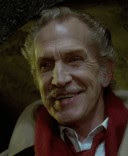 It could be that we opt for Neil Gaiman’s concept of October occupying a woodland chair while a bonfire blazes nearby, regaling us with chilling stories of the season; or maybe we just fall back on that old chestnut (see what I did there?), with four strangers thrown together in unusual Halloween circumstances, which require them to relate spooky stories … perhaps a late-October party at
The Monster Club
, hosted by Erasmus the vampire. But basically, it’s up to you.
It could be that we opt for Neil Gaiman’s concept of October occupying a woodland chair while a bonfire blazes nearby, regaling us with chilling stories of the season; or maybe we just fall back on that old chestnut (see what I did there?), with four strangers thrown together in unusual Halloween circumstances, which require them to relate spooky stories … perhaps a late-October party at
The Monster Club
, hosted by Erasmus the vampire. But basically, it’s up to you.Without further messing about, here are the stories and the casts I would choose:
The October Widow (by Angela Slatter): Hedgewitch Mirabel travels from one town to the next each Halloween, seducing and sacrificing handsome young men, both to replenish the land and her own youth – as she has been doing for decades. She thinks she is doing good, but ageing Cecil, who can’t forget the loss of his son, has other ideas …
Mirabel – Miranda RichardsonHenry – Asa ButterfieldCecil – Nick Brimble
Dust Upon a Paper Eye (by Cate Gardner): A semi-derelict inner-city theatre is the venue for a strange Halloween Night show, the eccentric oddball, Herr Smithson, having promised to entertain a private audience with lifesize, dancing dolls. But when former homeless girl, Henrietta, is brought in to prepare the dolls’ makeup, she notices something rather peculiar about them …
Henrietta – Florence Pugh Herr Smithson – Phil Davies
Bone Fire (by Storm Constantine): In a pre-industrial age English village, two lasses seek excitement and love as the annual All Hallows celebration approaches. But neither of them are really ready for the mysterious lads they will meet in the Bone Fire smoke …
Emilie – Anya Taylor-Joy Jenna – Mia Goth
The Folding Man (by Joe R Lansdale): It’s Halloween Night, and Jim and his friends, out for a party, make the mistake of mooning a car full of nuns. But this is no ordinary party night, and these are no ordinary nuns, and when they chase the boys and unleash the terrifying ‘folding man’ on them, Jim realises that this will be a Halloween like no other …
Jim – Freddie Highmore
Published on October 31, 2019 01:02
October 23, 2019
Galleries of Darkness, for October - Week 4
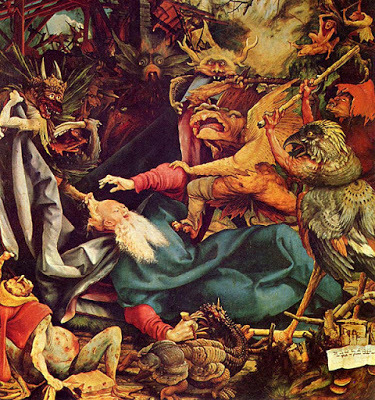
Okay, we’re almost there. One week to go and it’s the scariest date in the calendar. Yes, Halloween is only seven days away. That’s relevant to today’s blog for a couple of reasons. First of all, it means that I’ve only got two more of my GALLERIES OF DARKNESS to post. Today’s will be the fourth, while the fifth and final one will appear on October 31 itself. As always, there’re some some cracking if terrifying images here. All you need to do is scoot on down the column and check them out.
The second reason is because I’m now giving you a week’s advance warning that on the evening of October 31, I’ll be at Waterstones, Kendal, partaking in HORROR STORIES FOR HALLOWEEN. More about that shortly, as well.
In addition this week, and again because we are now encroaching on the spookiest night of the year, I’ll be reviewing and discussing the engrossing horror anthology, NEW FEARS, as edited by Mark Morris.
If you’re only here for the NEW FEARS chat, no problem. Just zoom on down to the lower end of today’s blog, which is where I usually post my book-talk, and get on with it straight away. However, if you’re interested in other things I might have to say, I’m going to talk a little bit first about …
Halloween Night, Kendal style
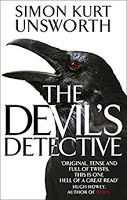 As previously mentioned, it’s official title will be
HORROR STORIES FOR HALLOWEEN
, and I’m very honoured to have been asked to participate in what looks like it’ll be an awful lot of fun, especially as I won’t be the only writer there. I’m delighted to be in the company of Simon Kurt Unsworth, author of, among other titles,
THE DEVIL
’S DETECTIVE
and
THE DEVIL’S EVIDENCE
, and Ray Cluley, author of
WATER FOR DROWNING
and PROBABLY MONSTERS.
As previously mentioned, it’s official title will be
HORROR STORIES FOR HALLOWEEN
, and I’m very honoured to have been asked to participate in what looks like it’ll be an awful lot of fun, especially as I won’t be the only writer there. I’m delighted to be in the company of Simon Kurt Unsworth, author of, among other titles,
THE DEVIL
’S DETECTIVE
and
THE DEVIL’S EVIDENCE
, and Ray Cluley, author of
WATER FOR DROWNING
and PROBABLY MONSTERS.By the sounds of it, we’ll be kicking things off at 7pm (though the shop doors actually open at 6.30pm), and proceedings will commence with me and Messrs. Cluley and Unsworth giving a 15-minute reading each from our own work, all pieces selected for their sheer scariness, I understand. After that, there’ll be questions and answers and, if we’ve hooked enough folk with our blather, some selling and signing of books.
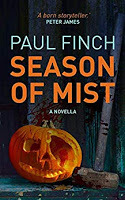 From my own point of view, the event will also be a kind of unofficial launch for my two Autumn titles,
SEASON OF MIST
and
TERROR TALES OF NORTHWEST ENGLAND
.
From my own point of view, the event will also be a kind of unofficial launch for my two Autumn titles,
SEASON OF MIST
and
TERROR TALES OF NORTHWEST ENGLAND
. I’m hopeful that a few of my crime titles will be there as well; they are pretty dark, verging on horror in many cases, so I don’t think they’ll be inappropriate for Halloween Night. The other guys’ works will also be on sale of course.
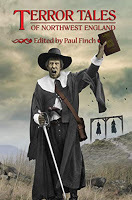 So, if you’re interested in this kind of thing, there’ll be lots of books to buy and get signed. If you live in the vicinity of Kendal – Cumbria, Westmorland or Lancashire – this is undoubtedly one that you won’t want to miss.
So, if you’re interested in this kind of thing, there’ll be lots of books to buy and get signed. If you live in the vicinity of Kendal – Cumbria, Westmorland or Lancashire – this is undoubtedly one that you won’t want to miss. Just follow the links for more details and, if you decide you’re keen, make sure to get yourself down there for 7pm.
And now, in keeping with the season …
Images of Darkness
Hopefully, regular visitors to this page will now be aware that all through October, in recognition of the approaching date, I’ve been posting galleries of artists who’ve dabbled in the darkness. In short, each Thursday, I’ve focussed on 20 painters, illustrators and the like who have shared some of their deepest nightmares with us, the idea being that when the final gallery goes up on October 31, we’ll have checked out 100 in total.
A quick bit of info before you dive in. Despite my enthusiasm, I’m not qualified to talk in detail about any of these men and women. So, I’m going to let the pictures do the talking. However, what I will say is that most of them are contemporary. I mean, there’ve been some great images of horror painted in the long-ago past; check out The Temptation of St Anthony by Matthias Grunewald (1516) at the top of today’s blog. But those are mostly well known already. By focussing on more recent practitioners, I’m hopeful there’ll be something a bit new here for everyone.
But if you want further detail on any of these individuals. And if you want to enquire about prints, originals, commissions and the like, I’ve posted links wherever possible. Just follow those; some will take you to the artists themselves.
And now my customary last-minute warning.
I’ve not selected any image that I consider to be offensive or plain disgusting. But these pictures were chosen because of their power to disturb and terrify, and the immensely talented individuals responsible for them do NOT hold back. Those of a nervous disposition should tread warily from here in …
1. KEN CURRIE
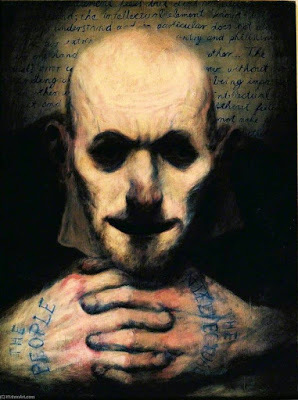
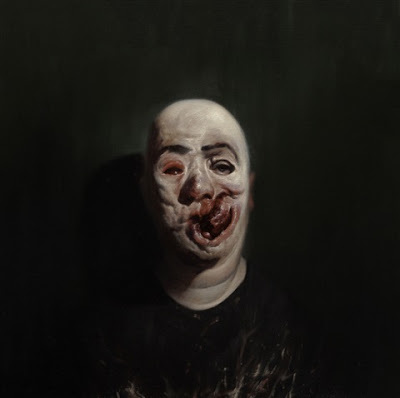
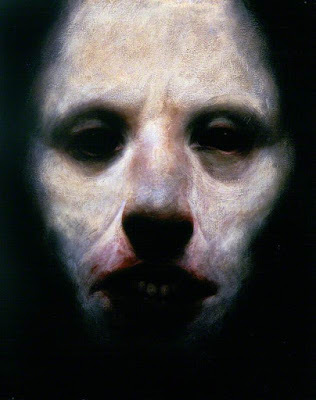
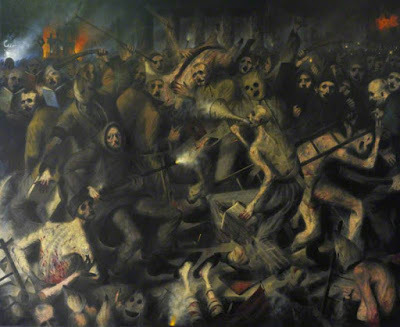
2. STEVE UPHAM
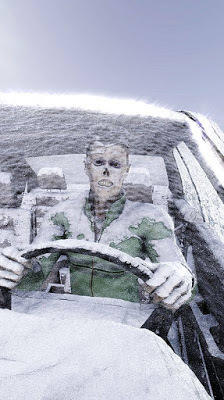
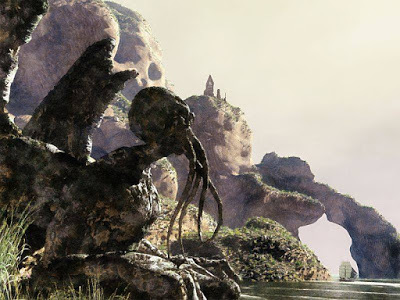
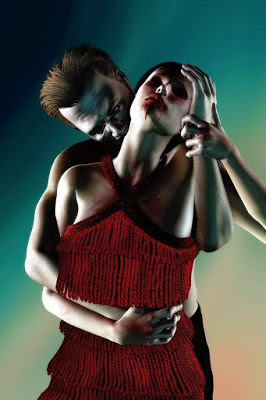
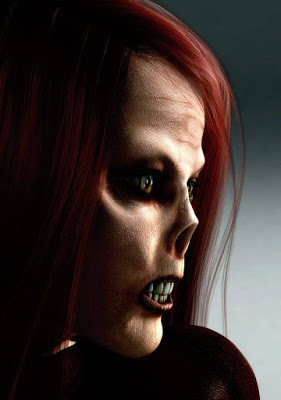
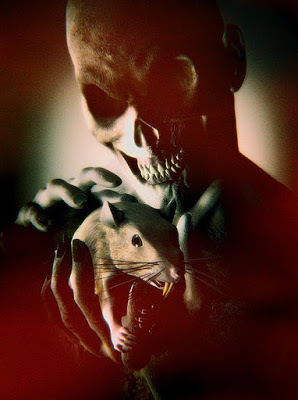
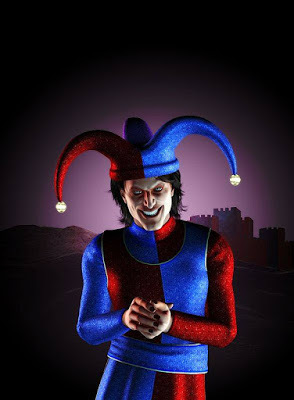
3. CLEON PETERSON
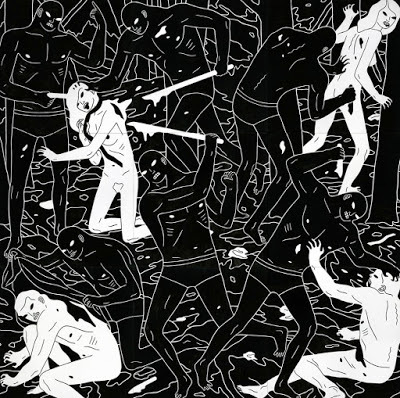
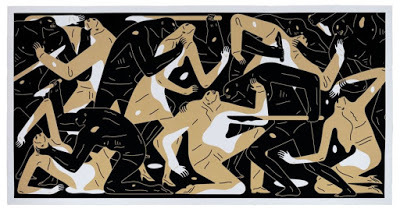
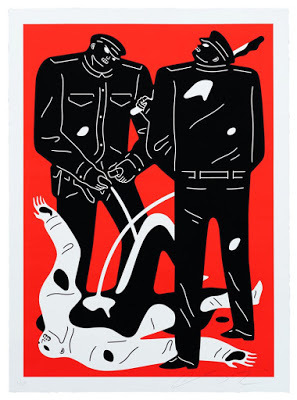
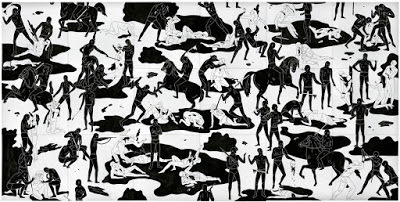
4. BACIUS9
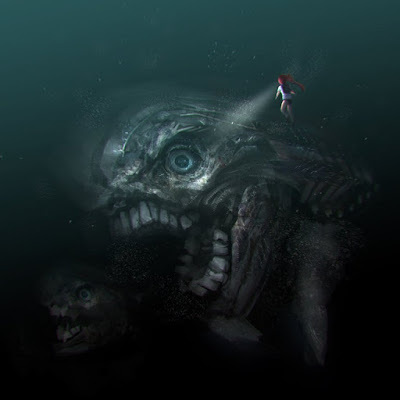
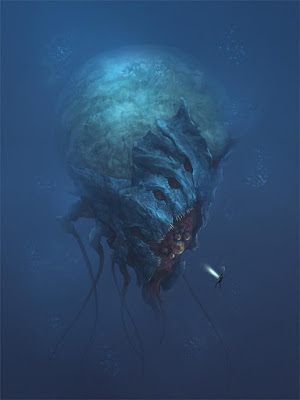

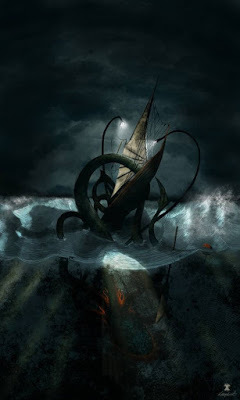
5. KIM MYATT
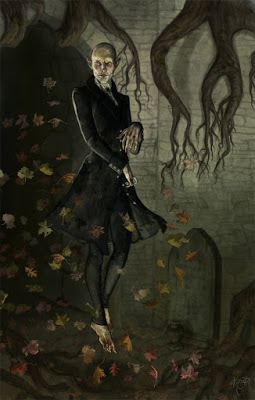
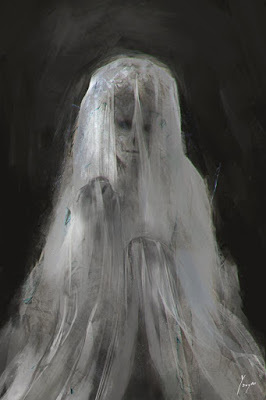

6. DAVE CORREIA
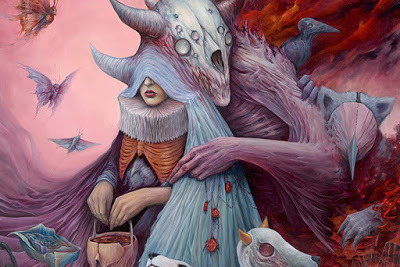
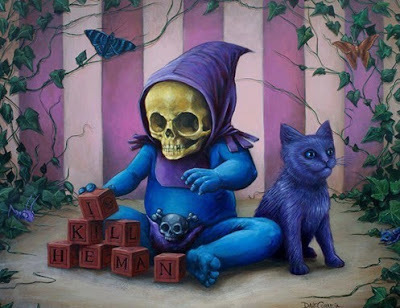
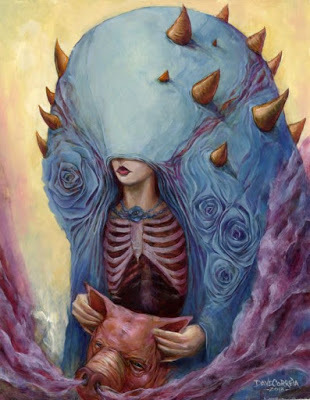
7. DAVE CULBERTSON
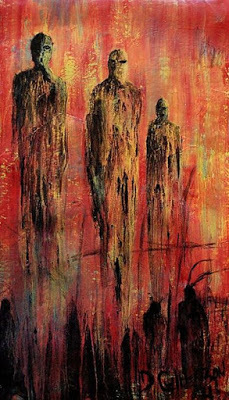

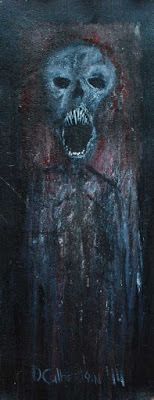
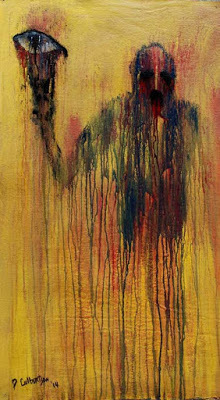
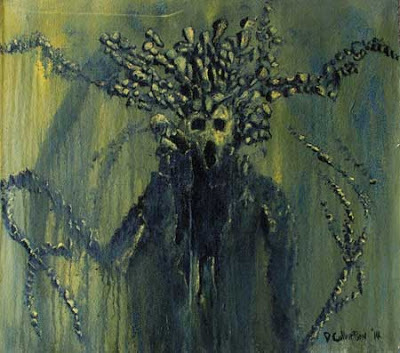
8. LEO PLAW
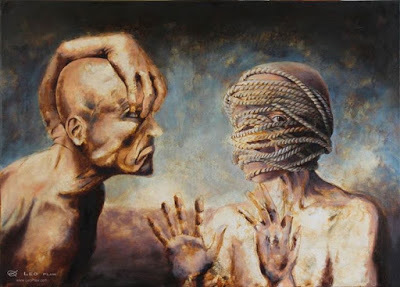
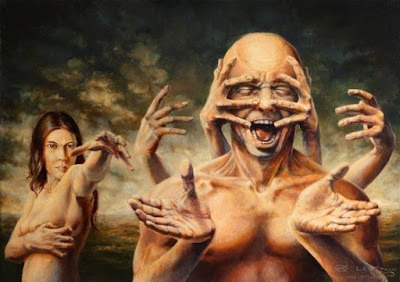
9. MARK MADDOX
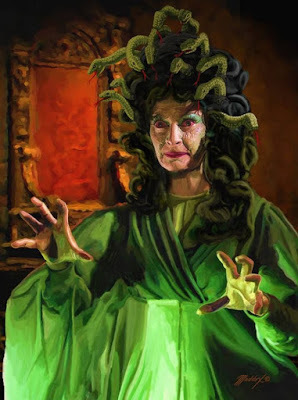
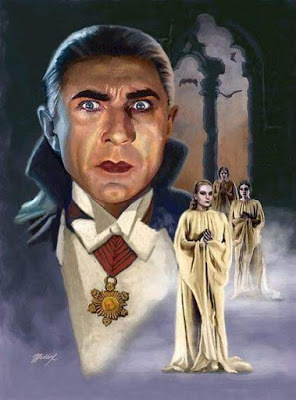
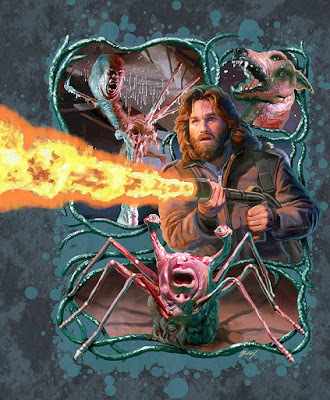
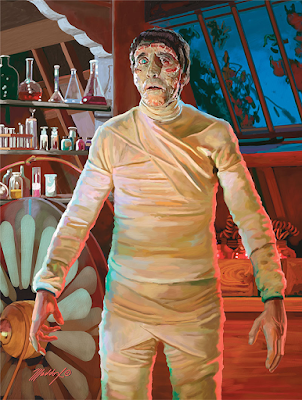
10. MICHAEL HUTTER
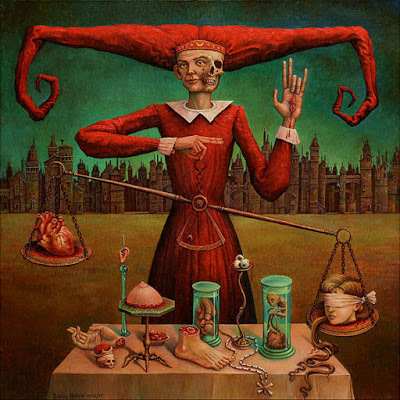
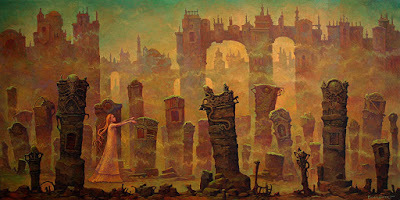
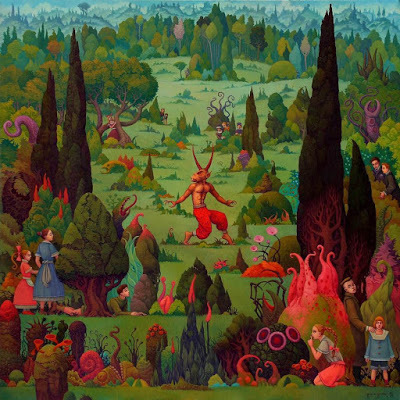
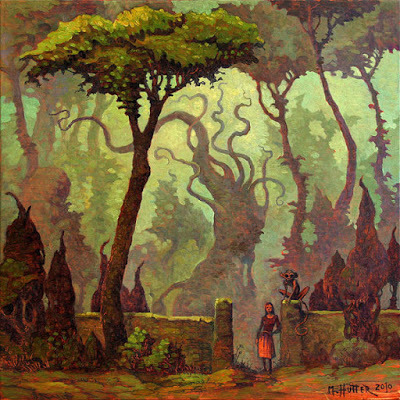
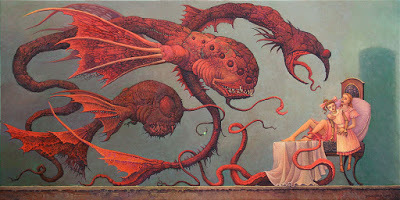
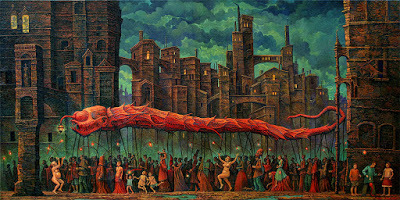
11. DADO
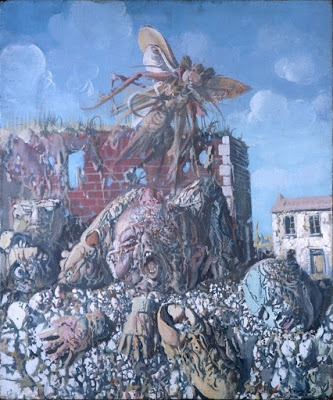
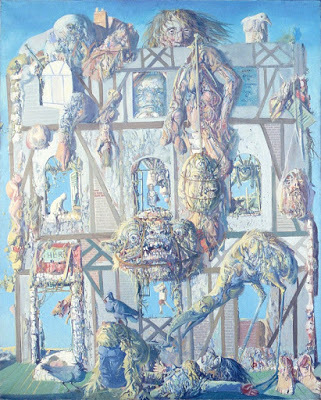
12. BORJA GUILLOT
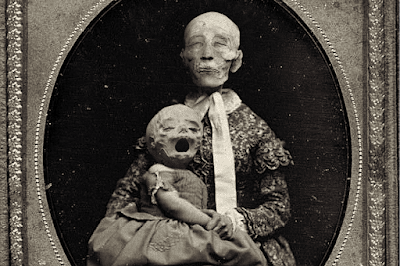
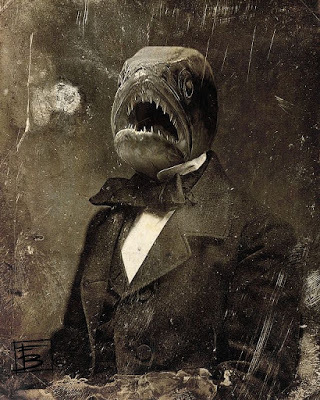
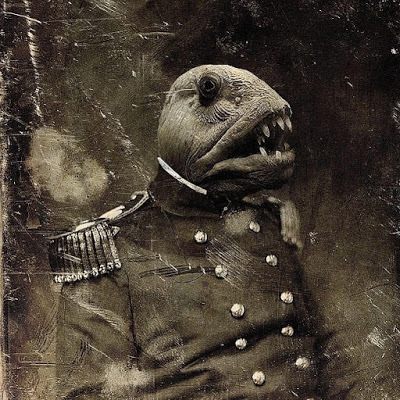
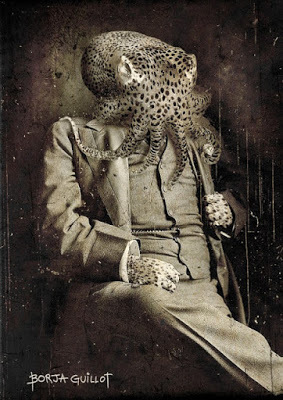
13. EMILE NOLDE

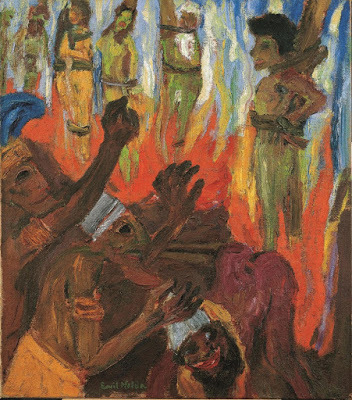
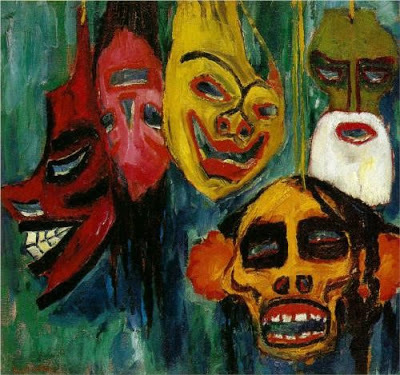
14. ERIC LACOMBE
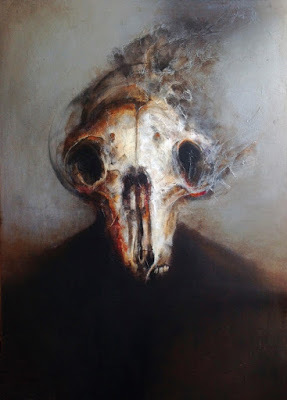
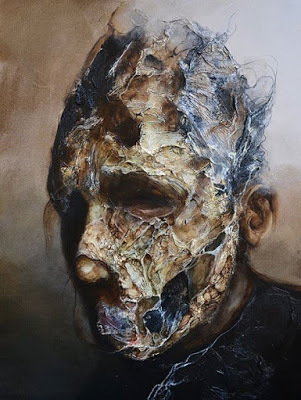
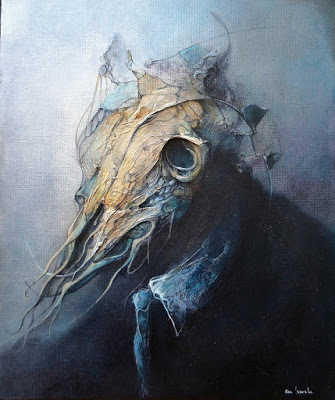
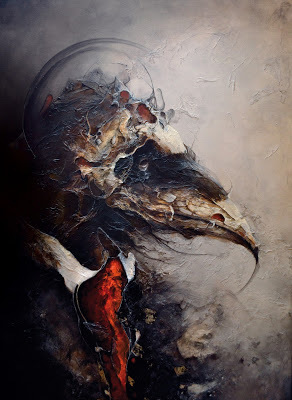
15. VALERA LUTFULLINA
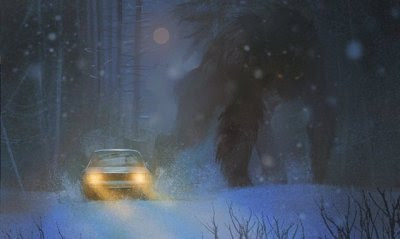

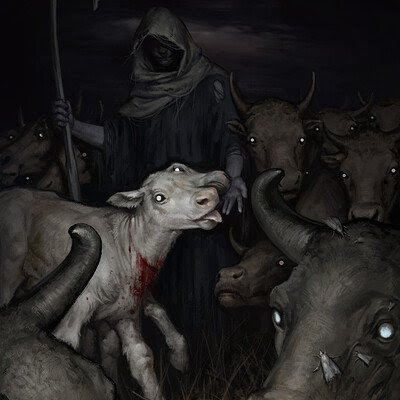
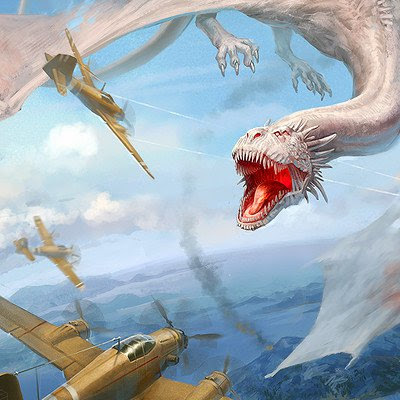
16. ZDZISLAW BEKSINSKI
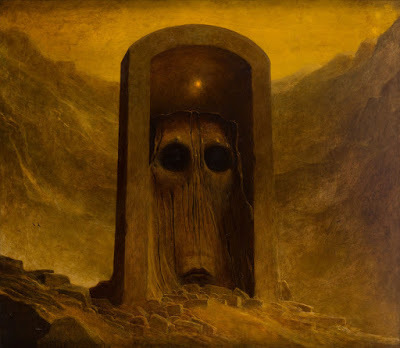
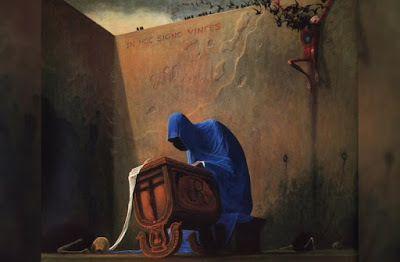
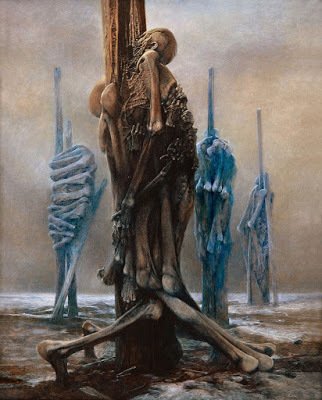
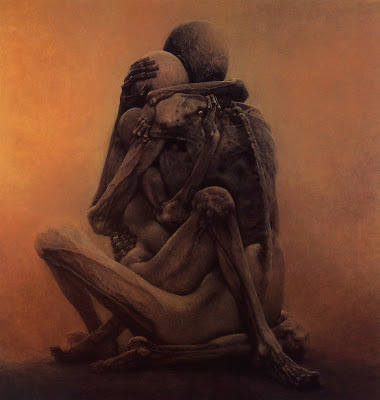
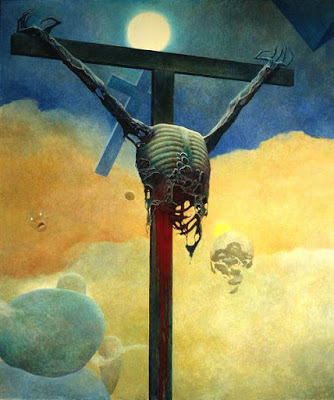
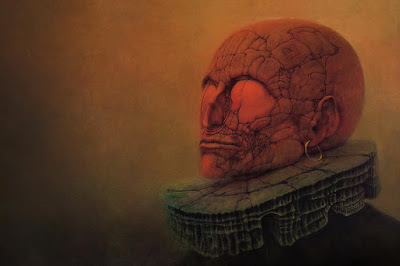
17. ALEX KONSTAD
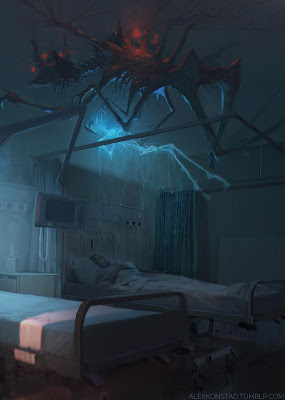
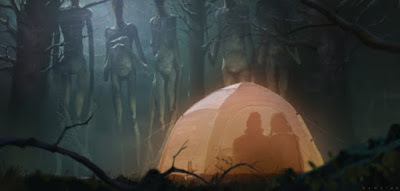
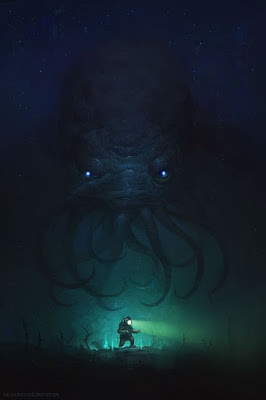
18. ANNA PAVLEEVA
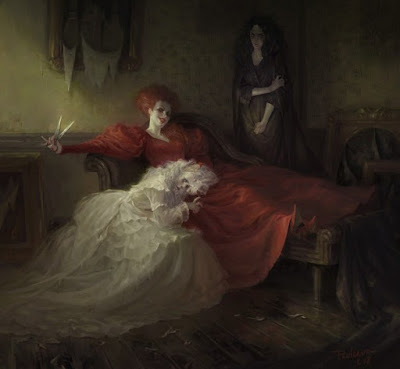
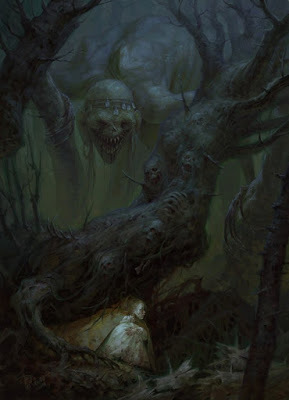
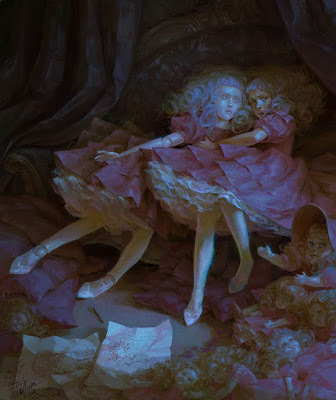
19. PAUL GUSTAV DORE
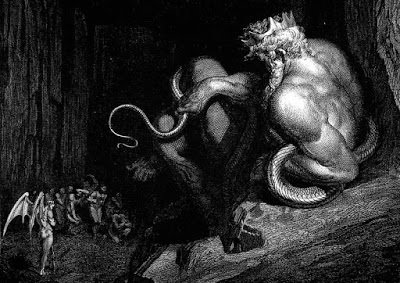
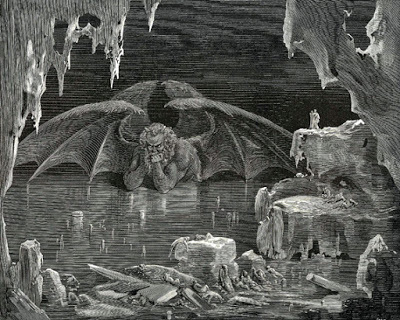
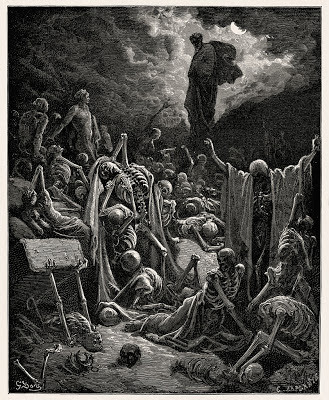
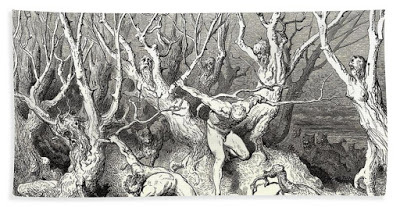
20. GLENN CHADBOURNE
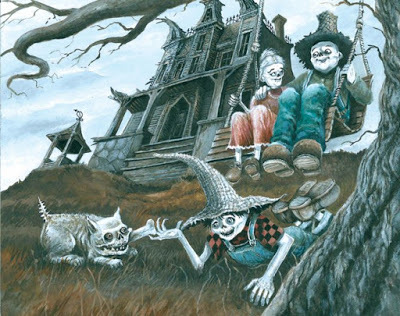
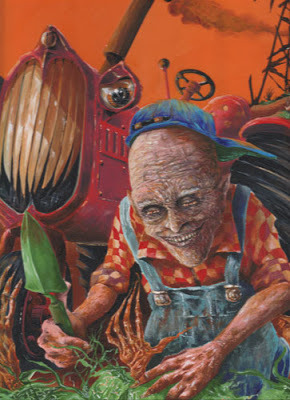

THRILLERS, CHILLERS, SHOCKERS AND KILLERS …
An ongoing series of reviews of dark fiction (crime, thriller, horror and sci-fi) – both old and new – that I have recently read and enjoyed. I’ll endeavour to keep the SPOILERS to a minimum; there will certainly be no given-away denouements or exposed twists-in-the-tail, but by the definition of the word ‘review’, I’m going to be talking about these books in more than just thumbnail detail, extolling the aspects that I particularly enjoyed … so I guess if you’d rather not know anything at all about these pieces of work in advance of reading them yourself, then these particular posts will not be your thing.
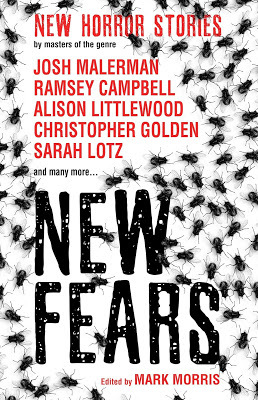 NEW FEARS edited by Mark Morris (2017)
NEW FEARS edited by Mark Morris (2017)The first volume in a sadly short-lived series of horror anthologies from Titan, in which editor Mark Morris attempts to bring together a wide range of original and contemporary scary fiction, and for the most part is very successful.
There would only be one other in the series, New Fears 2 , which we’ll review at a later date, but that’s a sad story in itself because the quality of writing on display here indicates that the New Fears project could have gone on to make a big and prolonged impact in the world of short spooky stories.
First of all, rather than simply hit you with a succession of brief short story outlines, I’ll let the publishers of this first volume give you their own official blurb, which neatly lays out the varied and cerebral chills in wait for you:
The horror genre’s greatest living practitioners drag our darkest fears kicking and screaming into the light in this collection of nineteen brand-new stories. In ‘The Boggle Hole’ by Alison Littlewood an ancient folk tale leads to irrevocable loss. In Josh Malerman’s ‘The House of the Head’ a dollhouse becomes the focus for an incident both violent and inexplicable. And in ‘Speaking Still’ Ramsey Campbell suggests that beyond death there may be far worse things waiting than we can ever imagine...
It seems like aeons since non-themed horror anthologies were a regular fixture on our British bookshelves. The golden age of such appears to have been the 1960s, ’70s and ’80s, when Pan and Fontana each brought out an annual volume, their two series eventually running to 30 and 17 books respectively and introducing a whole host of new talent to the scare fare spectrum. With the supposed change in reading fashions since then – which dubious proposition is a whole new blog on its own! – it’s become increasingly difficult for professional publishers to sell collections of original short horror fiction (or so they’ve convinced themselves), so the onus has fallen on the independent market to keep the flag flying, and though a wide range of smaller imprints have done a heroic job, much of their output has sadly flown way under the public radar. Every so often, however, a new title emerges with serious mass-market potential.
The New Fears project was certainly one of these, especially as it had Mark Morris at the editorial helm, a skilled and experienced horror and fantasy author in his own right. Unfortunately, as I’ve already mentioned, such hopes would be unfulfilled, the series only hitting us with two volumes before folding. However, if nothing else, that gives us another two book-loads of intriguing and chilling fiction from the multinational pens of some of the genre’s most exciting names: from some of the all-time old reliables like Stephen Gallagher, Ramsey Campbell and Stephen Laws to relative newcomers like A.K. Benedict, Sarah Lotz and Josh Malerman.
As you’d expect with such a wide range of voices, we get an eclectic procession of stories, the editor consciously and wisely, in my view, looking to draw in every aspect of the current horror scene, though he eschews anything that I’d describe as gratuitous or extreme.
Possibly the most gruesome tale in the book is Brian Keene’s Sheltered in Place , which, as it concerns a mass shooting at an airport baggage-handling depot, horrifyingly underlines a big issue that is currently causing arguments and disputes all across North America today. A less serious tale, though no less blood-soaked, is Stephen Laws’ The Swan Dive , in which a potential suicide is rescued in mid-fall from the Tyne Bridge by a mysterious winged being called Swan, who takes him on a wild, carnage-strewn journey of revenge across the whole wretched city.
Meanwhile, macabre rather than gory – and perhaps an heir to some of those Pan Horror contributions that I referenced earlier – is Sarah Lotz’s mischievous The Embarrassment of Dead Grandmothers , in which young Stephen takes his obnoxious grandma to the theatre, only for the old lady to die half way through the performance, a fact Stephen must conceal when he notices that good-looking Liz from work is also in the audience and chatting her up becomes a higher priority. Also cut from the old Pan Horror cloth, and one of the best and most unsettling stories in the book for my money (with a real jolt of a twist), is Kathryn Ptacek’s Dollies , in which a disturbed child names all her dolls Elizabeth, every so often inexplicably pronouncing that one of them has died from smallpox and placing it on a dusty old shelf. Her parents struggle with this weirdness, but then their daughter is raped, and a real baby is suddenly on the way, and yet again, it seems, the child will be called Elizabeth.
In sharp contrast, subtlety is the order of play with several other contributions. First off, Alison Littlewood delivers an excellent low-key study of a relationship undermined by the merest hint of supernatural evil in The Boggle Hole , while in Nina Allan’s soulful and rather literary Four Abstracts , an art historian travels to an isolated Devonshire cottage, where she must sort out a deceased artist’s various unsold paintings, only to learn that the former occupant had an unhealthy obsession with spiders.
While these stories, and others like them, disconcert you with their restraint, others revel in full-on Gothic horror of the old school.
The best example is surely Angela Slatter’s No Good Deed , (apparently a continuation of a longer narrative, which commenced in a different publication, though it can easily be read as a stand-alone), in which a medieval bride awakens in the tomb where her scheming husband has interred her, having poisoned her and mistaken her for dead, and yet, with the aid of the previous bride, whom he successfully murdered, escapes and plots her revenge. Also on the ghost story trail, AK Benedict’s Departures sees an alcoholic literally enter the Last Chance Saloon in the form of a depressing airport pub where those not yet supposed to have died find themselves gathered. Perhaps a more traditional supernatural chiller is The Salter Collection by Brian Lillie, which sees the ramblings of a deranged logging magnate, as captured on a collection of wax cylinders, reveal a terrible secret.
All that said, there are three particular stories in here that I found especially spooky.
The first two come from Ramsey Campbell and Muriel Gray – Speaking Still and Roundabout respectively – but more about those two later in this review.
The other one is Josh Malerman’s The House of the Head , which is hugely original as well as chilling, and concerns a child’s love for her lavish new doll’s house, only for her to one day notice that a broken doll has infiltrated the happy home, a ghost doll she realises, which is the prelude to a miniature but very alarming (if pint-sized) haunting.
I wouldn’t say that any of the stories in this collection, and there are 19 in total, are genuinely terrifying, at least not in as much as they caused me to lose sleep. However, they are mostly dark and disturbing, and in all cases the quality of the writing shines through. This may officially be a horror collection, but it’s also of strong literary interest. I drew specific attention to Nina Allan’s story in that regard, but nearly all the rest of the stories are exquisitely crafted and make for an all-round excellent reading experience.
And now …
NEW FEARS – the movie.
Just a bit of fun, this part. No film maker has optioned this book yet (as far as I’m aware), but here are my thoughts on how they should proceed, if they do.
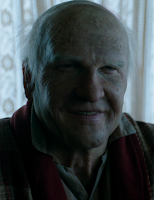 Note: these four stories are NOT the ones I necessarily consider to be the best in the book, but these are the four I perceive as most filmic and most right for adaptation in a compendium horror. Of course, no such horror film can happen without a central thread, and this is where you guys, the audience, come in. It could be that each segment is an unsolved paranormal case, as handed by one retired and decrepit investigator to a young up-n-comer (al la Ghost Stories), or perhaps they are tales told by a group of travellers who become lost in an underground catacomb and are then confronted by a mysterious monk (a la Tales from the Crypt). But basically, it’s up to you.
Note: these four stories are NOT the ones I necessarily consider to be the best in the book, but these are the four I perceive as most filmic and most right for adaptation in a compendium horror. Of course, no such horror film can happen without a central thread, and this is where you guys, the audience, come in. It could be that each segment is an unsolved paranormal case, as handed by one retired and decrepit investigator to a young up-n-comer (al la Ghost Stories), or perhaps they are tales told by a group of travellers who become lost in an underground catacomb and are then confronted by a mysterious monk (a la Tales from the Crypt). But basically, it’s up to you.Without further messing about, here are the stories and the casts I would choose:
Speaking Still (by Ramsey Campbell):
Recently made widower, Daniel, is convinced that his deceased wife, Dorothy, is leaving phone messages from the afterlife. Close friend, Bill, is very concerned because this clearly isn’t a happy afterlife. Dorothy’s late mother was a dangerous schizophrenic, who so resented being committed that she promised her daughter that she’d be waiting with vengeance after death. Now it seems that this has happened …
Bill – Bill NighyDaniel – Jim Carter
Eumenides – The Benevolent Ladies (by Adam LG Nevill):
Stuck in a dead-end job in a boring Midlands town, Jason is amazed when aloof but sexy Electra agrees to go on a date with him. The only trouble is that she wants to visit the local zoo, which has been derelict for years and has a very dark history …
Jason – Russell ToveyElectra – Genevieve Gaunt
The Abduction Door (by Christopher Golden):
An urban legend becomes real when a child disappears through ‘the Abduction Door’, a mysterious and diminutive hatchway, which comes and goes in the city’s elevators. Her distraught father attempts to follow her, and finds himself in a nightmare world of human-sized ovens and living scarecrows …
The Mother (because our leads can’t all be male) – Katheryn Winnick
Roundabout (by Muriel Gray):
A stubborn council workman is determined to clear ‘the Dark Thing’ off the overgrown Blowbarton roundabout. This mysterious, elusive something has been there ever since a bizarre piece of art rescued from the Afghan desert and erected as an anti-colonialist symbol was removed for distracting motorists. But the intrepid worker doesn’t know what it is or what terrible power his mysterious adversary possesses …
Workman – Paul WhitehouseArtist – Tim Roth
Published on October 23, 2019 23:49
October 17, 2019
Galleries of Darkness, for October - Week 3
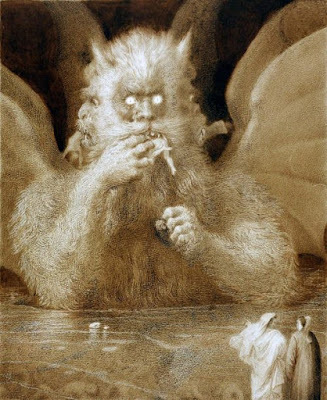
Okay, it’s now Week 3 of my OCTOBER GALLERIES OF DARKNESS, and judging from the responses I’m getting on Facebook and Twitter so far, most people seem to approve. This week again, I’ll be focussing on 20 more artists – painters, book illustrators, game designers etc – who’ve made their nightmares so vivid and real that the rest of us can be enjoy them (or be terrified by them) just as much.
On top of that, because it’s still October and the focus remains on extreme darkness, I’ll be reviewing and discussing in my usual forensic detail THE ICE LANDS by Steinar Bragi. This is a very strange and disturbing novel, my first actual venture into Nordic Horror (as opposed to Nordic Noir), and in truth was unlike anything I’d ever read before. I thoroughly enjoyed reviewing it, though it was undoubtedly a challenge.
If you’ve only popped in for THE ICE LANDS review, you can locate it, as usual, at the lower end of today’s blogpost. Hurtle on down there and immerse yourself in it straight away. On the other hand, if you’re in no rush, here are a couple of other things that might be to your liking. Not just our latest Gallery of Darkness – you’ll find that in due course – but this as well …
Darkness in the heart of Wigan
After a strap-line like that you may indeed wonder what I’m about to discuss with you. Well, it’s at least as exciting as it sounds.
Basically, for the third year on the trot, I’m honoured to have been asked to participate in WIGAN NOIR at the Old Courts Courtroom (below, right).
 Loosely, it’s part of the Noir at the Bar phenomenon, which first came over to Britain from the USA several years ago, and which sees published crime and thriller writers get up on podiums in the midst of crowded drinking-holes and read out concise chunks from their latest or forthcoming novels (just enough usually to whet the appetites of all those in attendance), and then answer a few questions from guest interviewers.
Loosely, it’s part of the Noir at the Bar phenomenon, which first came over to Britain from the USA several years ago, and which sees published crime and thriller writers get up on podiums in the midst of crowded drinking-holes and read out concise chunks from their latest or forthcoming novels (just enough usually to whet the appetites of all those in attendance), and then answer a few questions from guest interviewers.It’s become a national thing now, and thus far to date I’m flattered to have been asked to partake in these events in Carlisle, Skipton and Manchester. But it’s probably inevitable that the WIGAN NOIR events are closest to my heart, as they happen in my home-town.
Organised by fellow author, the indefatigable Malcolm Hollindrake, these have been very successful occasions thus far, often selling out well in advance. They tick all the usual boxes: the industrial or post-industrial urban atmosphere that often goes with Noir fiction, the bar-room environment, the tough prose with which the audience are invariably assailed. But also the impressive names that have so far been attracted.
This year is no different in that regard. Again, I’m honoured to be sharing a platform with such illustrious northern writers as Caroline England, RC Bridgestock, Dale Brendan Hyde and Nick Oldham.
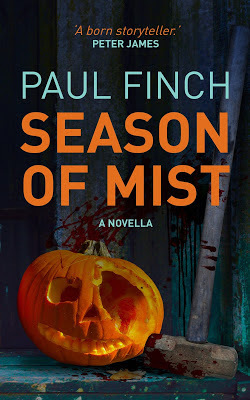 Unfortunately, I’m delivering this bit of promotion rather late in the day, as the event happens tonight at the Old Courts Courtroom in Wigan (don’t worry, there are several bars), commencing 7pm, with tickets £3 in advance or £4 on the door).
Unfortunately, I’m delivering this bit of promotion rather late in the day, as the event happens tonight at the Old Courts Courtroom in Wigan (don’t worry, there are several bars), commencing 7pm, with tickets £3 in advance or £4 on the door).For my own part, I’ll be taking the opportunity to read from my new novella, SEASON OF MIST , which sees an industrial Lancashire town in the 1970s, Ashburn, living in terror of a serial child-killer, though one particular group of youngsters are enthralled by a local legend of the autumn, which lays the blame firmly at the bloodied feet of an evil spirit called Red Clogs …
This will be a fairly apt choice, I feel, as Ashburn is basically a thinly-veiled Wigan, though it’s the Wigan of my youth – 1974 – rather than the Wigan of today. More than a few will remember it, I’m sure.
Again, I realise this is late notice, but hopefully not too late. Looking forward to seeing some of you there.
And now …
GALLERIES OF DARKNESS – Week 3
Those who’ve checked in with this blog over the last two weeks should be well aware that I’m currently in the middle of a month-long feature concerning artists (painters, illustrators, photographers and such), who have dipped into the ultimate darkness.
In short, each Thursday during October I’ll be posting a different gallery of chilling images as produced by some masters and mistresses of the visual nightmare. As I announced at the start of this month, there’ll be 100 in total, the final 20 to jar your world on Thursday October 31, a date which otherwise needs no introduction. (And even then, trust me, I’ll only have scratched the surface – there is a vast sea of wonderfully disturbing artwork out there).
We open today’s blog with the eye-popping Lucifero by Francesco Scaramuzza (was this the model for the monster in Night of the Demon , or what?). But this was drawn as part of Scaramuzza’s monumental illustration of Dante’s Divine Comedy , which took him most of the 1820s to complete, and mainly this month I’m looking to feature more contemporary works, if for no other reason than it should hopefully introduce viewers to some dark artists they perhaps haven’t heard about previously.
I make no apologies for the fact that I don’t talk about these artists in any specific or educational detail. Firstly, I’m not qualified to do that, but as you’ll see from their intricate skills and subtextual immensity, there is way more to be said and debated than I could ever fit in here anyway. However, in most cases you can follow the links, and they will lead you through to much fuller information and, sometimes, online shops for prints, originals and the like.
One final warning: I’ve chosen nothing here simply because it is revolting. To me horror is about frightening its audience not making it sick. But despite that, these maestros of the darkest arts have some pretty harrowing dreams, and when it comes to recreating them for others, they do NOT hold back.
Here we go …
1. GIUM TIO ZARRALUKI
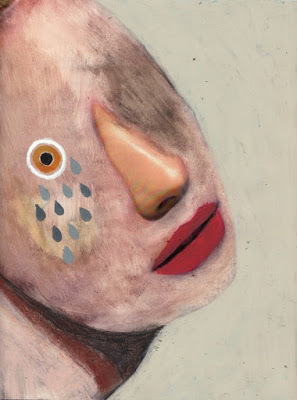

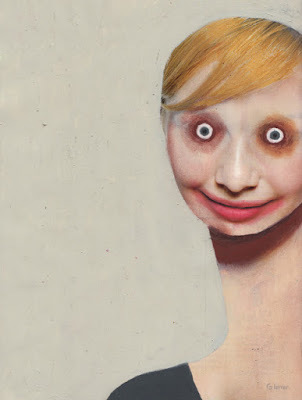
2. MAXIM VEREHIN
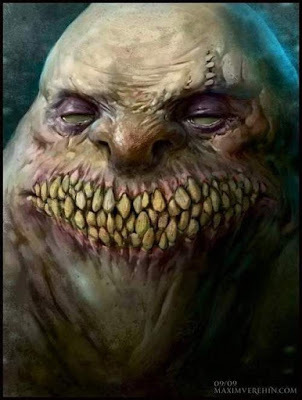
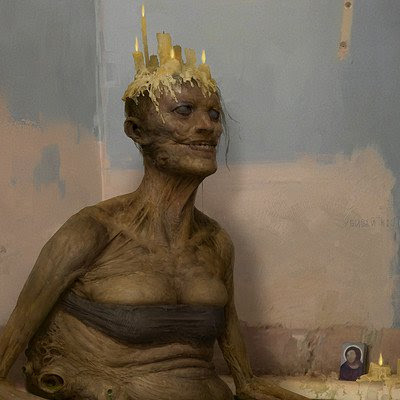
3. PLACIDO MERINO
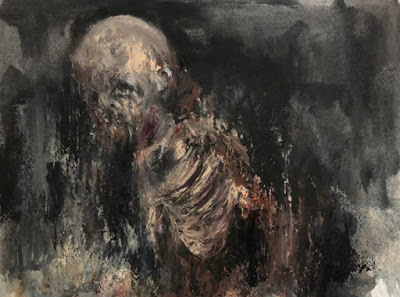
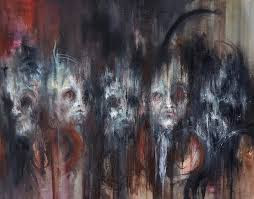
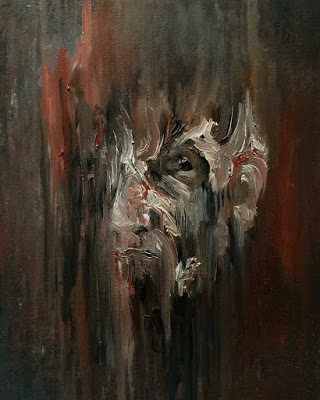
4. ZAKURO AOYAMA
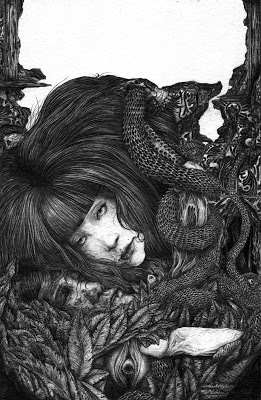
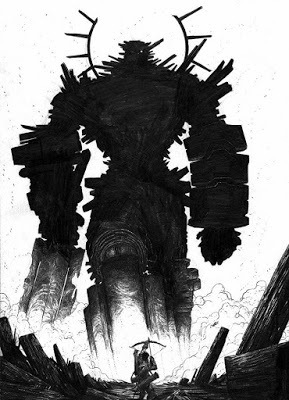
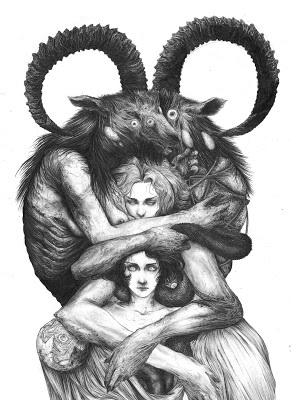
5. ANDREA KOWCH
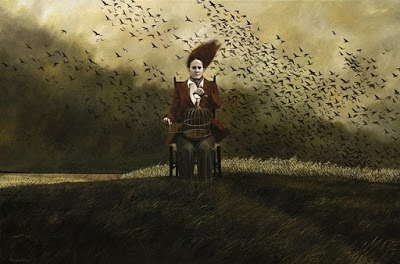
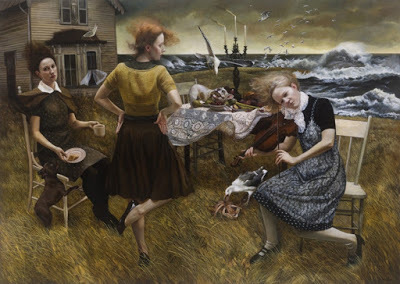
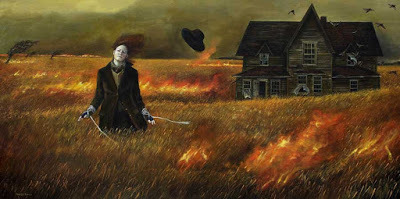
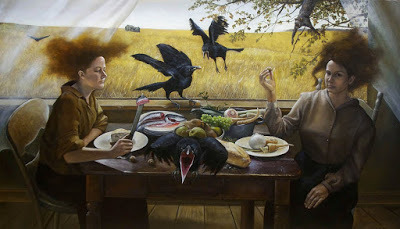
6. CHET ZAR
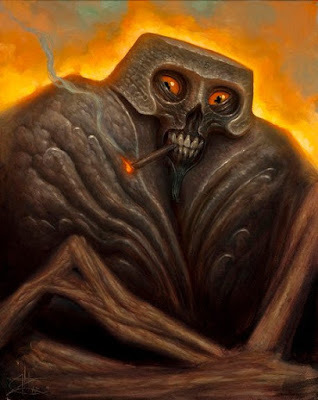
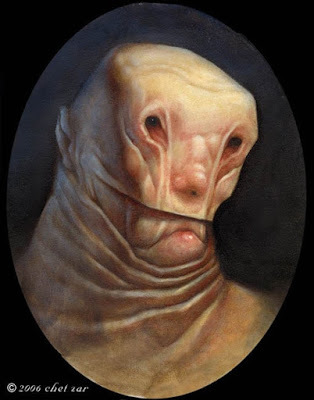

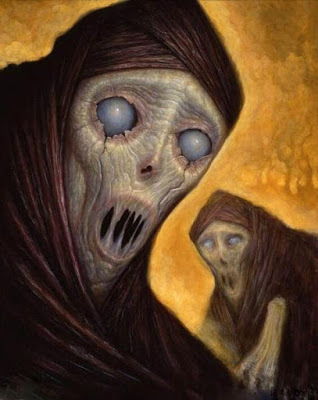
7. JAKUB ROZALSKI
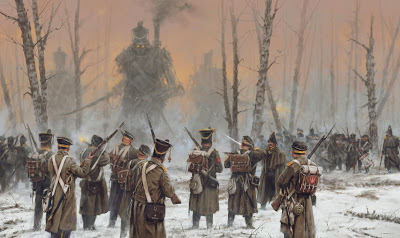
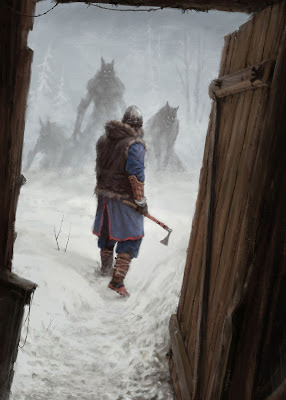
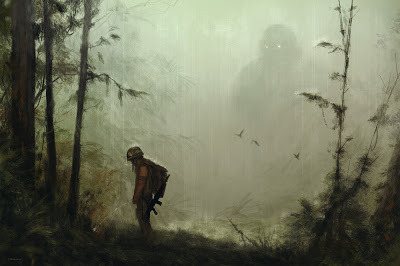
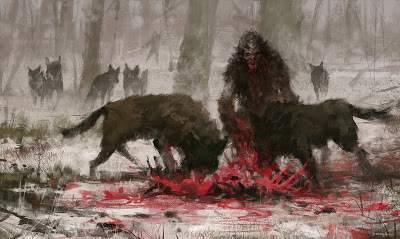
8. KEITH THOMPSON
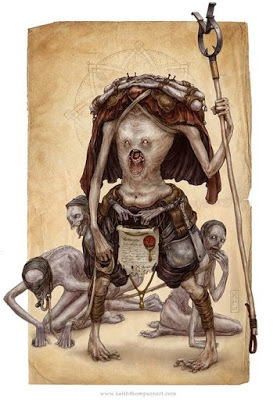
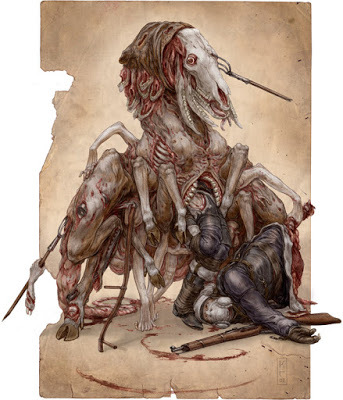
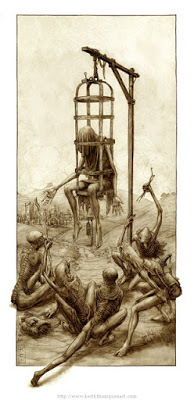
9. SABBAS APTERUS


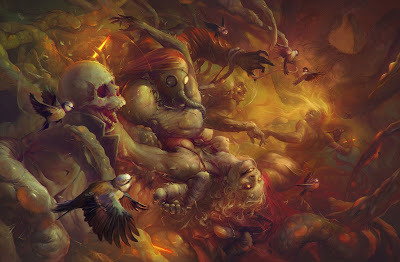
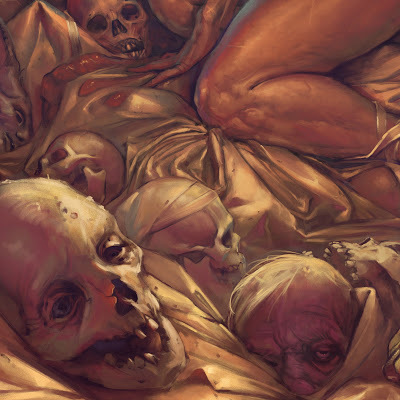
10. VALIN MATHEISS
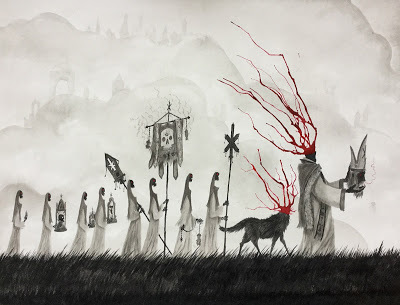
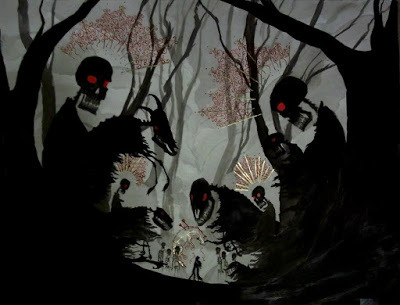

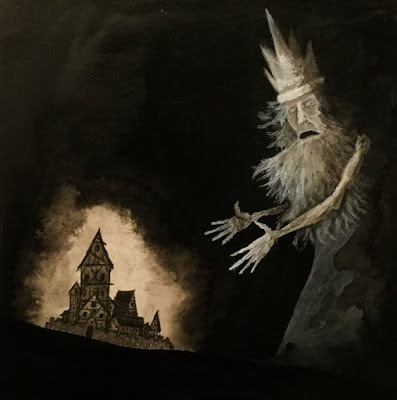
11. EDWARD GOREY
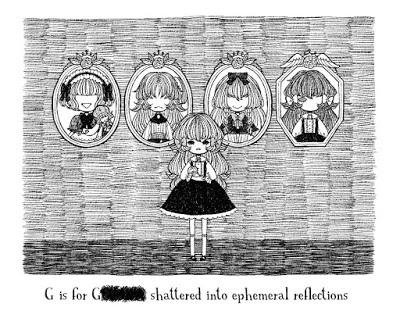

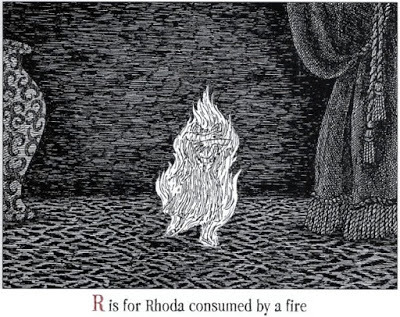
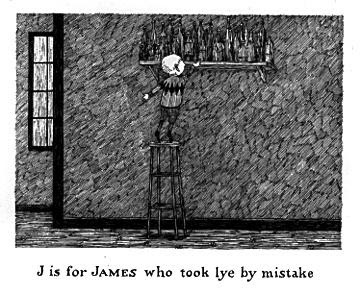
12. CHRISTIAN REX VAN MINNEN
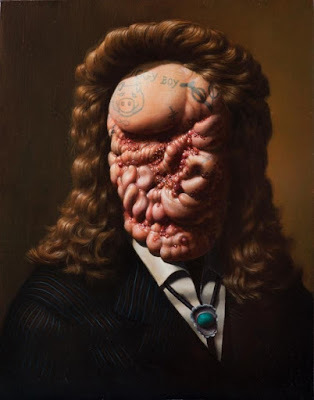
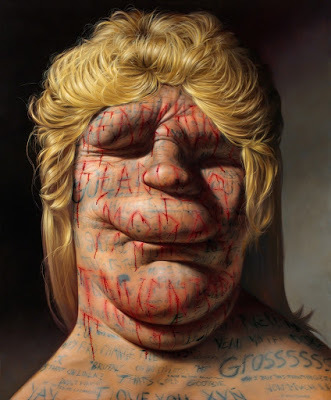
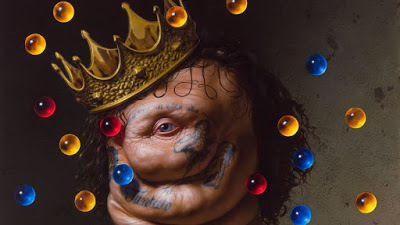
13. MICHAEL WHELAN

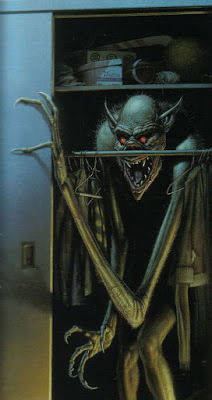
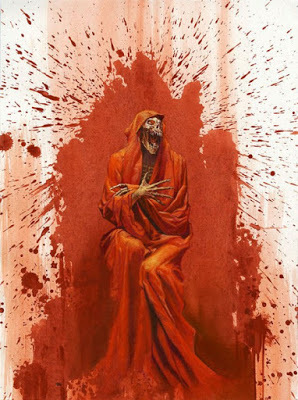
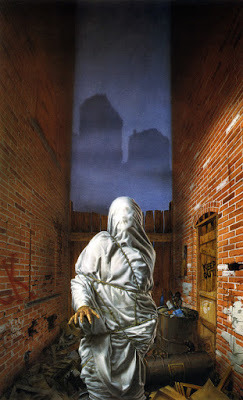
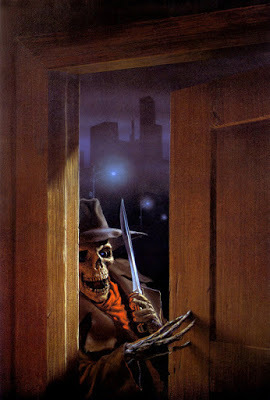
14. GELIY KORZHEV
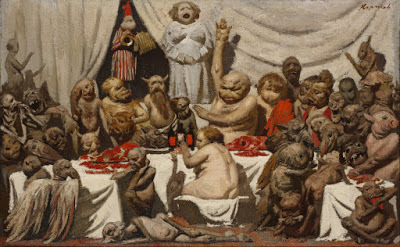

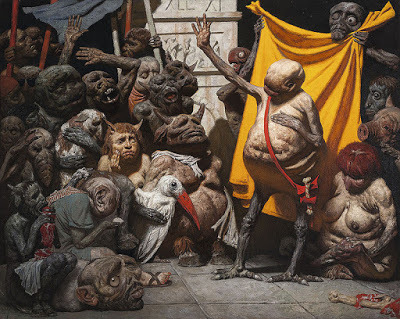
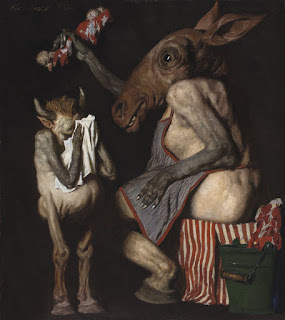
15. NEIL WILLIAMS
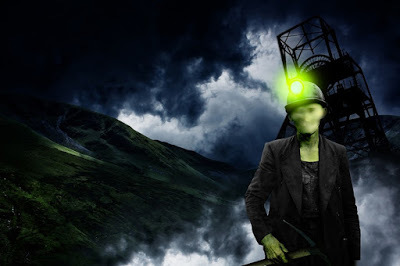
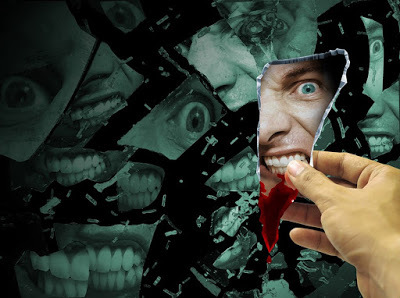
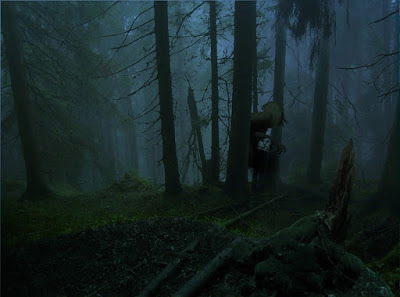
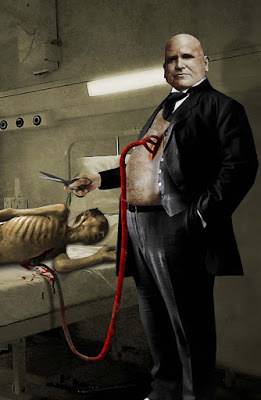
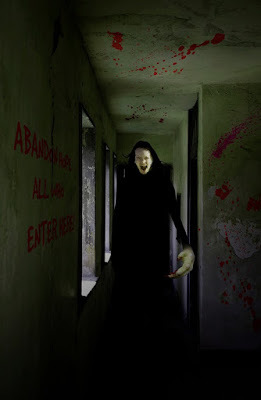
16. OTTO DIX
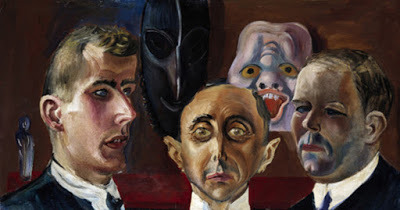

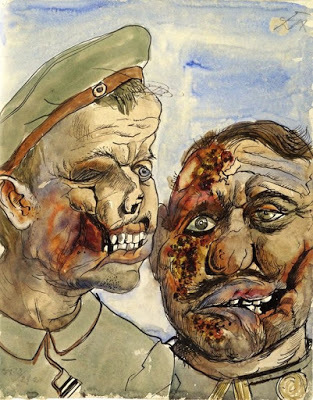
17. RAMSES MELENDEZ
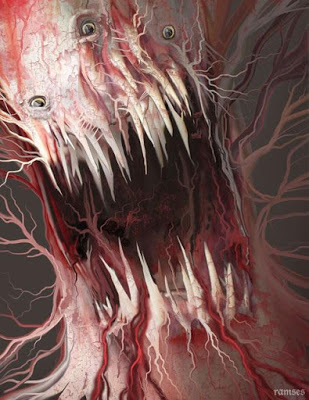
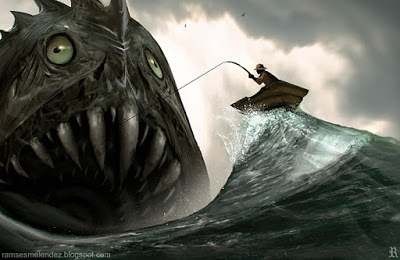
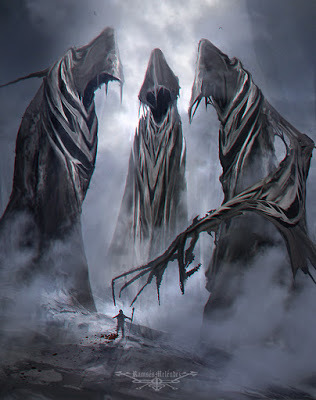
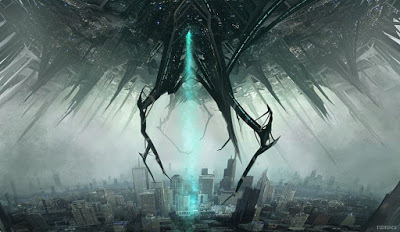
18. STEPHAN KOIDL
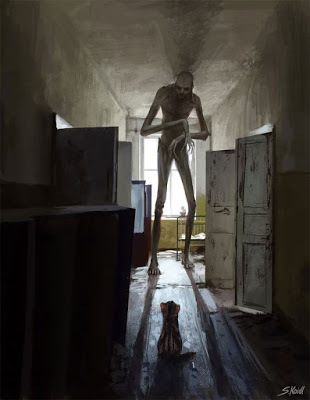
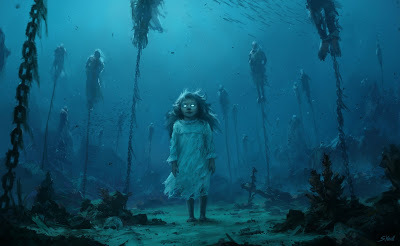
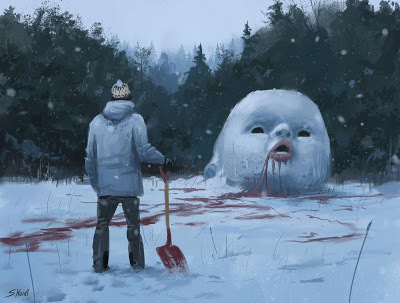

19. ESAO EDWARDS
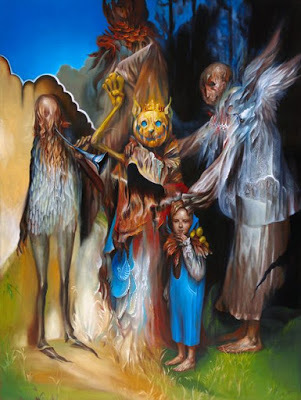
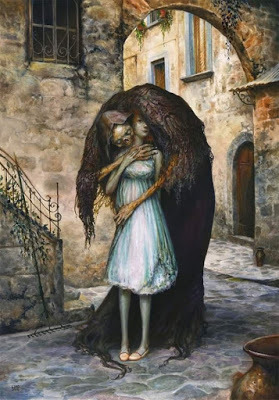
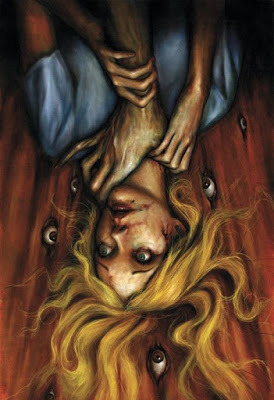
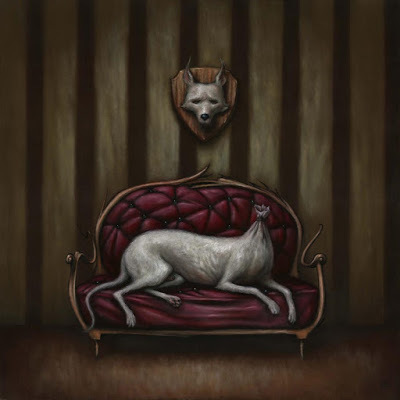
20. HARUMI HIRONAKA

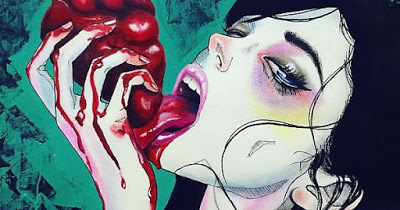

THRILLERS, CHILLERS, SHOCKERS AND KILLERS …
An ongoing series of reviews of dark fiction (crime, thriller, horror and sci-fi) – both old and new – that I have recently read and enjoyed. I’ll endeavour to keep the SPOILERS to a minimum; there will certainly be no given-away denouements or exposed twists-in-the-tail, but by the definition of the word ‘review’, I’m going to be talking about these books in more than just thumbnail detail, extolling the aspects that I particularly enjoyed … so I guess if you’d rather not know anything at all about these pieces of work in advance of reading them yourself, then these particular posts will not be your thing.
 THE ICE LANDS
THE ICE LANDS by Steinar Bragi (2011)
In the aftermath of Iceland’s financial collapse, two young couples and dyed-in-the-wool townies, Hrafn, Vigdis, Anna and Egill, ostensibly friends though there are many strains in their relationships, take a road-trip into their country’s barren, cinder-strewn interior. They have half a mind to check out the unique natural environment, and maybe photograph some glaciers while they are there, though the reality, one suspects, is that they are simply trying to escape from personal pasts that have gone badly awry.
The couples themselves are not entirely happy with each other. They have strong sexual bonds, we come to learn, but the two men, having lost money during the recent crisis, are depressed and struggling, Egill slipping into alcoholism, Hrafn trying to make up his losses by selling drugs. In contrast, the two girls, who perhaps having led worthier professional lives, were less affected by the disaster but now are required to tolerate their menfolk’s misery and cynicism.
If this isn’t difficulty enough, the road-trip itself goes chaotically wrong.
It is out in the middle of nowhere when the travellers are engulfed in an almost unnatural fog, skidding off the road, hitting the outer wall of a crude, rock-built cabin and writing their car off in the process. The cabin’s two occupants, a strange old woman and her even older and infinitely stranger husband, come out to assist and bring the shaken foursome indoors – but there is an air of panic about this, and once everyone is inside, the weird duo promptly sets about barring every door and window.
And from here, the mysteries really begin to flow.
The old couple clearly were not impoverished once but evidently are now. More to the point, their isolated farm is all but a ruin, and surely cannot provide from the arid lands surrounding it. The twosome offers a refuge for their unwilling guests, but are generally non-communicative. For example, they give no explanation for the remains of slaughtered animals which seem to litter the vicinity of their wind-battered stead. Likewise, when Hrafn, Vigdis, Anna and Egill try to get their bearings by exploring the area, they come across the remnants of a village which now lies empty and gutted, with no trace of its former occupants but a palpable air of menace; and as before, no coherent explanation is forthcoming from the elderly couple.
The stranded foursome makes several attempts to get back to civilisation, but events conspire to thwart them. Increasingly, we feel – to our incredulity – they are settling here. And this is despite the legends of the Icelandic interior, which are really quite disturbing, as harsh a terrain as you could find anywhere, nothing but rocks and dirt stretching to every horizon, and some weather from Hell, including a tumultuous and prolonged grit-storm.
Soon, they are treating the farmhouse as their own and virtually ignoring its actual owners, who, oddly, seem to accept this, though deep down, we suspect, they know something our four hapless heroes don’t. It is certainly the case that Hrafn, Vigdis, Anna and Egill spend far too much time waging their own petty wars against each other, brooding on their past failures and taking it on themselves to investigate the deep interior of the cabin – another internal wasteland! – to notice that something very unpleasant is waiting outside …
If books were to be awarded marks for strangeness, then The Ice Lands would be up there with the best of them. Because this is one weird tale, and sorry though I am to admit it, I don’t necessarily mean this in a good way.
To counter that, I wouldn’t say that I found this novel disappointing – it’s an engrossing read, centred around an intriguing mystery – but I did find it dissatisfying. That possibly owes more to the way it was sold, at least in the English language version, than it does to the author’s original intention. In what must be considered a golden age of Nordic crime thrillers, and amid a growing awareness of Nordic horror, it was maybe a bit cheeky of the various blurbsters to pitch The Ice Lands as a tale of darkness and dread. I mean, it is a tale of darkness and dread, but it’s also a lot more than that … we quickly reach the stage, for example, where the narrative itself becomes less important than its subtext.
It’s beautifully written, the awfulness of the desolate locale handsomely described. As you’d expect from a poet, Steinar Bragi can certainly create stark and lasting imagery. But despite this, and despite its enthralling opening, The Ice Lands is not so much a story about four people in peril as much as it is an assessment of Iceland, both the country and the people, and where they stand in the turbulent world of today.
First of all, we have this scenic and yet near-prehistoric landscape, an unforgiving volcanic topography on which only the toughest and most ruthless creatures could ever eke out a living. It is soulless, merciless, a directionless wilderness that seems to go on forever, an illusion (if it is an illusion!), which only intensifies under the horrific Arctic weather, which alternately freezes and fogs the tired foursome stranded in the midst of it.
If that isn’t message enough that this is potentially a bad place, this inner desert is littered with the near-unrecognisable ruins of those who didn’t make it: animals reduced to bones and carrion, human habitations so long abandoned and weather-worn that it’s impossible to tell who once lived here or why they left.
In addition, the undercurrents to all this are those terrible legends of the Scandinavian far north. Trolls, kobolds and other goblin types abound in Icelandic folklore, but you learn at an early stage in The Ice Lands that these are not the cute fairies of English back-garden tradition. Instead, they are malign powers who resent the intrusion of modern man with such venom that they will kill, kidnap and maim in response. (It’s probably worth mentioning that the folkloric references with which Steinar Bragi peppers his book are among its creepiest passages, depicting some extremes of supernatural evil, so it’s scarcely surprising that the country’s bleak interior was a region that travellers sought to avoid in earlier times).
Then, on top of this, we have our main cast, a thirty-something foursome, all of them damaged, distressed and wearied by their experience of modern urban life.
Bragi has been accused of oversimplifying things here, by opting for a crude form of political correctness. I don’t entirely agree, though I can see where the argument has come from.
Hfran and Egill, the men, are basically idiots. Having played the markets in empty-headed fashion during Iceland’s economic boom of the early 2000s, only to crash and burn during the banking collapse of 2008 – to which disaster they have responded in the most boorish way possible, Egill is now a drunk, Hrafn a criminal. It’s almost as if the author is pointing out what he considers to be a characteristic male response to a crisis: i.e. ‘If I personally must fail, then I will damage everything around me en route’. In sharp contrast, the two women, Vigdis and Anna, a journalist and a therapist respectively, are harder workers and more altruistic in their worldview – which of course would be laudable, except that neither of them seems willing or able to separate herself from her worthless other half, plus they each display their own irritating follies, and so they themselves are not beyond criticism.
Overall though, I think the book’s characterisation is the bit where, for me, The Ice Lands loses a little of its power.
Hrafn, Vigdis, Anna and Egill are cyphers or exemplars, stereotypes with a purpose rather than individual personalities. They each come with an awful lot of back-story, though this feels forced, in my view, making them more like fictional characters than real people. It doesn’t help, either, that their dialogue sounds stilted, their arguments are unconvincing, their sex scenes feel contrived and their response – or lack of such – to disturbing weirdness (not to say terrifying threats), jars badly even in a tale which is only superficially a horror story.
I wouldn’t say this killed my interest in the book, but it was something of a distraction (particularly the latter point).
All this said, it wouldn’t be true to say that there isn’t something genuinely eerie and affecting about The Ice Lands . Okay, it’s not a thriller in the conventional sense, and the events leading towards the end of the book are disconcertingly violent and horrible, even if they are a tad puzzling – I struggled to solve the mystery, unfortunately, but that may just be me – but there is something of Robert Aickman and even MR James in the actual setting. This horrible old farmhouse, with all its hidden depths, which, piece by piece, are uncovered and investigated, is deeply discomforting. Why is it here? What purpose did it ever serve in this drear wasteland? Who exactly are its frail and yet ever-watchful custodians? Why do they bar it at night? What terrible thing killed the animals outside? What about the ruined village, etc …?
You won’t need a vivid imagination to realise at an early stage that none of this is going to culminate in a happy ending.
If you’re like me, you’ll probably feel frustrated by some aspects of The Ice Lands , but you’ll also be sufficiently intrigued by all these many uncanny curiosities to stick with it to the end, and if you’re not put off by the increasing incidents of gore and are not dissuaded by an ever-greater atmosphere of approaching doom – you’ll keep going and will draw something out of it even if you’re not entirely sure what that is.
I don’t think I can confidently recommend The Ice Lands to traditionally-minded thriller or horror fans, but it’s definitely worth checking out if you prefer your fiction to come from the dark side.
It won’t be easy casting this one, as my knowledge of Scandinavian actors is not as broad as it could be, let alone my knowledge of Icelandic-born actors, so it’s fortunate this is just a bit of fun. Anyway, here we go: if The Ice Landsever makes it to film or TV, and what an interesting project that would be, here are my picks:
Hrafn - Stefán Karl StefánssonVigdis - Ágústa Eva Erlendsdóttir Anna - Anita Briem Egill - Gísli Örn Garðarsson
Published on October 17, 2019 00:55
October 10, 2019
Galleries of darkness, for October - Week 2
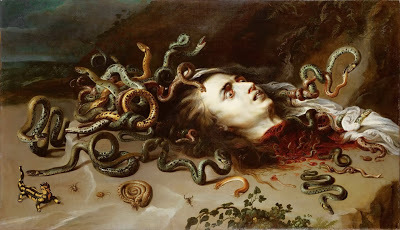
Welcome to Week 2 of my OCTOBER GALLERIES OF DARKNESS. Yet again, I’ll be looking at 20 artists – painters, book illustrators, game designers etc – who’ve hit us over the years with some truly terrifying visuals.
In addition, because the focus yet again this week is on horror, I’ll be offering another of my detailed reviews and discussions, today concerning Christopher Golden’s tale of mountain-top terror ARARAT. If you like ancient mysteries brought into the modern age, if you like the occult, if you like horn-headed demonic nightmares, then this one could definitely be for you.
If you’re only here for the ARARAT discussion, you’ll find it, as always, at the lower end of today’s blogpost. Just zoom on down and check it out. However, if you’ve got a bit more time, there are a couple of other things you might be interested in first. Not just our latest Gallery of Darkness , which you’ll find below, but this too …
TERROR TALES OF NORTHWEST ENGLAND
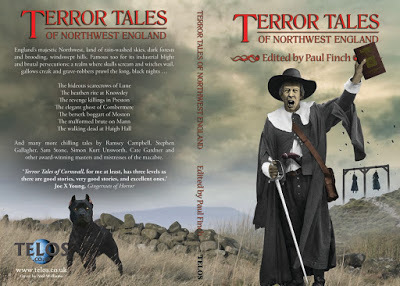
I’ve been promoting the hell out of this book for quite a while; the last six or seven months by my reckoning. But now, at last, I can happily announce that it’s available for acquisition both as ebook and paperback. Just follow the link and delve deep into the urban and rural mythology of Northwest England. That means Lancashire boggarts, Manchester monstrosities and general-purpose madness, mayhem and menace from the backstreets of Liverpool and the deceptively quiet country lanes of leafy Cheshire.
Treat yourself to some cracking horror fiction from the likes of Stephen Gallagher, Ramsey Campbell, Cate Gardner, Simon Kurt Unsworth, Sam Stone, and even my good self. Yes, though I’m always a bit pink-cheeked when it comes to self-promotion, I must admit that we close off this collection with my previously unpublished novella, The Upper Tier , which was written for and performed live at a special Ghost Story Night at Haigh Hall in Wigan, back in 2011. And yes, it’s all about that infamous haunted mansion that still sits in its own green and overgrown hinterland in the heart of a borough once notorious for its smoke and industry, and which is rightly regarded as ‘the Borley Rectory of the North’.
And now, onto the visual chills …
GALLERIES OF DARKNESS - Week Two
I won’t waste your time with a big preamble this week. Suffice to say that those who were around at the beginning of the month will remember my announcement that throughout October I’ll be treating you each Thursday to a gallery of work produced by 20 artists who have dabbled in the darkness (taking us all the way through to Halloween, and that even then, with 100 of them in total, I’d only be scratching the surface).
The painting at the top of today’s blog hails from distant antiquity, Medusa by Peter Paul Rubens (1618), though for the most part in this series I’ll be concentrating on more contemporary works, mainly because that should guarantee there’ll be a few that you’re not yet aware of.
I won’t be talking about these individual artists in any details, mostly because I’m not qualified to, but also because I haven’t got the space or time to do them justice. On this occasion, I’ll just let the pictures do the talking. But follow the links and, wherever possible, it will divert you through to the artists’ own web-pages, their online shops, etc.
Quick warning: there is nothing here that is simply disgusting; quite often it’s horror of the more sophisticated sort. But even so, these masters and mistresses of the macabre do NOT hold back.
Enjoy …
1. ADAM BURKE
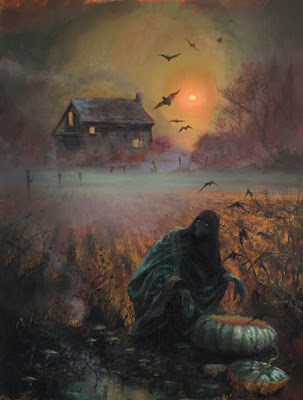
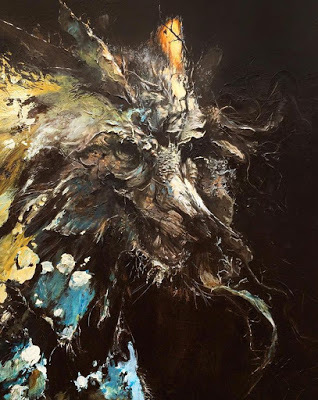
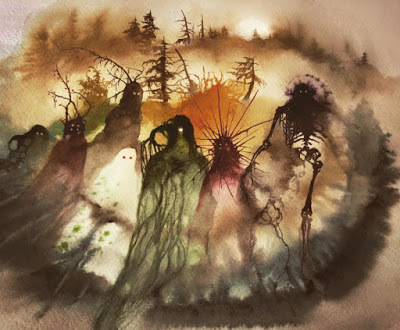
2. DAN PEACOCK
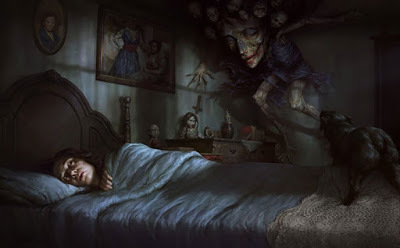
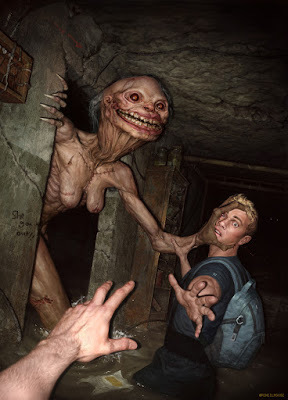
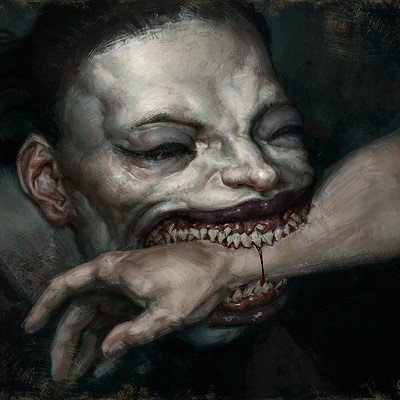
3. FRANCES CASTLE
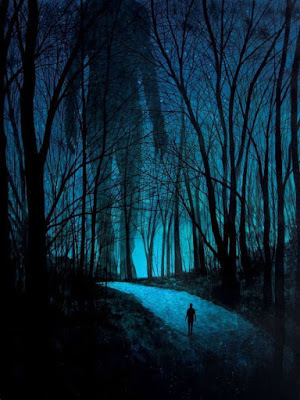
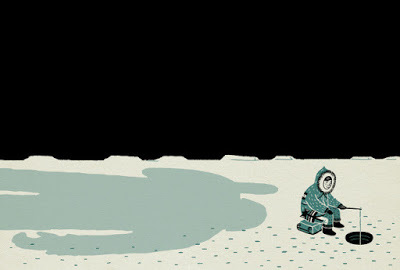
4. JAMES ENSOR
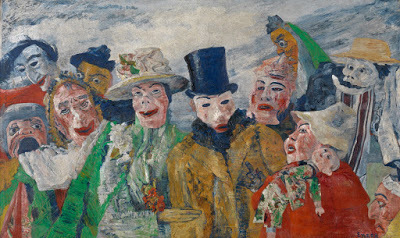
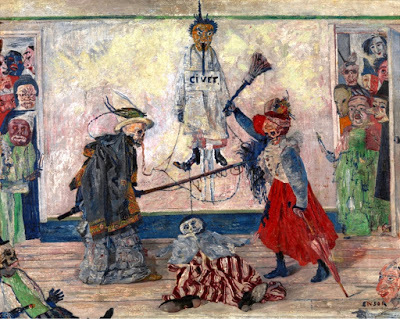
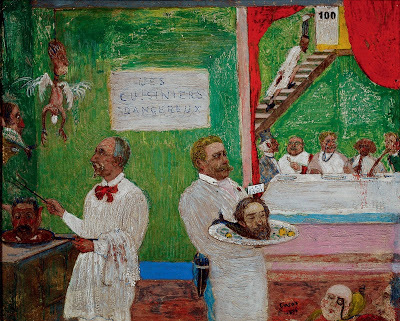
5. JOHN KENN MORTENSEN
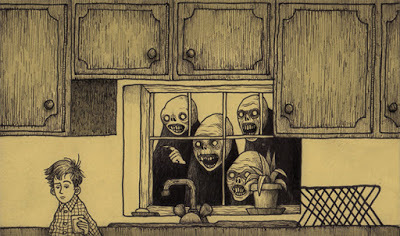
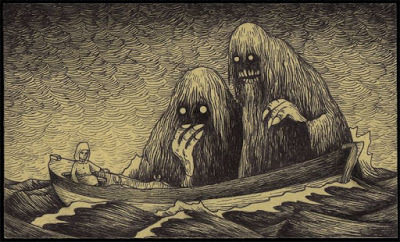
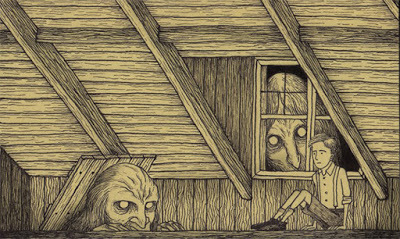
6. OLEG VDOVENKO
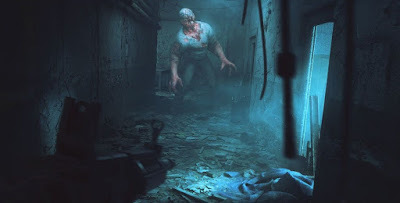
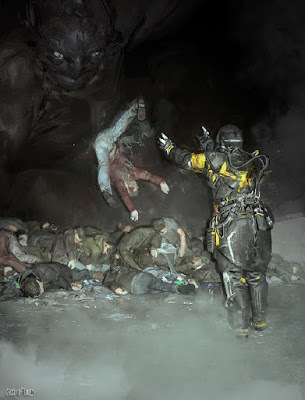
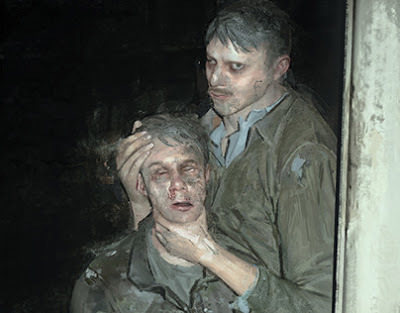
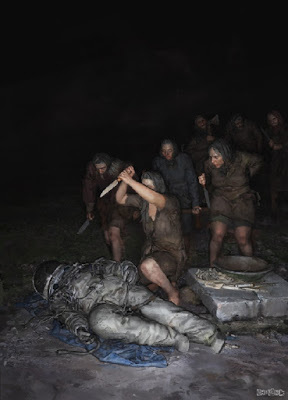
7. RAY CAESAR
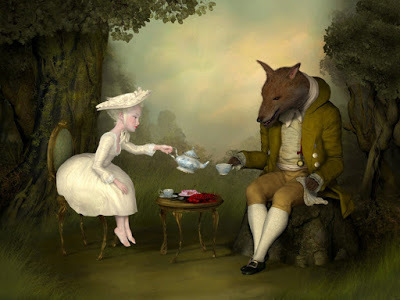
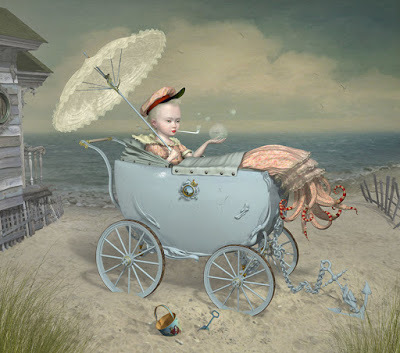
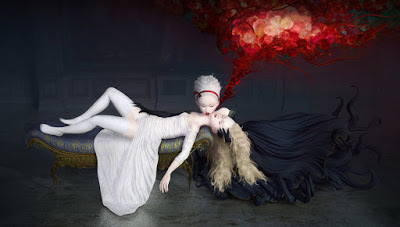
8. TETSUYA ISHIDA
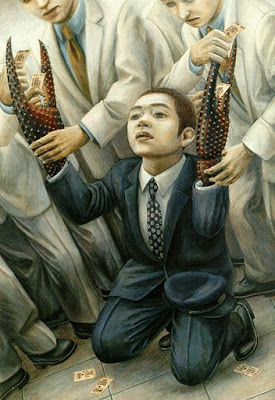

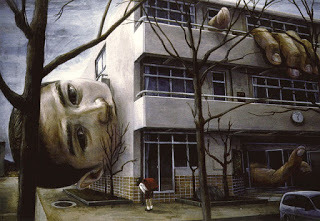
9. ADRIAN BORDA
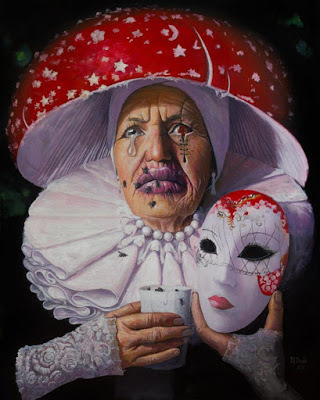
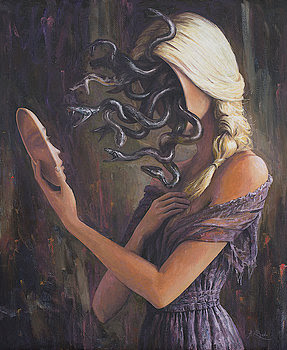
10. BOB EGGLETON
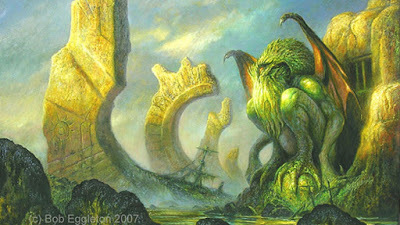
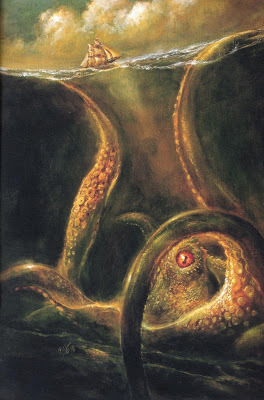
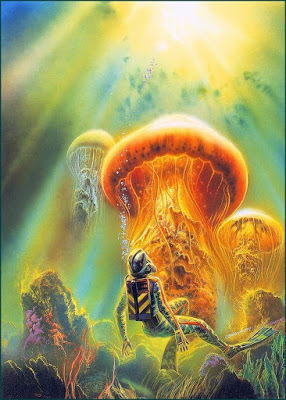
11. DANIEL JIMINEZ VILLALBA
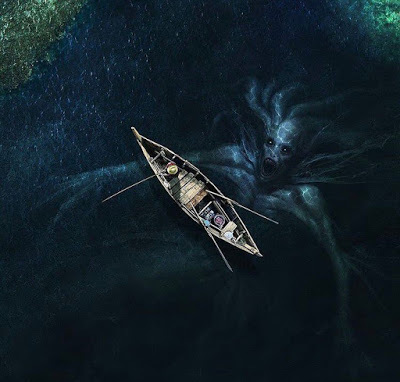
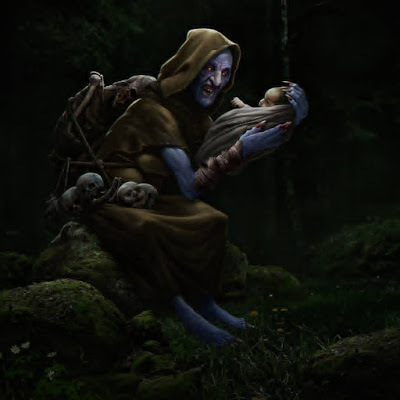
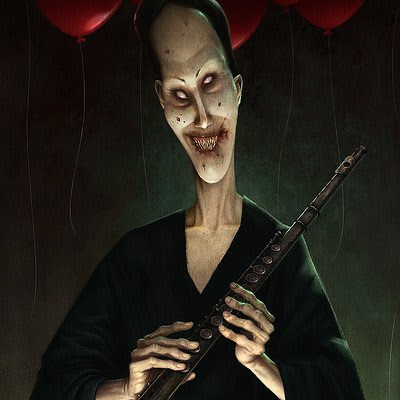
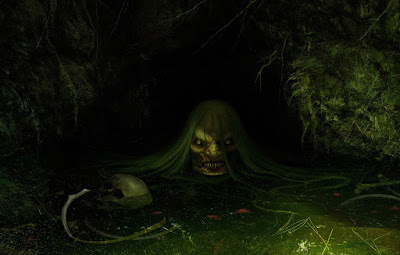
12. FRANCISCO GOYA (specifically, the Black Paintings)
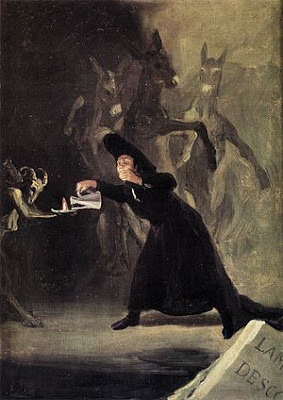
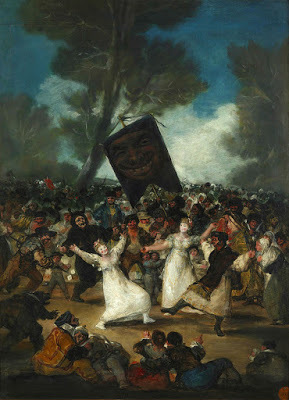
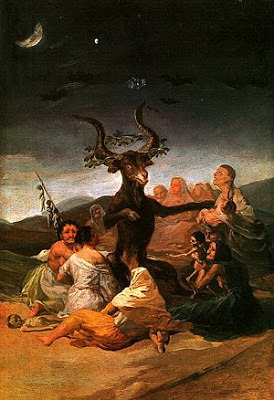
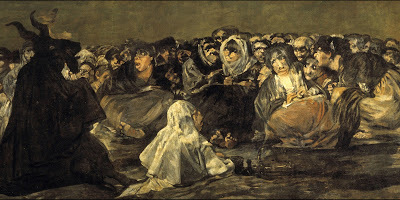
13. JEFF SIMPSON
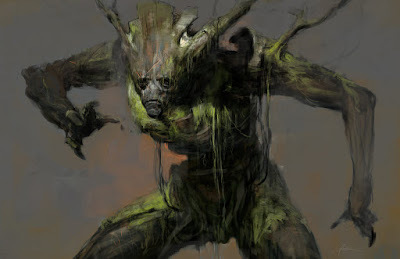
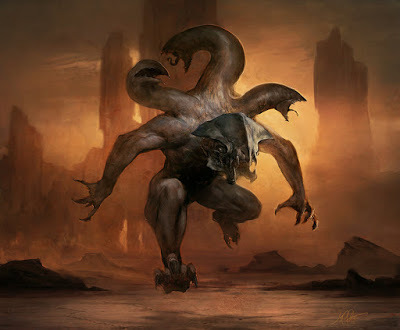
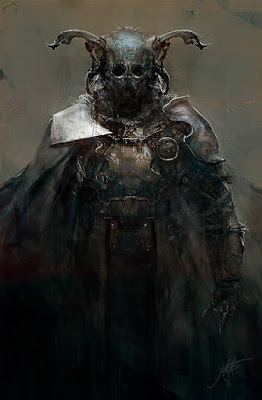
14. LAURIE LIPTON
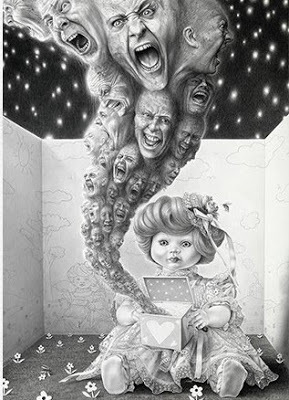

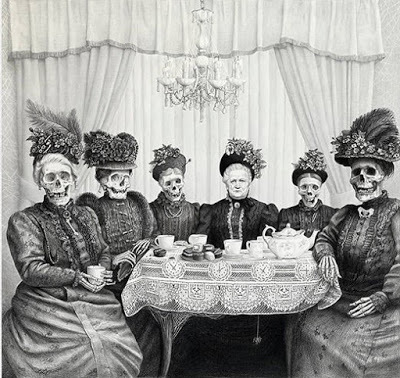
15. OTTO RAPP
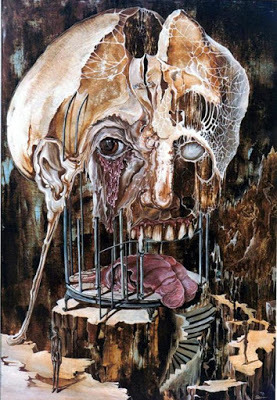
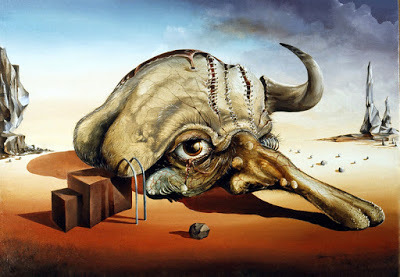

16. RICH JOHNSON
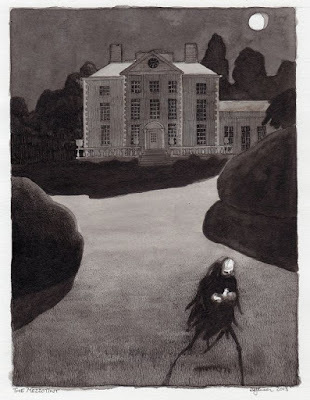
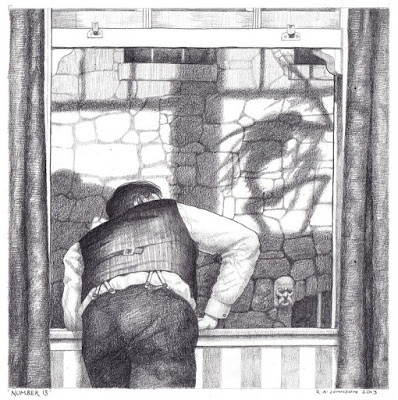
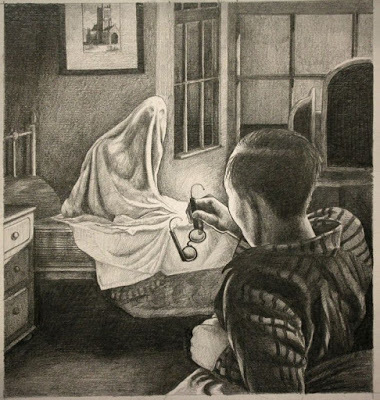
17. VERGVOKTRE
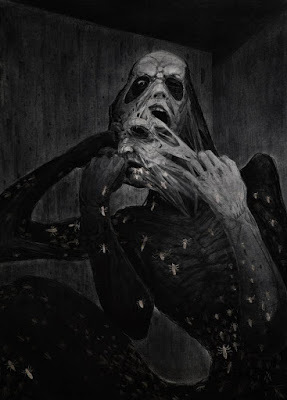
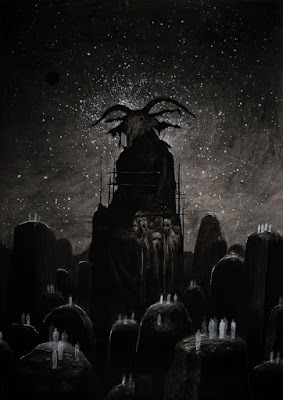
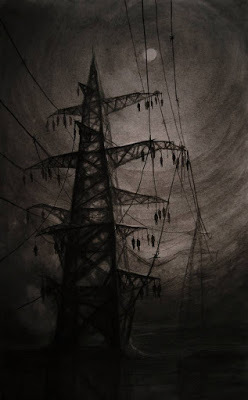
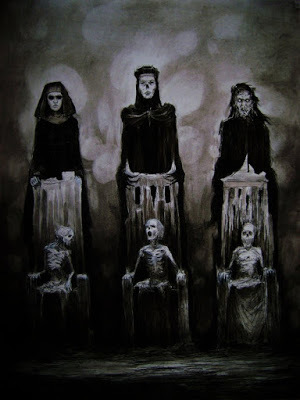
18. ADRIAN SMITH

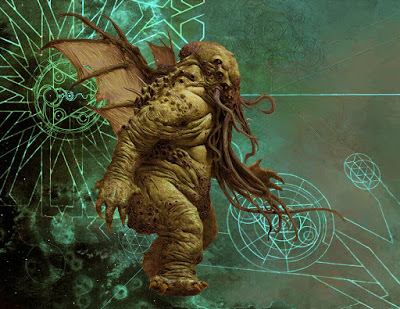
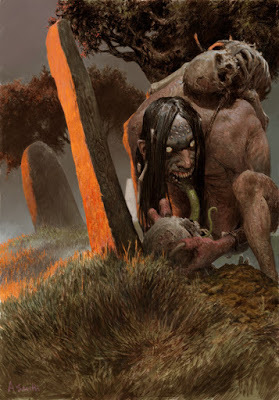
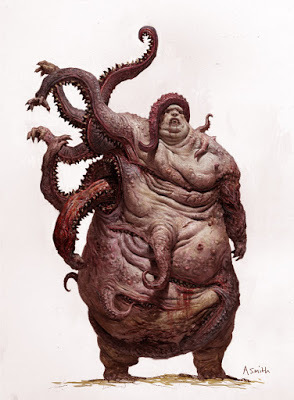
19. BOM.K

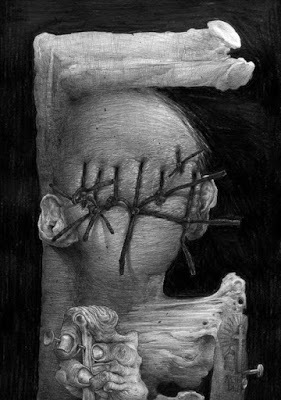
20. DARIUSZ ZAWADZKI
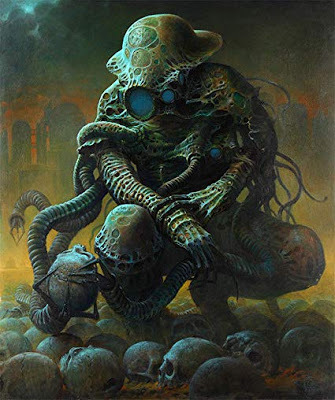
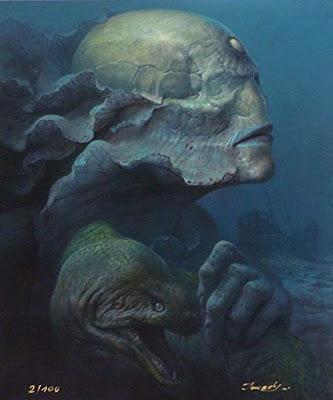
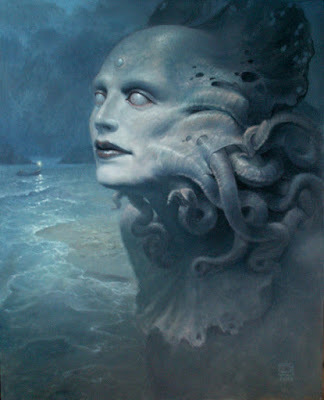
THRILLERS, CHILLERS, SHOCKERS AND KILLERS …
An ongoing series of reviews of dark fiction (crime, thriller, horror and sci-fi) – both old and new – that I have recently read and enjoyed. I’ll endeavour to keep the SPOILERS to a minimum; there will certainly be no given-away denouements or exposed twists-in-the-tail, but by the definition of the word ‘review’, I’m going to be talking about these books in more than just thumbnail detail, extolling the aspects that I particularly enjoyed … so I guess if you’d rather not know anything at all about these pieces of work in advance of reading them yourself, then these particular posts will not be your thing.
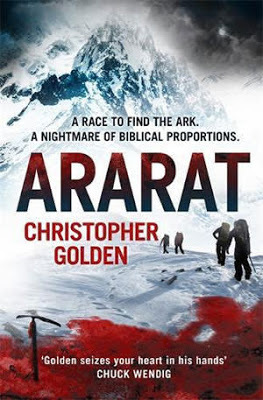 ARARAT
ARARAT by Christopher Golden (2017)
Life-partners and professional adventurers, Meryam Karga and Adam Holzer, think they may have stumbled on the find of a lifetime when an avalanche at the top of Turkey’s Mount Ararat exposes a cave in which an ancient timber craft is lodged. Ararat, of course, is one of the most famous mountains on Earth for reasons that date back almost to the dawn of human history – long has it been rumoured that this was the last resting place of Noah’s Ark.
Determined to claim this incredible prize for their own, Meryam and Adam make the arduous trek to the upper slopes of the wintry mountain in company with a handpicked team of assistants. But inevitably, they aren’t going to have things all their own way.
Of their two guides, Feyiz is fine, but the older one, Hakan, is an awkward, aggressive bully who openly dislikes Meryam because he considers her to be a lapsed Moslem. Then we have the rest of the team, a hotchpotch of scholars, archaeologists and student film-makers, and these don’t make for easy bedfellows either. Catholic priest and ancient languages expert, Father Hughes, does not get on with Professor Olivieri; it’s mainly a case of professional rivalry, but it still threatens the work. The Turkish authorities are present too, and though on the whole cooperative, they are suspicious of Father Hughes, who they worry will try to turn this into a ‘Christian achievement’.
A quieter presence is the mission’s action-man, Ben Walker. He arrives in company with UN observer, Kim Seong, and though he ostensibly represents the US National Science Foundation, in fact he is an American defence operative whose main role is to establish if there is anything on top of Mount Ararat that might be useful to his government. Walker is experienced at this sort of thing (very experienced, it soon transpires), but he knows when to play it low-key; at first, he is all things to all men, but it isn’t long before he too has identified weaknesses in the chain of command which he might be able to exploit.
As if all these vying interests don’t cause enough problems, the weather up there in the high peaks is extremely hazardous, bitterly cold wind and intense snowstorms sweeping the desolate ridges. But initially, the find makes all the hardships and complexities of reaching it worthwhile. The Ark, for that is what it appears to be, has all but burrowed its way into the mountain, its interior accessible only by a relatively small opening. But once you get inside there, it’s a wondrous structure, a vast ocean-going vessel of a sort that no-one thought the pre-Biblical world was capable of producing. It also dates correctly and is a virtual treasure trove in terms of the human bones, pottery and ancient writings adorning its lower decks.
The question as to whether this vast object could actually be Noah’s Ark is the key. No one on the mission believes the Noah story word-for-word, but there is a general acceptance that some tribal elder, possibly named Noah, took his family and some livestock and embarked on a hastily-built craft to ride out a sudden flood. But what kind of cataclysm might have left the boat high and dry at the top of a 16,000-foot mountain?
And then an even bigger and much more unsettling question arises.
Whose is the mummified cadaver the team discover in an eerie, glyph-covered coffin deep in the heart of the fossilised craft?
And why does it apparently have horns on its head?
A gawing fear grips the intrepid band. No one seriously wants to contemplate that this might be the relic of an ancient demon, but then stories of the Great Flood concern a race of evil beings who, in Genesis, were spawned on the Earth by fallen angels, and who in due course became the targets of God’s wrath, hence the fast-rising water.
Could there be a kernel of truth in that myth? Could this be the desiccated remnant of one such creature, which somehow sneaked aboard?
Only when the killings start, individual members of the team butchered with climbing tools, and/or thrown down the mountainside to freeze, does this fear morph into utter terror.
Debates rage on as to the nature of the thing in the sarcophagus. Is it what they suspect? Could it be wielding a malign influence? Or do they simply have a madman in their midst?
The obvious solution is to get the hell out of there, abandon the Ark and the sarcophagus, and stumble back down the mountainside to civilisation. But the weather is getting worse. The worn-out archaeologists are now trapped in this hellish place, and a very real malevolence is spreading among them …
All kinds of influences are visible in this fascinating and intense chiller from US author, Chris Golden, quite a few of them filmic. There is certainly a bit of The Thing in there, hints of The Exorcist , and more than a dollop of Raiders of the Lost Ark (a different Ark this time, of course). But there is nothing unusual in this in the modern age.
Certain book genres seem to have blended together in recent times, to give us a whole new range of thriller/horror/adventure novels, invariably set in exotic locations and underwritten by mysteries from the ancient religious world.
It often makes for an intriguing mix, but I’m particularly impressed on this occasion that Golden has taken it all a step further by upgrading the fear factor to an extreme degree.
We readers are left in no doubt that the Ark discovered here is an amazing thing, venerable and mystifying beyond imagining, and very possibly an indicator that cosmic powers have controlled the events on Earth from time immemorial, and that good and evil once held sentient forms, and maybe still do. But while these huge metaphysical issues pervade Ararat , the author doesn’t forget to entertain us as well.
From the moment, the terrible husk is discovered inside the dank, fire-lit interior of this long-forgotten hulk, the atmosphere changes. Everything that once seemed miraculous now seems deeply ominous. What formerly felt like a hidden door which, should our heroes open it, would shed light upon a distant, semi-mythical past, is a door they must at all costs keep closed for fear of what it might admit.
The author channels these big concepts through his characters, amplifying them in the process without hitting us over the head with them.
Meryam and Adam’s team are robust sorts, outdoor types who’ve managed to make it to the top of the world despite inconceivable obstacles. For the most part, they are scientists and cultured intellectuals, who don’t believe in angels and demons, but not long after you get into this novel, lack of spiritual belief starts to feel like a weakness rather than a strength. If you’re purely a rationalist, how can you cope mentally with supernatural revelations like these?
And it’s not as if all is hunky dory in the group anyway. For various reasons, Adam and Meryam have found themselves drawing apart during this expedition. For one thing, Adam resents that Meryam often confides in the handsome young guide, Feyiz, while he himself is drawn to the beautiful camera-girl, Calliope Shaw. Then there are the religious differences; Golden handles these particularly well, not overdoing the issues that arise when Jews, Moslems and Christians are required to work together, but not pretending that basic mistrust doesn’t exist – and of course allowing it to become a major problem when the horror in the casket is found.
How do you tackle such a being? Whose religious explanation do you believe? Whose religious weaponry do you invoke?
There is a political dimension too. The Turks are paranoid about the American, Ben Walker’s presence, which you can hardly blame them for as he’s so secretive about his real purpose here, while Hakan the hardliner – and he’s not the only one! – increasingly feels that all foreigners, particularly irreligious modernists like these, should be barred from what is clearly a sacred site.
In short, everything that could be going wrong is soon going wrong, and at a time when this small microcosm of humanity is pitted against what is potentially the deadliest foe mankind has faced in millennia – and this time, it’s safe to say, God won’t be intervening to save everyone with a cataclysmic flood.
Ararat is a rousing 21st century thriller, an intense action-horror both claustrophobic in tone and epic in scale. At the same time, it’s disconcertingly grown-up in terms of the questions it raises … mainly because there are no easy answers (if any). A thoroughly compelling read.
And now, I’ll embarrass myself again by attempting to cast Ararat should Hollywood or HBO come knocking at Chris Golden’s door. It’s often drawn to my attention that in playing this game with each review, I sometimes overlook the fact that adaptations are already in the works. Apologies if that is the case here – in truth, I’d be disappointed and surprised if it wasn’t – but I’m still having a go. Remember, the big difference between my casting sessions and those of the big studios is that in my case money is no object (heh heh heh).
Ben Walker – Adrien BrodyMeryam Karga – Ahu TurkpenceAdam Holzer – David SchwimmerKim Seong – Dianne DoanFeyiz – Cansel ElkinHakan – Serhan YavasFr. Cornelius Hughes – Michael GambonProf. Armando Olivieri – Giancarlo GianniniCalliope Shaw – Hayley Atwell
Published on October 10, 2019 00:33
October 3, 2019
Galleries of darkness, for October - Week 1
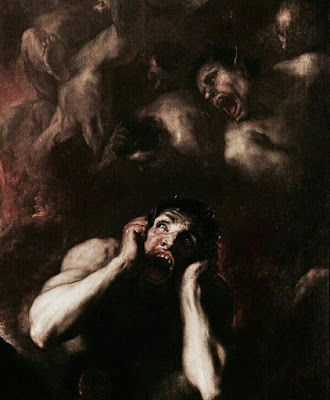
Okay, something a bit different now that we’re into the month of October. It’s a time of year that’s always associated with spookiness. Regular readers of this column will probably think: “So what’s different there? Everything you talk about on here is spooky or scary or dark or disturbing.”
Well, yes … that’s true. But rather than blathering on throughout October about books, films or whatever I happen to be writing at the time, and doing my level best to persuade you that it’s the scariest thing since His Satanic Majesty’s escape from Hell, I thought I’d take a more visual approach this month – and hit you where it frightens the most, showcasing artwork rather than verbiage.
I’ll also this month, in my review section – again, because it’s October – be looking exclusively at horror novels or anthologies, starting today with John Farris’s legendary ALL HEADS TURN WHEN THE HUNT GOES BY.
Now, if the John Farris piece is all you’re here for, no problem. As is usually the case, you can scoot on down to the lower end of today’s blog, where you’ll find the review and discussion in the ‘Thrillers, Chillers’ section. However, if you’re interested in seeing what else I’ve got to offer first, then stick around and check out some …
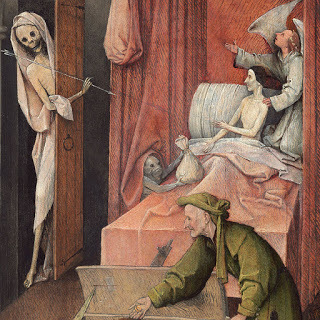 Dark Arts
Dark ArtsNot many people know this, but I’m actually a lover of fine art. I adorn my home with paintings (whenever I can afford them), and I’m never more relaxed than when I’m wandering around an art gallery with plenty of time to absorb and enjoy the treats on offer there. (I don’t go as much for sculpture; sadly, that wouldn’t be possible in our house, as we have two whirlwind springer spaniels with a lifelong mission to demolish every ornament in their path).
When I say I’m a lover of the arts, you may assume that, because I’m also a scare-meister when it comes to my writing and reading, that this means I’m mainly interested in artists who specialise in the grim and ghoulish. Well … that’s not true. I love quality paintings, whatever the mood they evoke. That said, for our purposes this month – October, remember, that spookiest time of the year! – I’m going to be focussing on those artists who’ve dabbled in the darkness.
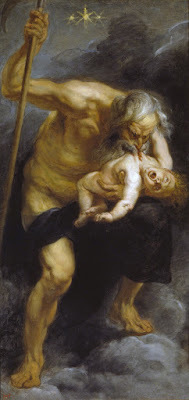 I’ll thus be hitting you each Thursday this month with a gallery of 20 painters or illustrators, offering several samples in each case of their more twisted imaginings, the whole thing culminating on Halloween itself.
I’ll thus be hitting you each Thursday this month with a gallery of 20 painters or illustrators, offering several samples in each case of their more twisted imaginings, the whole thing culminating on Halloween itself.Now, before we get going, I should point out that, even featuring 20 a week – which overall this month gives us a nice round 100 – I’ll barely be scratching the surface of this subject. So many visual creators have thrown nightmares onto canvas, and not just those of a recent vintage.
Check out the image at the top of this column: a close detail from Fall of the Rebel Angels by Luca Giordano, created in 1666. Have you ever seen such a depiction of horror and terror? No less disturbing, you’ll also see in this opening section (in descending order) Death and the Miser by Hieronymus Bosch (1494), Saturn Devouring His Son by Peter Paul Rubens (1636) and Flaying of Marysas by Titian (1570).
I won’t wax lyrical on the subject of these old masters. Firstly, because I’m not qualified to do so – I'm an art buff, not an expert. Secondly, because they largely speak for themselves.
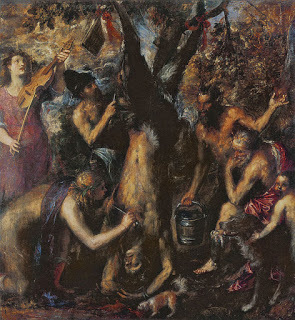 That’s also the approach I’ll be taking with the weekly galleries I’ll be presenting to you. In nearly all cases I’ve done my research but haven’t learned anything like enough about the painters themselves to discuss them. In some cases, I don’t even know the names and dates of the pictures themselves; that’s the problem with the Internet – you find this great stuff floating around online but finding credits and background information is much harder.
That’s also the approach I’ll be taking with the weekly galleries I’ll be presenting to you. In nearly all cases I’ve done my research but haven’t learned anything like enough about the painters themselves to discuss them. In some cases, I don’t even know the names and dates of the pictures themselves; that’s the problem with the Internet – you find this great stuff floating around online but finding credits and background information is much harder.However, in each case I’ve created a link, which will take you through to that particular artist’s page or site, from where you can hopefully learn all you need to know, and maybe even buy some prints. (You’ll notice that most of these artists are current, so it may even be possible to acquire some originals).
So, without further ado, I’ll stop gabbling and get on with our …
GALLERIES OF DARKNESS – Week One
As I say, don’t be looking for detailed info on here; I simply haven’t got it – just follow the links and with luck that will be sufficient. (And here’s a quick, last-minute WARNING: though I’ve consciously tried to avoid anything that is simply revolting, I’ve gone all out for the disturbing and terrifying. So, be aware, these artists do NOT hold back).
1. ELIRAN KANTOR

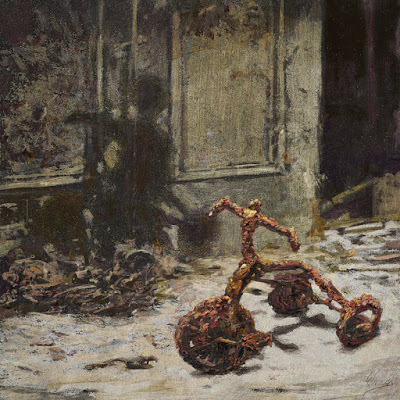
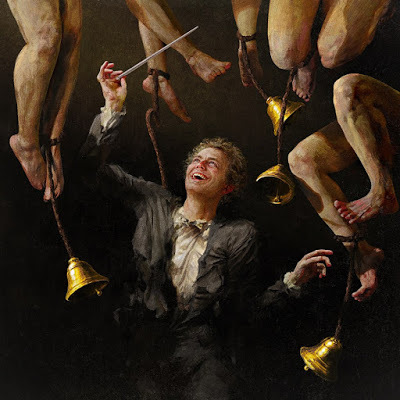
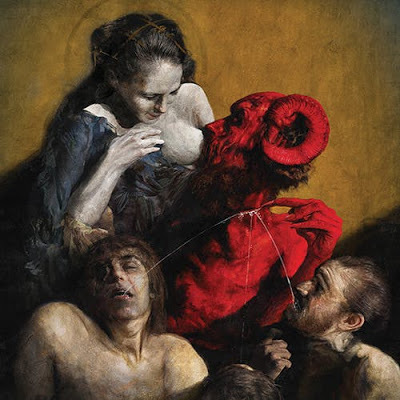
2. ASYA YORDANOVA
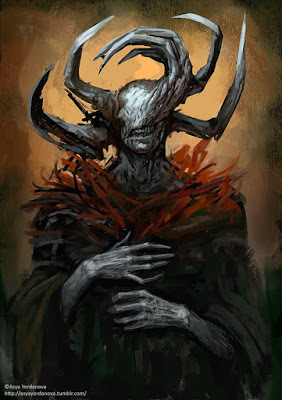
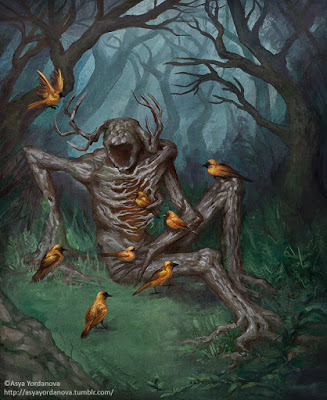
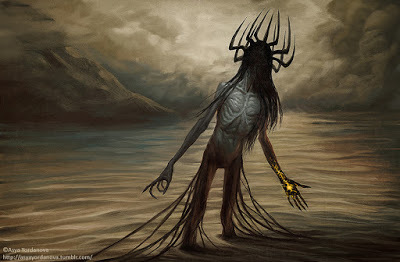
3. BORIS GROH
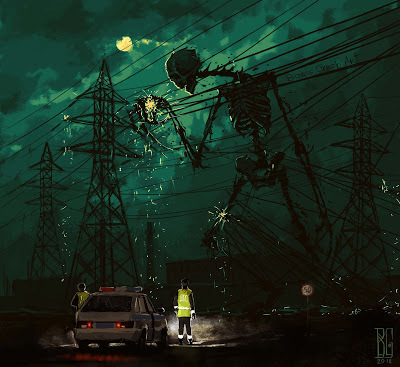
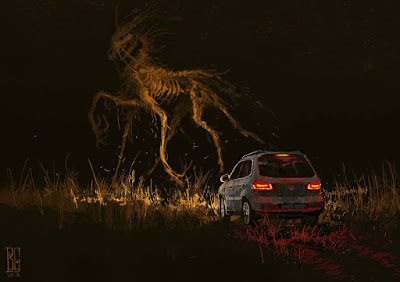
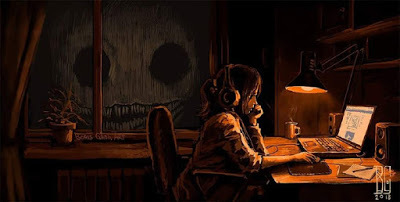
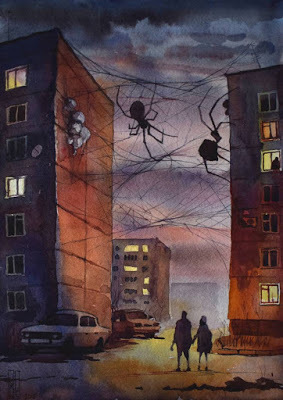
4. DAVE KENDALL

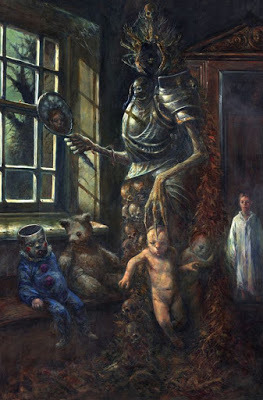
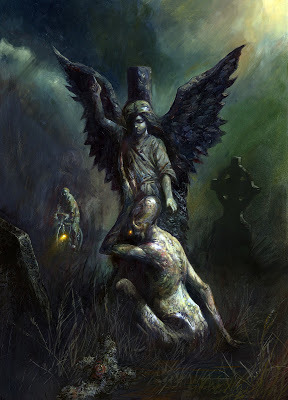
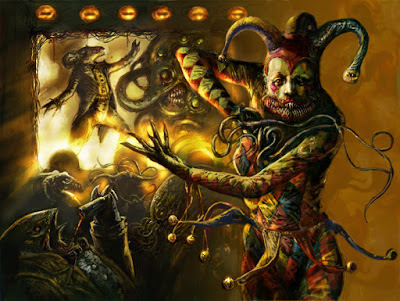
5. JOSHUA HOFFINE
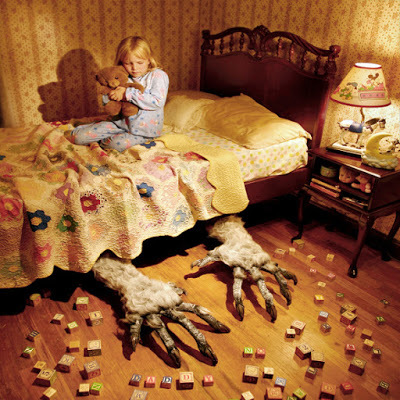
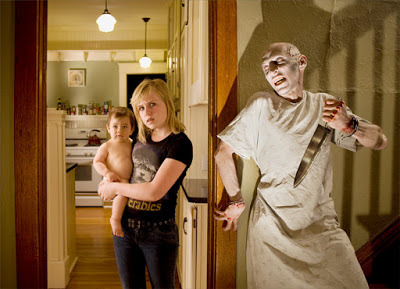
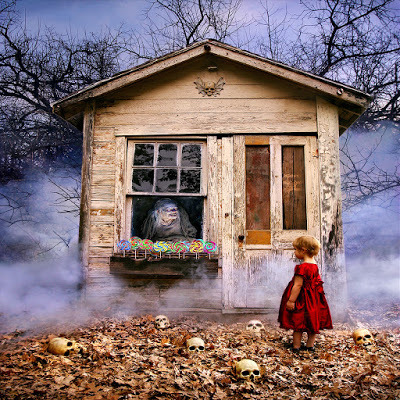
6. PAUL CAMPION
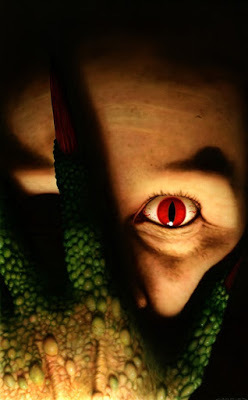

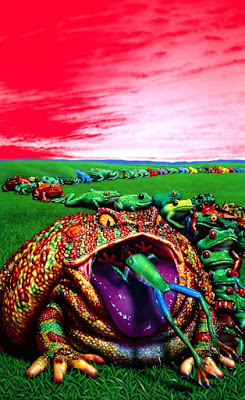
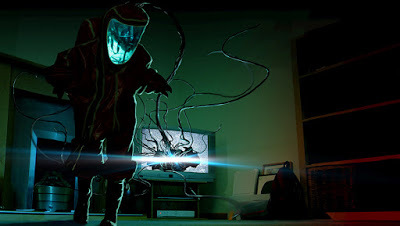
7. RACHAEL BRIDGE
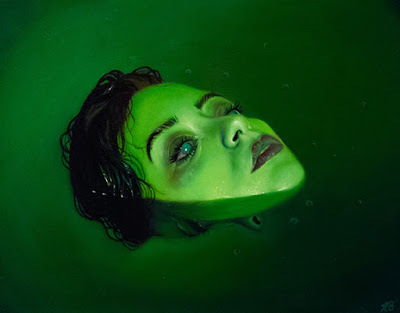
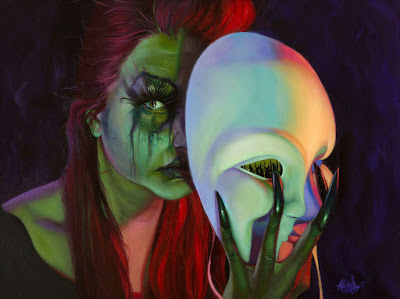
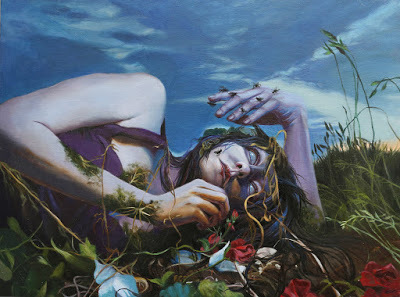
8. SETH SIRO
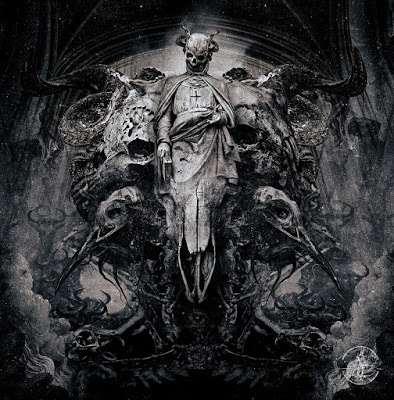
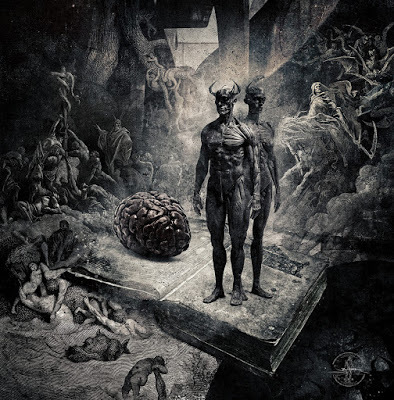
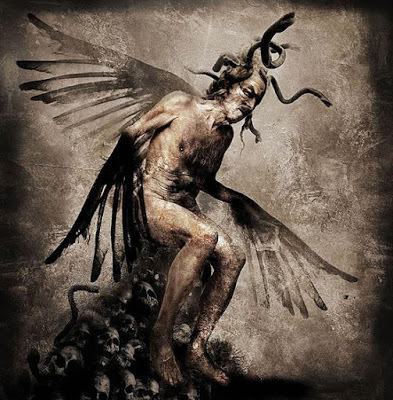
9. LES EDWARDS
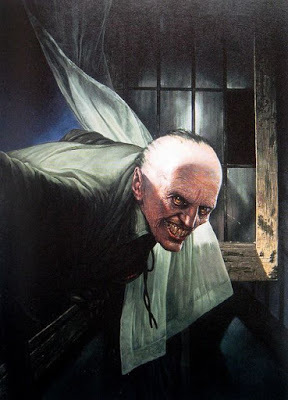
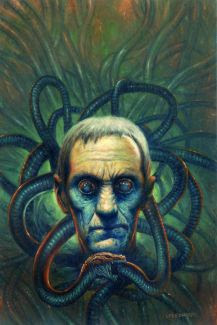
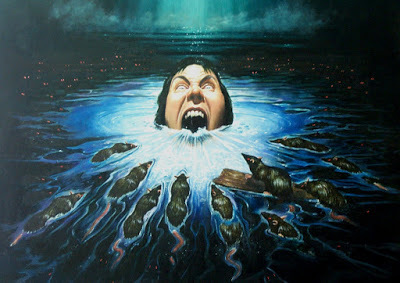
9. SAFIR RIFAS
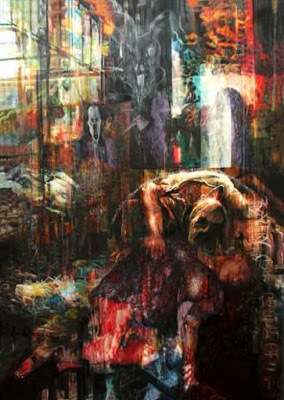
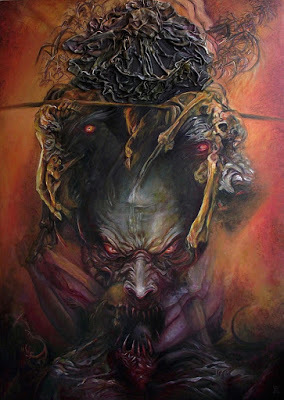

10. VIRGIL FINLAY
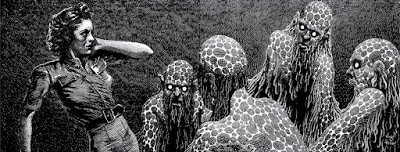
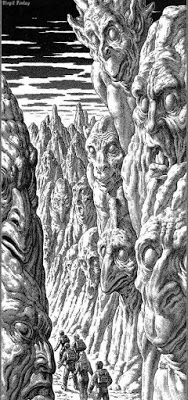
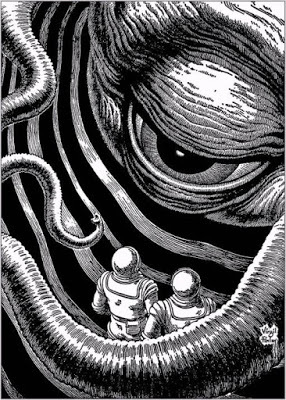
11. BUDDY McCUE
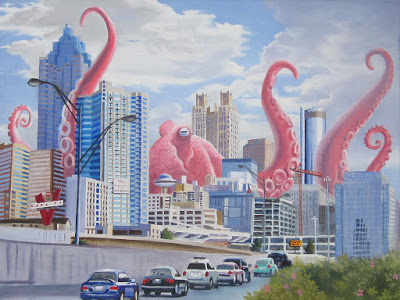
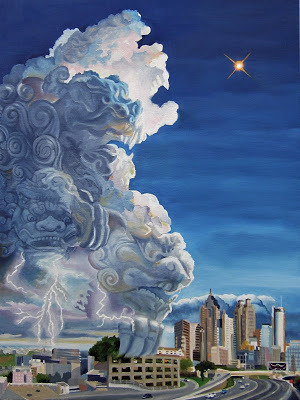

12. AERON ALFREY
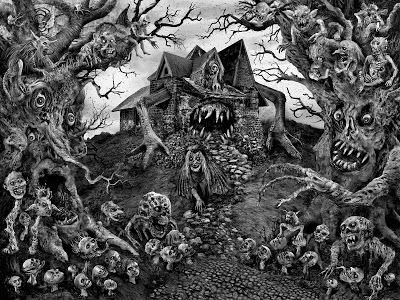
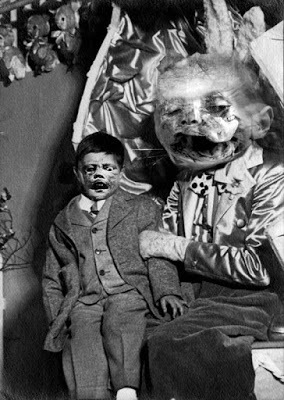

13. REGGIE OLIVER
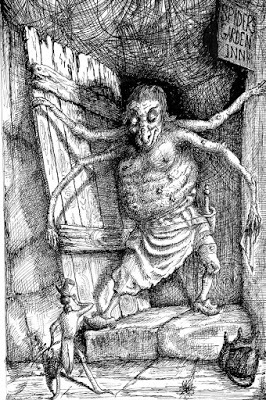
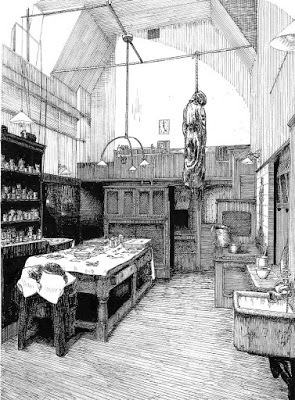
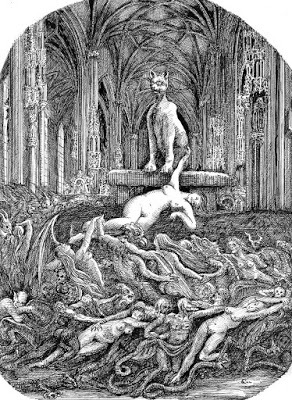

14. JUNJI ITO
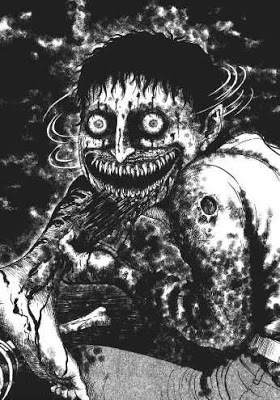

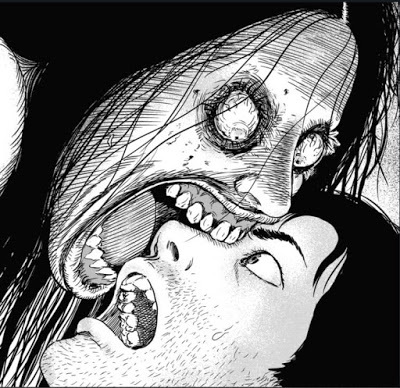
15. PAULA REGO
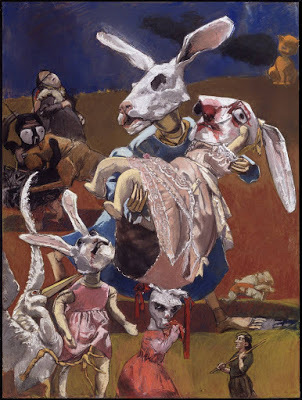
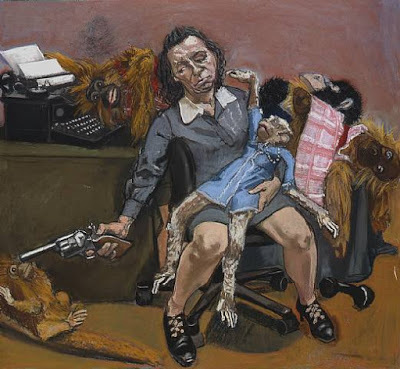
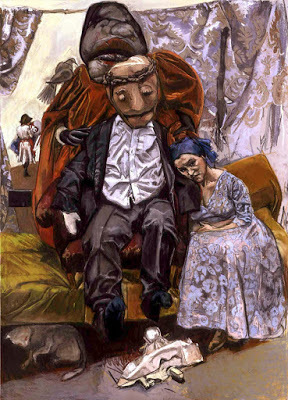
16. SANTIAGO CARUSO
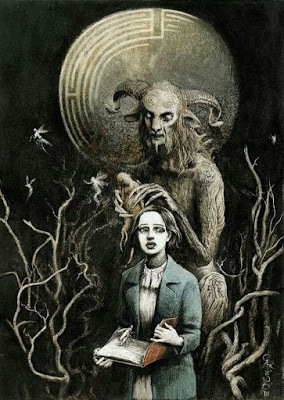
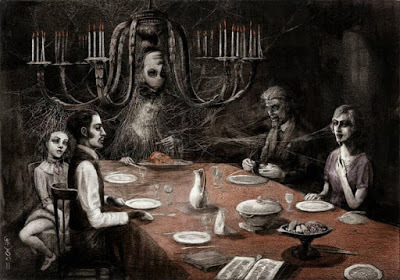
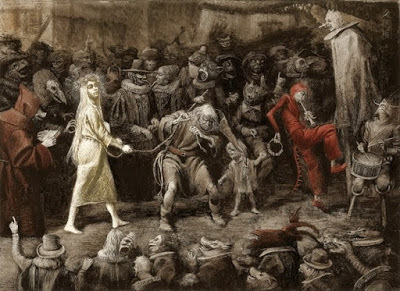
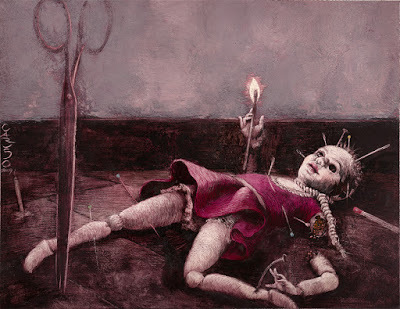
17. WAYNE BARLOWE

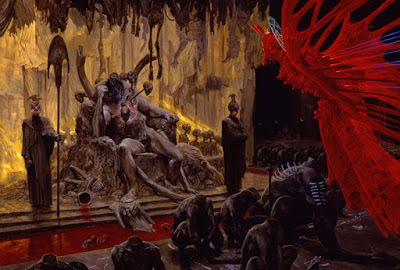
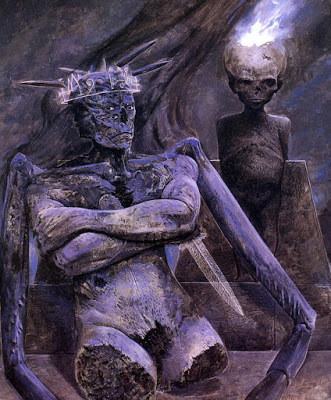
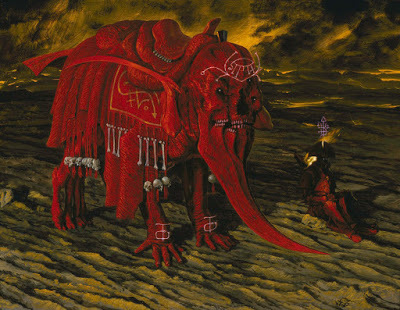
18. KARL PERSSON

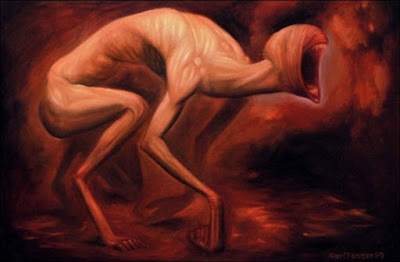
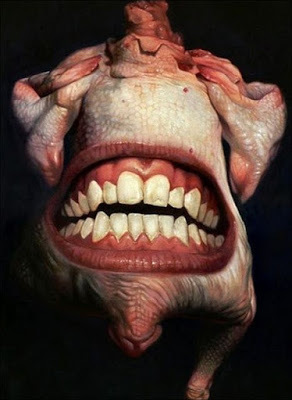
19. MARK RYDEN
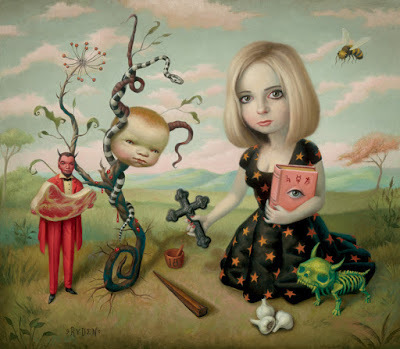
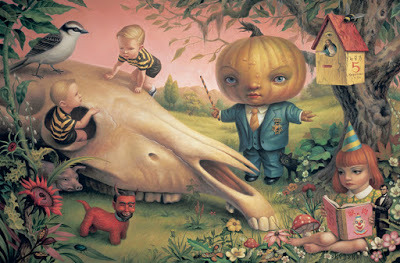
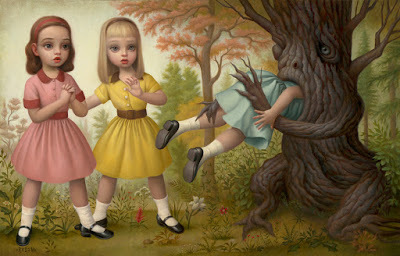
20. PIOTR JABLONSKI
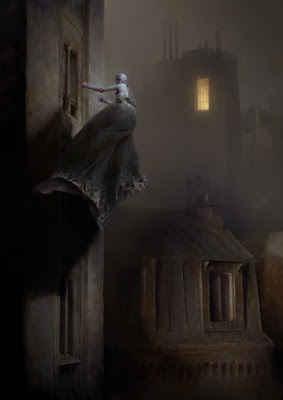
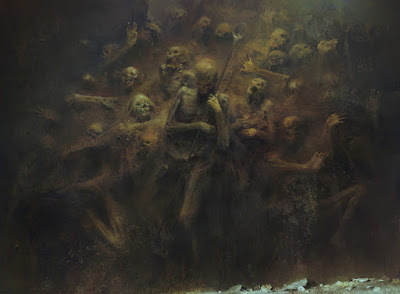
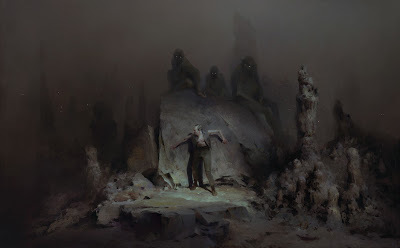
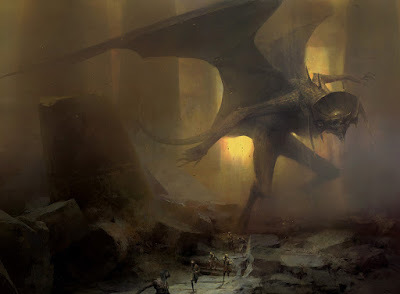
Part II follows next Thursday ...
THRILLERS, CHILLERS, SHOCKERS AND KILLERS …
An ongoing series of reviews of dark fiction (crime, thriller, horror and sci-fi) – both old and new – that I have recently read and enjoyed. I’ll endeavour to keep the SPOILERS to a minimum; there will certainly be no given-away denouements or exposed twists-in-the-tail, but by the definition of the word ‘review’, I’m going to be talking about these books in more than just thumbnail detail, extolling the aspects that I particularly enjoyed … so I guess if you’d rather not know anything at all about these pieces of work in advance of reading them yourself, then these particular posts will not be your thing.
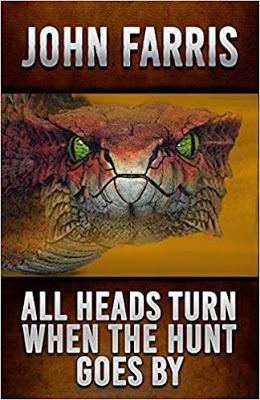 ALL HEADS TURN WHEN THE HUNT GOES BY
ALL HEADS TURN WHEN THE HUNT GOES BY
by John Farris (1977)
In 1942, officer and gentleman, Charles ‘Champ’ Bradwin, takes leave from his unit and heads home to Arkansas to attend his younger brother, cadet officer Clipper’s wedding. It is a grand occasion. Everyone who is anyone is present; most members of the aristocratic Bradwin family, including demagogic patriarch, Boss, though not oldest brother, Beau, who left the district many years earlier. But it still ends in disaster, because when the church bell inexplicably tolls of its own accord, Clipper goes mad, attacking the congregation with his dress sabre, slaughtering, among others, his wife-to-be and his father, before killing himself.
Stunned and helpless, the family retreat to Dasheroons, their vast rural estate, but there is no solace to be found there. Both Champ and Nhora, Boss’s young and beautiful French wife (his third, in fact), are lost for an explanation, while Champ’s wife, Nancy – whom Clipper particularly tried to slay, but who survived – is left almost comatose by the experience. The staff on the estate, Boss’s loyal, longstanding man-servant, Hackaliah, and his educated but surly son, Tyrone, are equally horrified and bemused. Detailed examination of Clipper’s background reveals a hitherto concealed lifestyle of predatory sexual behaviour, but there is no indication of the homicidal personality that revealed itself during the wedding.
With no option, but shell-shocked before he even gets to the battlefield, Champ must now return to his unit and fight the war, while Nhora takes charge of the palatial estate despite a strange undercurrent of hostility towards her.
Needless to say, the terror and the misery go on. Champ is dispatched to the Pacific, where his company is decimated in heavy fighting with the Japanese, and he himself suffers an horrific throat-wound (though this happens in weird, dreamlike circumstances, during which his assailant looks remarkably like a decayed version of his dead brother, Clipper). When Champ finally returns home, a shadow of the man he was, he is in the company of a doctor the Bradwin family have never met before, an Englishman called Jackson Holley, whose credentials are very good, at least on paper – but who in actual fact has a fabricated pedigree because he never completed his medical training and is now on the run from his own peculiar demons.
But this is actually a big event, because with the arrival of Holley, two cursed families have finally come together.
It seems that the wedding butchery is only one tragedy in the history of the Bradwin family; there have been others in the past, dating back to an even more savage occasion when Boss, not exactly a white supremacist but still an icon of southern gentry entitlement, led violent retaliation against a protest by local black farmers, which turned into a massacre (as one character comments, Dasheroons “is built on the bodies and blood of Africans”) – but the Holleys too have stumbled from one misfortune to the next.
Jackson Holley is lucky to be alive, as his youth, spent at a Congo mission hospital where his father was a voluntary medic, brought him face to face with all kinds of hardships and horrors: heat, illness, bizarre apparitions, and a cannibalistic tribe so in thrall to the aggressive snake goddess, Ai-da Wedo, that they were prepared to sew the seeds of their own eventual destruction by following her warlike path rather than living in peace with the ever-more covetous colonial powers.
A major coincidence now occurs in the story (at least, it seems that way at first, though all will be revealed in due course). Because beautiful widow, Nhora, also spent her youth in that steamy jungle realm – at the time classified as French Equatorial Africa – where she was kidnapped as a child by the same ferocious tribesmen. Perhaps inevitably, she and Holley hit it off when they meet – in fact, it is virtually love (and lust!) at first sight – but even though the Englishman has brought the family’s last surviving son safe home again, he doesn’t feel entirely safe; there are many menacing mysteries on the great southern estate.
What happened to Beau Bradwin?; did he really leave because he fell out with his father over the brutal methods Boss displayed in his younger days? And if so, where did he leave to? Is it possible that Tyrone, who clearly does not get on with his own father, Hackaliah, might actually have been sired by Boss, and in which case does he have his own agenda? Why is a grizzled outlaw known only as Early Boy hanging around on the plantation’s fringes? What dark power keeps so many of the family’s black servants in such a state of fear? Could the secret of all this evil lie in the apparent voodoo temple that Holley and Nhora discover in a nearby bayou?
The answers to all these questions, and others, will only be provided if Holley hangs around for once, and tries to work his way through the layers of mystery. Nhora may help him, or she may hinder him. But one thing is certain, when the truth finally emerges it will neither be palatable nor edifying. If we thought there was horror in the Bradwins’ and Holleys’ lives previously, we ain’t seen anything yet …
There are all kinds of questions surrounding the epic supernatural saga that is All Heads Turn When the Hunt Goes By . First of all, the most obvious one is where the book’s ultra-oblique title came from. There has been much debate about this, with theories ranging from the eclectic to the fantastical, the author himself adding nothing to the mix by never explaining it and making nothing obvious in the narrative.
The other big mystery is why this classic horror novel and its author are not better known.
Back in the 1970s, John Farris was writing alongside such future luminaries of the genre as Stephen King, Peter Straub and Dean R. Koontz, all of whom would go on to become household names while he remained obscure. It can’t just be the case that Farris’s writing wasn’t as good as that of his contemporaries, because All Heads Turn When the Hunt Goes By is excellently penned, comprising beautiful prose, multi-layered characters, and richly evoked atmospheres, be they the disciplined world of the US military, as embodied by Champ, the dreamy, semi-aristocratic lifestyle found on the southern plantations, as personified by the Dasheroons estate, or the hellish environment of an isolated jungle-mission deep in the African rain forest, where superstition abounds and almost everything there can kill you. So deeply felt are these sequences that you’d swear you were actually there. You can visualise the scenery and smell the plant-life, you can feel the heat on your skin.
The same applies to Farris’s characters, who are vastly more complex than anything you will usually encounter in supernatural fiction. In some ways, he almost overdoes this, always avoiding info dump but describing them through a procession of chapters in such minute detail – physically, mentally, spiritually – noting their every movement, their every adjustment of posture, their every change of tone, mood, expression, that it leaves nothing to the reader’s imagination. It’s very fulsome, overly so to be frank, but that’s typical of its era; it’s hardly a chore to read it because it’s so well-done, but it won’t be popular across the board with modern readers.
In terms of these same characters, there is no question that we are dealing with living, breathing people, and each one, in his/her own way is fascinating, in addition to being realistically flawed.
Leading man, Jackson Holley, is basically a conman – polite and well-bred admittedly, but he should not be telling people that he’s a doctor and he most certainly should not be practising medicine. An unreliable sort, he flits here and there, breaking hearts, skipping his responsibilities and occasionally lowering himself to deal with criminals like Early Boy. But as the book’s hero, he works. He hardly had the best start in life, but managed to rise above it, he’s usually well-intentioned, he’s undoubtedly brave and you get the strong feeling that he’s owed a better life, even if that doesn’t necessarily justify his attempts to embezzle one: a typical charming rogue from the end-days of the British Empire.
Meanwhile, the Bradwin brothers are also products of their time and place: American power-elite as opposed to British. The long-departed Beau was the square-jawed guy with the conscience, and a liberal-minded friend to the local black farmers, who though the days of slavery were behind them, had still to taste the fruits of Civil Rights, which put him at odds with everything his family had come from, and soon saw him relegated to the lowest rung of Depression-era society. Champ, on the other hand, is the good soldier, the unquestioning hero who answered his country’s call, the one in whom all hope is invested for the future. Meanwhile, Clipper is the youngest and most spoiled, the one who’s been able to do whatever he wants because his declining father never saw anything more harmful in him than youthful exuberance (and maybe even recognised his gross appetites as a direct inheritance). Lastly, there is Tyrone, the mixed-race half-brother, the one who had to fight for everything, and as is such the most cynical, the most cunning and by far the most dangerous.
Then, of course, we have Nhora, the French-born widow whose apparent innocence of the world (not to mention her own overwhelming allure) may conceal a calculating schemer, because after all, more so even than Holley, Nhora is a stranger in a strange land here, and once Boss is dead, scheming may be the only way she is going to survive.
But it isn’t just the leads that this degree of detail applies to. There are many characters in All Heads Turn When the Hunt Goes By , an entire support-cast of secondaries and walk-ons, almost all of whom have crucial roles to play and as such are drawn in unforgettable detail.
And yet this depth of writing doesn’t just extend to characterisation. The entire narrative unravels in a cascade of steady and vivid exposition, which at the same time is wry, humorous, sensual, every scene exquisitely written and presented – the undercurrents as much as the surface stuff – every page (even when nothing important is happening) shimmering with tension and atmosphere. John Farris’s ‘Southern Gothic’ background shines through repeatedly and intoxicatingly.
The only real trade-off with regard to this – but it is a trade-off – is the loss of pace.
Without any doubt, this novel is a slow burn. That’s not always a bad thing. I have no concerns about an author who takes his time to set the tone, to evoke mood, time and place, to build the world in which his story will explode. But I do worry that in this particular case it may go a little too far. It doesn’t help that various characters, including those of lesser importance, don’t just commence their journeys on separate continents but in different time-zones, chapter after chapter rolling by as they follow their individual paths and still none of them meeting up, but that was very much the style of the ‘holiday horror novels’ so popular in the days when this book was written, with huge amounts of what might now be seen as extraneous detail cheerfully shovelled in. But no matter how picturesque the prose, it may be a little bit too much for most modern tastes.
But at the end of the day, I’d argue that this is still a great book and a valid horror read, especially as quality supernatural fiction – particularly in that traditional demonic / voodoo / mythological vein – is so thin on the ground in the 21st century.
The other big plus with All Heads Turn When the Hunts Goes By is that it’s meaningful.
This is no lightweight gore-and-sex fest, as specialised in by certain horror authors of the 1970s. I mean, it’s dark and disturbing stuff (because, trust me, literally everyone suffers in this book), but that’s only because Farris doesn’t stint on exploring his numerous mature themes in the most visceral and unforgiving way: class, caste, race, heroes and villains, historical guilt, sexual politics, cultural imperialism, the repercussions of revenge, obsession, desire, lust and so on. But it’s not a lecture either. Everything is woven into the run of events so that, in the fashion of true high-quality fiction, you absorb it subliminally as you read.
For all these reasons, this book is a forgotten classic. Anyone who enjoys an uncompromisingly dark and intriguing read and is willing to exercise a little bit of patience, you need to rediscover it right now.
As always, I’m now going to cast what I think would be an ideal TV horror series in this age of no-holds-barred adult television, were anyone (HBO?) to take a chance on it. Only a bit of fun, of course (no casting director has ever listened to me with my own stuff, so why would they start here?), but anyway, here are my picks for the leads in All Heads Turn When the Hunt Goes By, the TV show:
Jackson Holley – Henry CavillNhora Bradwin – Audrey TautouCharles ‘Champ’ Bradwin – Misha CollinsHackaliah – Danny GloverTyrone – Michael EalyNancy Bradwin – Katheryn WinnickEarly Boy – Anson Mount
Published on October 03, 2019 01:22
September 29, 2019
SEASON OF MIST now on the written page
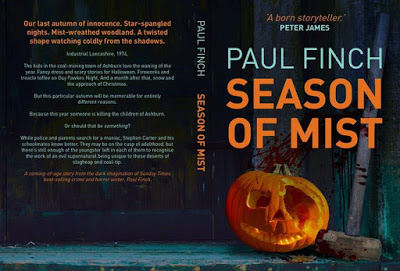
Well, a few weeks ago, I launched my autumn-flavoured novella, SEASON OF MIST, to what so far is pretty decent acclaim (which makes me very happy). Of course, that initial launch was in electronic format, but at the same time, I promised that I would also be bringing it out in paperback as soon as possible.
Thankfully, that time has now arrived.
As you can see above, here’s the full jacket. The book is now available for pre-order in all the usual places. Just follow the links.
I’ll talk a little bit more about SEASON OF MIST is a few minutes, because today I also intend to include some choice snippets from it, just in case your appetites haven’t been whetted enough. At the same time this week, though, I’ll be reviewing another piece of work that occupies the twilight zone between horror and thriller: Marisha Pessl’s enthralling and very chilling NIGHT FILM.
If the Pessl review is all you’re here for, that’s no problem. As usual, you’ll find it at the lower end of today’s blogpost. Just zip on down there straight away. However, if you’re also interested in SEASON OF MIST , perhaps you’d like to stick around here first for some …
Autumn spookiness
SEASON OF MIST is a quasi-autobiographical tale, which follows the fortunes of a small bunch of 13-year-olds, and one of them in particular, Stephen Carter, who in their home town of Ashburn, Lancashire, in the year 1974, experience the kind of autumn that nightmares are made of.
Normally, they enjoy this time of year. Summer is over, which is a bind, but October, November and December bring treats of their own: everything from jack-o-lanterns and bob-apples to gunpowder, treason and plot, from Parkin cake and woodlands turned red and gold with cascading leaves to frost patterns on bedroom windows, snowball fights and the opening of the Advent calendar. Unfortunately, this autumn as you may have seen in the blurb overhead, will be very different, because this year the Lancashire coal town of Ashburn will be terrorised by a vicious killer, who is specifically targeting the young.
The obvious response by the authorities is to impose a curfew, but kids will be kids, you know. They want to get out there and have fun. They want to enjoy Halloween and Bonfire Night and the first snows of winter. They don’t want to be kept cooped up.
However, when the killer starts striking close to home, Stephen and his mates have second thoughts, especially when they spot evidence that this may be no ordinary murderer.
The police are everywhere, but Stephen and co quickly start to suspect that the nameless predator is far more evil than any deviant they will ever have encountered before. The press run sensational scare stories nightly, but Stephen reckons they’d blow a gasket if they knew how strange and mysterious this faceless enemy actually is ...
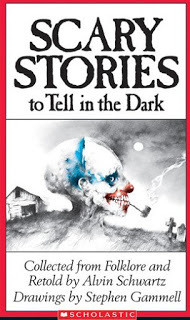 Excerpts
ExcerptsSEASON OF MIST is 40,000 words in length (so, it’ll keep you reading – it’s not a short story), but it was first published in 2010 as part of a collection called WALKERS IN THE DARK. It’s finally being resurrected as a stand-alone piece because it’s one of my personal favourites and, almost a decade later, because I still have faith in it to scare the pants of folks, especially as recent film adaptations of popular novels like It and Scary Stories to Tell in the Dark , and of course the hit TV series, Stranger Things , have reawakened interest in eerie folk-tales and spooky stories from the edge of town (not to mention some of those very macabre public-safety adverts that we used to get back in the day), as dealt with by a bunch of youngsters who are finally coming of age.
As mentioned, it sprang from my own youth and my life in Wigan, Lancs, (Ashburn in all but name), during the early/mid 1970s, and the many terrifying and supposedly true stories that we used to regale each other with during those long, misty autumn nights.
I also mentioned that some of the events depicted in this book are true, as in they actually happened. Which ones? Well … you won’t even get close to guessing until you read it. But if that isn’t enough of an enticement for you, here, as promised, are a few short excerpts:
At the farthest end of the third lawn was something the Blyford family called the ‘Spinney’. This was actually a small wood. It contained thickets and brambles rather than fully mature trees, but again it was dense and tangled. In summer it was matted with greenery, but in winter black and twisted like a chaos of gangrenous limbs. In the very heart of it, accessible by a winding path, was what they referred to as the ‘Wendy House’, but to call it the ‘Eyesore’ would have been more accurate. It was a small, timber structure, all elaborate cornices and carved woodwork. It looked Germanic, like something out of Hansel and Gretel, and at one time had been painted jolly colours: pink, yellow, sky-blue. Now it was a sombre shell, drab and grey, every part of it riddled with decay. In recent times, the Blyfords had used it to store garden furniture, but with a leaking roof, no glass in its windows and mould running rampant throughout, it had become unfit even for this purpose. Viewed at night, it was an almost impossibly sinister sight, an impression reinforced by its remoteness from the Blyford House, or in fact from any other house. “The rules are simple,” Gideon said. “You’ve got to stay in it one at a time, for as long as you can. The one who lasts longest is the winner.”
***
In spite of the wide interest in the case, the newspapers had nothing substantial to report for the next month, aside from rumour and counter-rumour, and these were never less than lurid. The story about the hysterical laughter at the scene of Alan Richardson’s murder made it onto the front pages, along with new, equally disturbing tales: Satanic symbols had been left next to the bodies. A tall, pale-faced young man had been knocking on the doors of a local council estate, asking for cups of water – one old lady lured him into her lounge and went to call the police, only to return and find the young man gone, the words “your grandson is next” written on the mirror in human excrement.
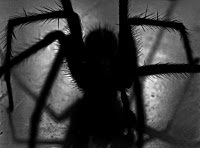 A clairvoyant had tried to locate the murderer through a spiritualist session, and received a parcel through the post the very next day, containing a large, black spider …
A clairvoyant had tried to locate the murderer through a spiritualist session, and received a parcel through the post the very next day, containing a large, black spider …***
For the next hour or so, Dom and I loaded firewood onto our barrow; in fact, we loaded far more than we could realistically transport. Dom had his length of washing-line, with which we intended to strap it all in place, but we soon had so much wood that the line wasn’t long enough. We weren’t deterred. We threw it all off again and went for quality rather than quantity. Our cheerful laughs rang across the derelict site, echoing through its empty buildings and passages. Two hours had soon gone, during which we were completely oblivious to the gradual darkening of the sky. It took a sudden sound of metal banging on metal to bring us to our senses. We both looked up at the same time. The sound had only lasted a few seconds and then stopped. We listened for it again but heard nothing. Only now did we notice how much colder and gloomier it was. Daylight had faded, to be replaced by that deep blue dimness of dusk. The banging sound might have come from a shutter tapping in the breeze, but it hadn’t sounded like that to me. It had been steady and repeated, as if someone was making it deliberately …
THRILLERS, CHILLERS, SHOCKERS AND KILLERS …
An ongoing series of reviews of dark fiction (crime, thriller, horror and sci-fi) – both old and new – that I have recently read and enjoyed. I’ll endeavour to keep the SPOILERS to a minimum; there will certainly be no given-away denouements or exposed twists-in-the-tail, but by the definition of the word ‘review’, I’m going to be talking about these books in more than just thumbnail detail, extolling the aspects that I particularly enjoyed … so I guess if you’d rather not know anything at all about these pieces of work in advance of reading them yourself, then these particular posts will not be your thing.
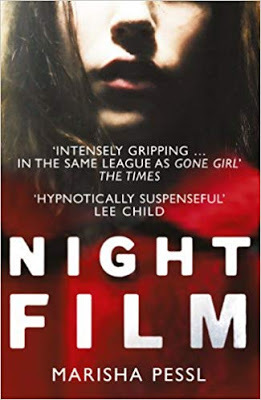 NIGHT FILM
by Marisha Pessl (2013)
NIGHT FILM
by Marisha Pessl (2013)
New York-based Scott McGrath is a forty-something investigative reporter with a colourful past. In his time, he’s put all kinds of high-profile criminals, con men and corrupt politicians on the spot, exposing their scams and lies, ruining their undeserved reputations and denuding them of their ill-gotten gains, and as such he should now be revered within his profession.
However, a few years ago, acting off untested info, he made a critical error when, on live television, he slandered cult film director, Stanislas Cordova, implying that he was a sexual predator with a penchant for the very young. Since then, having been on the wrong end of a million-dollar lawsuit, his career has tumbled. None of the major titles want to work with him anymore, and the scandal has even cost him his family, his money-minded ex-wife, Cynthia, having moved on to a new, less-impoverished partner, taking McGrath’s beloved daughter, Samantha, with her.
Five years of this exile have now passed and though McGrath isn’t exactly a mess – he works whenever he can – his thoughts are still dominated by the enigma that is Stanilas Cordova.
The creator of a string of extreme horror films, many of which are now available only as bootlegs or during special screenings purposely held in subterranean tunnels, Cordova was highly talented, a kind of cross between Kubrick, Cronenberg and Polanski, but he no longer makes movies, apparently having broken down before completion of his last masterpiece, the mysteriously titled ‘Matilda’. He hasn’t given an interview or even been seen in public for years, and reputedly lives in seclusion on his remote and fortified 300-acre country estate, The Peak, in upstate New York, which also houses the private studio where his pictures were shot. This absence from the public domain has only increased the belief among his legions of loyal fans that he is the most tortured of all movie-making geniuses, but a dark and powerful figure too, who should not be crossed lightly.
McGrath believes that Cordova is something else on top of all this, but he has nothing solid with which to keep pursuing the secretive icon, until one night in October, when he is jogging through Central Park and starts to suspect that he’s being stalked by a young woman in red. Because a few days later, he learns that another young woman in red – or, more likely, the same woman – committed suicide later that night by throwing herself down the lift shaft of a derelict warehouse. However, the most shocking aspect of this is her identity: she was Ashley Cordova, the legendary director’s sole daughter.
Ashley, an expert pianist, a child prodigy in fact, but a very troubled person, had only recently escaped from a secure care home for the mentally ill. It’s a sad tale but, thinking that the girl might have been trying to make contact with him, McGrath commences his own investigation into her death.
Initially, it proves difficult because Cordova is so elusive. There is only so much that McGrath can glean from paperwork passed to him by acerbic cop, Detective Sharon Falcone, or the film-school lectures of close friend and self-confessed Cordova nut, Wolfgang Beckman. Amusing though the Beckman scenes are, it’s mainly background material that McGrath gathers, while, though he finally gains entry to ‘The Blackboards’, a Cordova fan-site and forum on the Dark Web, he only starts to make real ground with help of two initially unlooked-for assistants: country boy Hopper Cole, a besotted ex-friend of Ashley’s (and a former fellow inmate at a reform camp they were both sent to when they were children) who is desperate to know what happened to her; and Nora Halliday, the novel’s ingénue, a waitress/actress from out of town, who happened to be the last person to see Ashley alive and thus feels it’s her destiny to participate in solving the puzzle.
Even so, it’s a complex and at times scary path, leading the intrepid threesome first to Briarwood Hall, the institution where Ashley was being held, which is so secure that it strongly implies there was something badly wrong with her; then to Cordova’s townhouse in New York City, occupied now by the director’s long-time friend and assistant, Inez Gallo, a sour-faced woman who is very protective of the Cordova brand and will resort to law (and worse, maybe) for the slightest reason; then to the even scarier confines of the Oubliette, a private sex-club on Long Island, where, once they finally achieve entry, the aura of menace is palpable; to a disquieting antiques store run by a weird fake priest called Hugo Villarde. Finally, they arrive at the junk-filled penthouse apartment of ex-star and beauty queen and Cordova’s third wife, Marlowe Hughes (the only one of his three wives who didn’t die in odd circumstances), who is now a drug and alcohol-addled wreck, living mainly in her distant memories. For all this, it is Hughes who provides McGrath with some of his tastiest morsels, explaining that Cordova got involved with a cult on first moving to The Peak, and hinting that Satanic influence may lie at the root of both his and his daughter’s extraordinary talents, for which there will always be a terrible price to pay.
Though he’s hardly a religious person, McGrath and his sidekicks gradually give weight to this latter, bizarre theory, as it doesn’t just tie in with Cordova’s reputation for being the Prince of Movie Darkness, but because they also uncover evidence that they themselves are now being hunted, and according to a ‘white witch’ called Cleopatra, have become the target of black magic rituals. At first, McGrath only partly buys this – until an unlikely accident injures young Samantha, after which he is almost fully persuaded.
With their own lives and sanity seemingly in peril, it appears that only one avenue of investigation now remains open. Somehow or other, they must access The Peak, that mysterious and forbidding country estate high in the Adirondacks.
What they will find in there, will leave its collective mark on them for the rest of their lives …
For the avoidance of doubt, I should say straight away that I thoroughly enjoyed Night Film . Even though, at 624 pages, it’s a massive tome, it was so gripping that I skipped through it in a relatively short time. But I am a sucker for satanic horror stories, especially if they’re done subtly and scarily, and for some reason – and this is purely a personal thing – I find them particularly fascinating if they’re set in contemporary times, when so many of us have abandoned any belief in God or the Devil.
The question is, however, is this actually a satanic horror novel?
Well … it gradually assumes this dimension even though it doesn’t start out that way. In its early stages, its an archetypal Noir, a bruiser of an investigator – a Philip Marlowe among journalists – using a socialite daughter to get to her celebrity father, who may or may not be a paedophile, chasing every lead he can along the darkened alleys of a dismal, rainy city, a range of strange and grotesque individuals to help him on his way. But it’s a measure of the skilled writing on show that, once the supernatural horror begins to flow – or at least when a semblance of that emerges – the novel moves seamlessly into a different literary realm, and yet as a reader you don’t feel jolted or in any way short-changed. It all seems perfectly natural, though it helps that Marisha Pessl herself holds back on the certainty that occult forces have been released, infusing her characters with doubt and disbelief, which infects the readers too, and showing very little that can’t be explained rationally.
Even in the light of all that, though, I’d caution that appearances can be deceptive. One area where Night Film is a little more ‘on the nose’ is in its presentational style. This is no ordinary novel, and you realise that straight away, as much of the narrative comes to us via authentic-looking web pages, police reports, medical records and so on, with photographic imagery included too. I could have done without the photos, in truth – I’d much rather visualise people and places myself, but, while some reviewers have taken issue with this whole approach, calling it a gimmick and an irritant, I didn’t mind it much. It doesn’t hamper the pace of the book, and, at the end of the day, we are being asked to look into this bewildering case through the eyes of a roving journalist, the background to whose investigation exists in box-loads of such dogeared paperwork, so it works on that level.
In terms of the horror, there is no shortage of scary moments in Night Film , and all play out very satisfyingly, often with serious outcomes for those involved.
But again, Marisha Pessl demonstrates great skill in hitting us with different types of fear. For example, at one stage everything is quite traditional. We get strong hints of witchcraft; one especially frightening moment sees a voodoo poppet apparently coming alive of its own volition, which flies so much in the face of the counter-culture silliness our heroes initially think they are investigating that it really shocks us. Several times during the novel, we also suspect that in Stanislas Cordova, we are investigating a maker of snuf movies, because more and more evidence appears to suggest that people really died on his sets, while significant numbers of those who participated are no longer traceable, or if they are, they seem literally to have gone mad.
Probably the two most frightening moments, though, come when McGrath and his cohorts break the normal rules of the game by intruding into private spaces. The scene in the Oubliette sex-club is a real nerve-jangler despite the fact that nothing particularly explicit – in terms of sex or violence – actually occurs. But even that is superseded by the events at The Peak, when our heroes finally bite the bullet and opt to invade what they consider to be Cordova’s inner sanctum. I won’t say any more about that for fear of spoiling things, except to add that, even protracted over fifty pages (yes, it’s a bit too long, alas), it’s an unforgettable head-trip, and a real exercise in existential horror.
It is that indefinable kind of horror, though, which, while it might crystallise in moments like this, pervades the entire book, the author gradually eroding our sense of reality. This becomes a key factor in Night Film : what is real and what isn’t? Even McGrath starts to question this, eventually wondering if he too has now become a character in a Cordova script, even going to the trouble of checking his own life for some of the clandestine signposts with which the maestro used to fill his movies – and finding them.
It’s all done immensely cleverly and, as I say, subtly too, so that it creeps up on you in the most effective, skin-crawling way.
Less subtly perhaps, but certainly enjoyably for film buffs, I’d imagine, are the countless semi-concealed references to classic cinema. You won’t have to look very hard to spot reminders of ‘dark movies’ like Don’t Look Now , The Ring and Eyes Wide Shut , while the feuding actress sisters are reminiscent of the sibling rivalry between Olivia de Havilland and Joan Fontaine, which entertained Hollywood for so many years (one of the fictional actresses is even called ‘Olivia’). Cordova himself, of course, calls to mind any number of intense, eccentric and even ‘dangerous’ film directors; we’ve already mentioned Kubrick, Polanksi and co, but you could add to that John Huston, William Friedkin et al.
So, there’s the good stuff. But did I have any problems with Night Film ?
I have to admit that there were one or two. For the most part, it’s a beautifully written book, especially in its description of place and character, though there is a slight weakness in the latter.
I’m not sure it’s a good thing that the narrative’s two most overarching personalities, those who live and breathe more than any other – Cordova and his daughter – barely appear. It’s a good indicator of how much work Pessl has done on those two in particular, but it’s a shame that several of those characters we actually interact with don’t match up. McGrath is fine. He’s all there; we can see him, we can hear him, we root for him throughout – there’s no problem. But while Nora and Hopper are pretty vivid too, and both go on clear cut journeys, neither appear to fulfil their potential in the story. Again, I don’t want to give too many spoilers away, so you’ll need to make your own judgement on that when you read it.
Other, secondary characters – Falcone, Beckman, Villarde and Hughes being the best examples – are well-realised but are little more in truth than walking info-dumps. Don’t get me wrong; sometimes you need this – the nature of the mystery novel means that we have to learn stuff now and then – but there are quite a few of them here, and on occasion these walk-ons’ explanations of past events, which are frequently offered without the investigators actually having earned them, become extensive chunks of very detailed exposition.
That said, the only one that really jarred for me came from Marlowe Hughes, who seemed to throw off her drug-induced stupour with remarkable speed in order to fill McGrath in on a whole array of Cordova background details.
I suppose I had only one other brickbat. The idea that a film maker could exist who is so darkly talented (with or without devilish assistance) that his movies have driven viewers mad with terror, induced nervous breakdowns, instigated murder and suicide, is perhaps a little bit … dare I say it, pretentious. I too love to read about these mad, elusive geniuses who, even though we know they are probably quite prosaic characters underneath, revel in their strange reputations and do produce, from time to time, works of high cinematic art. But I think there’s a danger that such student-type adoration can be taken a little too far. That certainly happens in Night Film – we really are required to buy into the Cordova myth – though to be fair to Pessl, The Blackboards, which is the main chat room for his followers, appears to be full of affected, OTT individuals, whom McGrath, while he doesn’t exactly disdain them, is cynical about.
So, there we are. That is Night Film . As I say, it’s not without its negatives, but I still found it a thoroughly engrossing read – so much so that, even though it’s massive, I carved my way through it with ease and delight. Don’t be put off by its great length. It’s an intriguing and fascinating thriller, which races along and rises to some spectacularly hair-raising climaxes en route. It’s a must-have for anyone’s dark fiction shelf.
I’ve no idea whether Night Film has been optioned for film or TV development yet, but as usual, I’m now going to be bold (or stupid) enough to suggest a cast should such a thing arise. No one will listen to me, of course, so it’s just a bit of fun. Feel free to agree or not, as the case may be. Here we go:
Scott McGrath – Mark RuffaloNora Halliday – Chloë Grace MoretzHopper Cole – Lucas TillInez Gallo – Sonia BragaMarlowe Hughes – Diane LaneOlivia Endicott – Rachael HarrisHugo Villarde – Michael EmersonCleopatra – Kelly HuDetective Sharon Falcone – Shannon LeeCynthia – Thandie NewtonWolfgang Beckman – Sebastian Koch
Published on September 29, 2019 02:52
September 23, 2019
Terror Tales of Northwest England is here
 Fantastically excited today to be announcing that TERROR TALES OF NORTHWEST ENGLAND is now available to pre-order, initially as an ebook, but very soon as a paperback, with an official publication date due of October 1.
Fantastically excited today to be announcing that TERROR TALES OF NORTHWEST ENGLAND is now available to pre-order, initially as an ebook, but very soon as a paperback, with an official publication date due of October 1.More about that in a moment. But as well as that, this week I’ll be reviewing and discussing THE LONEY from Andrew Michael Hurley – not just because it’s a chilling and enthralling tale of the supernatural macabre, but because this too, very appropriately for today, is mostly set in the wild bleakness of Northwest England.
If the Hurley review is all you’re here for, no worries. You’ll find it as usual at the lower end of today’s blog. Scoot on down there right now. But if you’re interested in this latest volume from the TERROR TALESseries, stick around here for a bit and check out …
Terror Tales of Northwest England
I won’t waste any more time than I need to here. With luck you’ll already realise that each book in this series focusses on a different corner of the UK, offering ‘true terror’ anecdotes (from me) and original horror stories from some of the best authors in the dark fiction business.
Here is the back-cover blurb, a full table of contents, and some whistle-wetting extracts:
England’s majestic Northwest, land of rain-washed skies, dark forests and brooding, windswept hills. Famous too for its industrial blight and brutal persecutions; a realm where skulls scream and witches wail, gallows creak and grave-robbers prowl the long, black nights …
The hideous scarecrows of LuneThe heathen rite at KnowsleyThe revenge killings in PrestonThe elegant ghost of CombermereThe berserk boggart of MostonThe malformed brute on MannThe walking dead at Haigh Hall
And many more chilling tales by Ramsey Campbell, Stephen Gallagher, Sam Stone, Simon Kurt Unsworth, Cate Gardner, and other award-winning masters and mistresses of the macabre.
Table of Contents
Normal Bones by Jason Gould The Lost Lads of Rivington The Mute Swan by Cate Gardner The Resurrection Men Factory Rook by Simon Kurt Unsworth Night Falls Over Pendle Tights and Straw and Wire Mesh by John Travis The Lancashire Boggarts A Weekend Break by Edward Pearce Lord Combermere’s Ghost Writer’s Cramp by David A Riley Screaming Skulls Wet Jenny by Christopher Harman Land of Monsters The Drain by Stephen Gallagher Chingle Hell Only Sleeping by Peter Bell Of Gods and Ghosts Peeling the Layers by Sam Stone The Borgias of the Slums Root Cause by Ramsey Campbell The Horror at the Gatehouse Formby Point by Anna Taborska Hill of Mysteries Below by Simon Bestwick The Vengeance of Bannister Doll Old Huey by Solomon Strange A Vision of His Own Destruction The Upper Tier by Paul Finch
Ethos
That’s a big word, isn’t it … ‘ethos’? Is it too grand a claim to make of a horror anthology series, that it has its own ethos?
Well, I hope not, but you must judge.
In the case of this series, the ethos has always been to evoke the atmosphere and mystery of different corners of Great Britain, examining them culturally, historically, geographically and in terms of their folklore and mythology, and indeed, jacketing them with similarly representative images.
So, for example, with TERROR TALES OF NORTHWEST ENGLAND , the idea was not simply to tell scary stories that happen to be set in the Northwest. They must be scary stories about the Northwest, either that or deeply immersed in that region. The same applie to EAST ANGLIA , CORNWALL , the COTSWOLDS , the LAKE DISTRICT , WALES, LONDON and all the other areas we’ve so far visited (and the many areas we have yet to visit).
And as I say, part of this is the inclusion of snippets of non-fiction – local legends and terrifying tales believed to be true (or at least believed to possess a kernel of truth).
Will this series restrict itself solely to the British Isles?
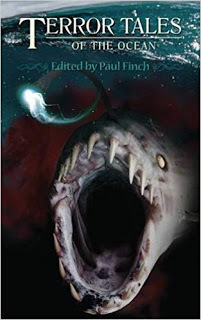 Well, that’s not my intention. The overall project was inspired by the Ronald Chetwynd-Hayes edited series,
Tales of Terror
, as published by Fontana in the 1970s. They didn’t restrict themselves exclusively to Britain, so we are going the same way. In fact, I’ve already ventured beyond Britain’s boundaries once with
TERROR TALES OF THE OCEAN
… but we don’t want to run before the horse to market. I’d like nothing better than to list all the regions of the world that I’d love to visit in TERROR TALES, but let’s focus on the here and now.
Well, that’s not my intention. The overall project was inspired by the Ronald Chetwynd-Hayes edited series,
Tales of Terror
, as published by Fontana in the 1970s. They didn’t restrict themselves exclusively to Britain, so we are going the same way. In fact, I’ve already ventured beyond Britain’s boundaries once with
TERROR TALES OF THE OCEAN
… but we don’t want to run before the horse to market. I’d like nothing better than to list all the regions of the world that I’d love to visit in TERROR TALES, but let’s focus on the here and now.So, I reiterate that the latest volume in the series, TERROR TALES OF NORTHWEST ENGLAND is now available for pre-order. As well as all the usual online outlets, it can also be acquired direct from TELOS BOOKS .
And now, just to whet your appetites a little further. Here are several snippets:
A part of my rational brain tried to tell me that it must be a man – the farmer playing a trick, standing up there all day dressed as a scarecrow waiting for somebody to frighten – but God help me I knew that it wasn’t. With nowhere to hide I ran down the track … Tights and Straw and Wire Mesh John Travis
A crooked figure moved with a see-saw motion over the road from the church; twisting with repulsive gait up the garden steps; a wan grinning face tilting up towards the window; an awkward yet deliberate plodding down the long dark corridor, its abominable approach slow but inexorable … Robert turned his eyes to the door … Only Sleeping Peter Bell
I got one other brief impression, of the beast that was bearing down on him from the deeper shadows and it was everything we’d feared it might be; the Hydra, the Gorgon, the Big Bad Wolf, a tunnelful of viciousness thundering toward Spike with the momentum of a train, eyes like baleful headlamps and teeth like knives … The Drain Stephen Gallagher
All Hallows Eve
On a not unrelated note, I’m very happy to announce that I’ll be participating in a special HORROR FOR HALLOWEEN panel at Waterstones, Kendal (in the southern Lake District) on Halloween Night this year, where I’ll be reading something spooky of mine and taking questions and answers. It won’t just be about me, of course. I’ll be in company with two other august names from the realm of spooky fiction, Simon Kurt Unsworth and Ray Cluley. For full info on this event, follow the link.
 As far as I’m aware, most of my titles will be available for purchase on the night. Certainly all the Heck and Lucy Clayburn novels, along with various titles from the TERROR TALES series,
TERROR TALES OF NORTHWEST ENGLAND
especially, but also the paperback version of
SEASON OF MIST
, a recent novella of mine, which tells an autumnal tale of murder and the supernatural in a Northwest coal town during the 1970s. Childhood horrors abound in a story of Halloween, Bonfire Night and ritual slaying.
As far as I’m aware, most of my titles will be available for purchase on the night. Certainly all the Heck and Lucy Clayburn novels, along with various titles from the TERROR TALES series,
TERROR TALES OF NORTHWEST ENGLAND
especially, but also the paperback version of
SEASON OF MIST
, a recent novella of mine, which tells an autumnal tale of murder and the supernatural in a Northwest coal town during the 1970s. Childhood horrors abound in a story of Halloween, Bonfire Night and ritual slaying.Hoping to see a few of you there.
THRILLERS, CHILLERS, SHOCKERS AND KILLERS …
An ongoing series of reviews of dark fiction (crime, thriller, horror and sci-fi) – both old and new – that I have recently read and enjoyed. I’ll endeavour to keep the SPOILERS to a minimum; there will certainly be no given-away denouements or exposed twists-in-the-tail, but by the definition of the word ‘review’, I’m going to be talking about these books in more than just thumbnail detail, extolling the aspects that I particularly enjoyed … so I guess if you’d rather not know anything at all about these pieces of work in advance of reading them yourself, then these particular posts will not be your thing.
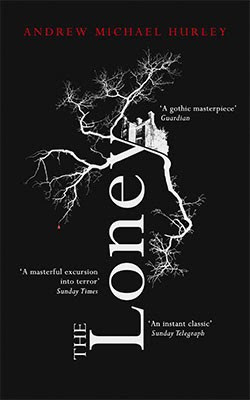 THE LONEY
THE LONEY by Andrew Michael Hurley (2016)
We open in the present day, when a misanthropic Londoner known simply as Smith becomes concerned about the discovery of a child’s bones on a remote beach in Lancashire. Smith, we suspect, knows more about this than he should – as does his older brother, a much more contented and grounded character called Andrew.
Andrew is a reasonably successful author, and happily married. He even works as a lay pastor in the Catholic Church, and in so many ways has a better life than his younger sibling, who is an unlikable loner. However, it is Smith, not Andrew, whose narration now takes us back 40 years to the actual start of our story.
It’s the mid-1970s, and each year at Eastertime, Smith and Andrew, young teenagers at this point, (Andrew called by his nickname, ‘Hanny’), are part of a small group of devout Roman Catholics who uproot from their London parish of St Jude’s, and under the humourless leadership of the stern Father Wilfred, head north to the bleak Fylde Coast, specifically a stretch of it known locally as ‘the Loney’, where they lodge in a one-time taxidermist’s home-turned-hostel called ‘Moorings’ (which each time they visit has deteriorated even more in the harsh coastal weather). It’s a form of Christian retreat, wherein they make full penance and follow prayerful rituals, but every year the purpose of the trip is the same. Young Hanny, a far cry from the well-rounded adult he will become, is mute and has severe learning difficulties. The highlight of each trip is therefore a visit to the nearby shrine, or holy well, where it is hoped that God will cure the afflicted lad.
In 1976, the group make what will become their final trip to the Loney. It almost doesn’t happen, because Father Wilfred – to everyone’s horror – has died in circumstances that might conceivably have been suicide, and his replacement, the happy-go-lucky Irishman, Father Bernard, has a less muscular approach to religion. However, Esther Smith, or ‘Mummer’, Smith and Hanny’s devout alpha-female mother, manages to persuade the new guy that everyone wants to keep going to the Loney, and so the small group heads north again.
This time, though, things will be different.
From the very beginning, we get the feeling that, somehow or other, time is running out for this small band of pilgrims. Under the unofficial leadership of Mummer (that name alone, not to mention ‘Farther’, which is how Smith’s dad is referred to, suggests they have isolated themselves for too long from modern society), they are determined to stick to the esoterica of older and more robust religious practise, which even Father Bernard tacitly disapproves of. But it isn’t just that. Other things have now changed at the Loney.
An atmosphere of … dare I call it ‘evil’? lurks on the encircling marshes, summoned by a mysterious tolling bell. A locked room is discovered in the house, where it looks as if a child was once held prisoner. They also find jars filled with urine, nail-clippings and other odious bric-a-brac, which quite clearly have been used in protection spells. They are continually menaced by a group of rough-hewn local men, who are never to be seen without their savage dog.
Mystery piles upon mystery. Smith and Hanny chance the dangerous mudflats – this is clearly Morecambe Bay by another name – crossing to a grim islet called Coldbarrow, on which an austere house, Thessaly, has stood empty for years. Now, however, the house is occupied by a curious nouveau riche couple, who seem to be completely out of place here, and, odder still, who are the guardians of a heavily pregnant girl of about 13. Hanny takes a liking to the girl, who is sweet to him – probably the only person who ever has been – but it’s soon made clear to the boys that they are not welcome.
Back at Moorings, things are going from bad to worse. The nervous caretaker advises the group that there are people in the area who don’t want them here. Rowdiness is then heard in the nearby woods at night, and when a search is made, the men of the group discover evidence of a dark ceremony and a hideous hanging scarecrow that has evidently been used in a mockery of Christ’s crucifixion.
And yet despite these ever-more tangible threats, the group are unable to draw strength from within. Esther Smith has faith but no charity and is now in constant if understated conflict with Father Bernard, who she feels is weak and is thus determined to get rid of once they return to St Jude’s. The others, still devastated by the death of Father Wilfred, and unwilling to confront the possibility that some inner conflict caused him to lose his belief, go meekly along with her, which only adds to the glum atmosphere. Even the old religious fixtures on the coastline feel spiritually abandoned: the local church is filled with terrifying images of the Seven Sins and medieval hellfire but offers little in the way of comfort. The church itself is found inexplicably chained up on Easter Sunday. Could God really have abandoned this place?
And yet still the two youngsters, Smith and Hanny, continue to explore their gloomy playground, oblivious to the sinister undercurrents, innocent, naïve, happy(ish) with their lives, and completely unaware of the dark forces that are rising in this drear place …
All kinds of claims have been made about The Loney by a whole range of reviewers. That it’s yet another chapter in the fast-evolving world of British folk-horror. That, even though he takes a distinctly modern slant in this his first novel, Andrew Michael Hurley is reviving the tradition of the British weird in a mainstream format and is clearly the heir-apparent in terms of style and substance to MR James. And above all, that it’s an engrossing, thoroughly enjoyable and at times very frightening read.
That latter point I completely concur with. I hurtled through this book, finding it deeply suspenseful and intriguing, and if, while perhaps not thinking it so scary that it rendered sleep impossible, certainly being disturbed and unnerved by its grotesque undertones, and by two scenes in particular: that moment in the midnight forest when the sacrilegious scarecrow is found, and the unexpected arrival at Moorings of a bunch of so-called Pace Eggers, an old Easter tradition which here is loaded with menace as the mysterious masked performers are unwisely invited inside.
But oddly, especially after making grand claims like that, it’s the bit about The Loney advancing the cause of folk-horror that I would quibble with.
First of all, even though the book carries a generous plaudit from Stephen King, I’m not sure that hardcore horror addicts would consider it to be any kind of horror, or even a supernatural thriller. It’s a deeply introspective tale, worryingly so at times, unreliably narrated and full of mystery. It also skates over the surface of some extreme darkness. But it’s structured more like a literary novel than a work of genre, with an emphasis on place and character rather than plot, and though it’s undoubtedly a quick, smooth read, it concerns itself much with the intricacies of faith and devotion, and certainly doesn’t race towards an explosive or chilling climax (not that there aren’t subtle terrors to be found right at the end of the book, if you look closely enough).
As for the folklore bit, well … I’m half and half on that. Okay, The Loney is set on a wild, windswept corner of the Lancashire coast, with lots of old relics dotted around, strong religious customs still in practice, and a steadily increasing suspicion that some kind of power lies latent in the very ground, and though you may say that this is all it takes to tick the folk-horror box, personally, I think this whole pigeon-holing of genre novels is a bit daft given that so many of them overlap boundaries on all sides. However, if pressed on the subject, I’d argue that The Loney is actually less of a folk-horror and more an occult mystery.
It’s fairly evident that when the church group arrives at Moorings, they antagonise certain folk because they are so religious, and this being the ‘New Age’ 1970s rather than the atheistic 21st century, this dislike probably stems from some local people having an alternative belief system – pagans or Wiccans you might think, except that they exude a genuine, overt threat, so perhaps more likely it’s a coven of Satanists. The totem in the woods is near enough proof of this, though Andrew Michael Hurley is a restrained and sensitive writer, and even through the observant character of Father Bernard, he resists making any obvious statement to this effect, though he works some subliminal suggestions into the narrative: for example, after Hanny is cured by this mysterious alternative group (even though his visit to the Christian shrine failed), the priest advises that Smith should not be fooled by the work of ‘tricksters’ whose power will invariably fade, and indeed, towards the end of the book, we get a slight hint – very slight in fact, almost subliminal – that Hanny’s new happy life may lack longevity.
It may not be an out-and-out horror novel, but The Loney has certainly got that neo-Gothic vibe, and there are some stomach-curdling moments (a baby lamb torn apart by a savage dog, the discovery of a sheep’s skull with the optic nerves still dangling out, etc). Just don’t expect constant blood and thunder, and likewise don’t look for anything as remotely on-the-nose as MR James (despite the witch-bottles with which the old house has been protected by former tenants – those are very effective and chilling moments).
Some, of course, would argue that such subtlety is one of Andrew Michael Hurley’s great strengths. Another is the excellence of his writing.
In The Loney , every detail of land and sea is delicately observed. You can almost feel the raw salt wind. You can hear the relentless drum of rain on the crabby slate roof. Two particular interiors are astonishingly evocative. Moorings, that strange seaside hostel, which is almost a byword for dreariness, with its dark, dank passages, its stuffed animals, its dismal closed-off rooms still scattered with toys left behind by children doomed to die from TB. And then the nearby shrine: little more than a rank cleft in the earth, the putrid, peaty waters pouring into which are supposed to be sacred, and yet are “black and silky-looking with a smell of autumn deadfall and eggs”.
And this brings me neatly onto the subtext, the culture clash – not just between the small church group and their Devil-worshipping opponents, but between the group and the rest of society.
Even though this is the 1970s, when more British folk had faith than they do now, Esther Smith rules her people with a rod of iron. Taking her lead from the grim if deceased figure of Father Wilfred, she’s way past the stage where a genuine desire to do good has simply clouded her judgement, and has now become a zealot of the worst sort, a mean-spirited bully who displays none of the love that Jesus taught but is so convinced that righteousness stems purely from belief that she tolerates no opposition, no dissent, and lays the law down on every matter.
But don’t make the mistake of thinking that this is Andrew Michael Hurley putting Christianity under the microscope and finding it wanting. More, it’s Hurley putting all extreme versions of belief under the scope, disapproving particularly of that moment when hardline faith, whatever it might be, morphs into harmful superstition (the moment when Esther tries to make Hanny drink the water in the shrine is quite horrible), and when idealism becomes ideology, which of course leads to isolation and echo-chamber. Esther Smith personifies this, but it’s also exemplified in the contrast between Father Wilfred and his replacement, Father Bernard, the former a harsh disciplinarian (and maybe worse), who reflects almost none of the lessons taught in the New Testament , the latter, who, while not necessarily a hip or modern priest, has served in Northern Ireland, and so understands that right and wrong are separated by shades of grey.
I sincerely hope that I’ve not put off any genre fans with this assessment of The Loney .
Okay, I say again that this is not Night of the Demon , and if anything it’s a deep and absorbing study of religious over-insularity, of the problems and complexities that can result, and ironically, of how poorly it may then gird you for that ghastly moment when real evil appears in your midst. But yes, it is unnerving, disturbing, distressing – all those words apply – and it leaves you pondering it long after you’ve finished reading, which is surely proof that this is dark fiction of the highest quality.
Often at the ends of these reviews, I, very foolishly, suggest the cast I would choose should the book in question be translated to film or TV. Not so on this occasion. The young leads, Smith and Hanny, carry the bulk of the plot, and I have no inside info whatsoever about our best juvenile actors. Even so, here’s hoping that this one gets made. In the light of recent subdued but also very macabre horrors like Hereditary or Midsommar, I feel it could work very well.
Published on September 23, 2019 15:14
September 3, 2019
At last, the SEASON OF MIST is upon us!
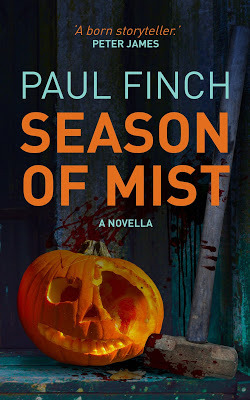 Well, August was a bit of a disappointment. We had a couple of nice days, admittedly, but on the whole it was an early taste of autumn. And now, inevitably, the real thing has arrived.
Well, August was a bit of a disappointment. We had a couple of nice days, admittedly, but on the whole it was an early taste of autumn. And now, inevitably, the real thing has arrived. However, this provides an exciting opportunity for me, because now, at last, I can talk properly about SEASON OF MIST, a 40,000-word novella of mine, which is available right now in ebook format (with the paperback following in about a month’s time).
Obviously, you can see the front cover here, and I’m sure you’ll agree that it comprises some majestic artwork from Neil Williams. I’ll give you the full skinny on this in a second, because I should also mention that this week I’ll be reviewing and discussing another dark British thriller with a strong folk-horror vibe: FEROCITY, by Stephen Laws.
Laws, as many of you will recall, is a writer with a great horror pedigree and many best-sellers under his belt. If you’re only here for that review, you’ll find it, as always, at the lower end of today’s blogpost. Feel free to dive straight down there, if you so wish. However, if you’ve got a little more time before then, we can talk about …
Season of Mist
To start with, here’s the back cover blurb:
Our last autumn of innocence. Star-spangled nights. Mist-wreathed woodland. A twisted shape watching coldly from the shadows.
Industrial Lancashire, 1974.
The kids in the coal-mining town of Ashburn love the waning of the year. Fancy dress and scary stories for Halloween. Fireworks and treacle toffee on Guy Fawkes Night. And a month after that, snow and the approach of Christmas.
But this particular autumn will be memorable for entirely different reasons.
Because this year someone is killing the children of Ashburn.
Or should that be SOMETHING?
While police and parents search for a maniac, Stephen Carter and his schoolmates know better. They may be on the cusp of adulthood, but there’s still enough of the youngster left in each of them to recognise the work of an evil supernatural being unique to these deserts of slagheap and coal-tip.
***
This book is a reprint; I should come clean about that straight away. It first appeared as a short novel in my collection, WALKERS IN THE DARK (below right), from AshTree Press back in 2010. But that was several years ago and I like to think that I’ve picked up a few more readers since then, particularly from among the crime and thriller crowd. And for that reason alone, I’m very hopeful that this particular tale can fly again.
 Because
SEASON OF MIST
, apart from being among my personal favourites of all the things I’ve ever written, is at least as much a crime-thriller as it is a horror (though there is strong horror in it, not to mention much supernatural folklore).
Because
SEASON OF MIST
, apart from being among my personal favourites of all the things I’ve ever written, is at least as much a crime-thriller as it is a horror (though there is strong horror in it, not to mention much supernatural folklore).The back-cover blurb gives about as much of the outline away as I’m prepared to countenance, and so I won’t go into any more detail about it than that. But here’s a thumbnail background on what inspired it ...
Origins
SEASON OF MIST springs directly from my love of two things when I was a child.
Firstly, the autumn, that ‘season of mists and mellow fruitfulness’ (Keats), which, when we were youngsters, always seemed to steal upon us very quickly once the school summer holidays had ended. Before we could blink, the evenings were darker, longer, our local woods had become desolate and eerie. Yet, we always seemed to adjust to it subconsciously; instead of building camps, tree-houses and rope-swings, our attention switched naturally to scarier games, to telling ghost stories and, of course, to preparing for those two great autumn festivals here in the UK: Halloween and Bonfire Night.
In the early 1970s, Halloween wasn’t such a big deal in Britain, not like now. But all that this meant was that we kids had to improvise our own parties, our own costumes, and our own trick-or-treating expeditions. What this added up to was that, on October 31, and probably for several days leading up to it, ours was a world without adult supervision. Which meant that it could sometimes get out of hand, but also that there was no limit to the terror you could inflict on each other, and most important of all, that there was no one there to help if a real ghost or monster showed up.
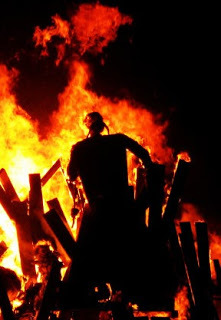 Conversely, meanwhile, Bonfire Night was bigger back then than it is now. Ever since the Millennium, fireworks have become a staple form of entertainment at everything from weddings to birthdays, from Midsummer to New Year’s Eve. But back in the early ’70s, it was only really November 5 when we used to light up the skies, which meant that this was a particularly exhilarating time for youngsters. You made your Guy Fawkeses out of any old clothes you could scrounge, you built you bonfires anywhere you could (no Health & Safety back then, remember), you acquired fireworks by any means possible (usually older siblings, or understanding parents), and you very stoically navigated the macabre TV warnings that suddenly started cropping up during children’s television, depicting burnt kids from the previous year.
Conversely, meanwhile, Bonfire Night was bigger back then than it is now. Ever since the Millennium, fireworks have become a staple form of entertainment at everything from weddings to birthdays, from Midsummer to New Year’s Eve. But back in the early ’70s, it was only really November 5 when we used to light up the skies, which meant that this was a particularly exhilarating time for youngsters. You made your Guy Fawkeses out of any old clothes you could scrounge, you built you bonfires anywhere you could (no Health & Safety back then, remember), you acquired fireworks by any means possible (usually older siblings, or understanding parents), and you very stoically navigated the macabre TV warnings that suddenly started cropping up during children’s television, depicting burnt kids from the previous year.And of course, once these two major main events of the autumn were over, you still had December to look forward to. The opening of Advent calendars, the flowery frost patterns on bedroom windows in the mornings, the early winter snowfalls (which were so common in Lancashire in the 1970s), and after all that, of course, Christmas itself. Yes, the waning of the year was the most exciting time ever when I was a nipper.
The second thing that inspired this book was personal nostalgia.
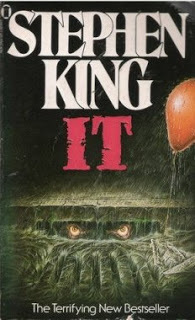 It seems to me that, over the years, many big-name American horror authors have felt they owed themselves at least one hefty tome chronicling the events of their final days of childhood, saying important stuff about coming of age, a changing society etc, but also spicing it up with all kinds of supernatural terror.
It seems to me that, over the years, many big-name American horror authors have felt they owed themselves at least one hefty tome chronicling the events of their final days of childhood, saying important stuff about coming of age, a changing society etc, but also spicing it up with all kinds of supernatural terror.Just off the top of my head, Stephen King wrote It , Robert McCammon wrote Boy’s Life , Dan Simmons wrote Summer of Night . Hell, Ray Bradbury probably started it with that all-time October classic, Something Wicked This Way Comes .
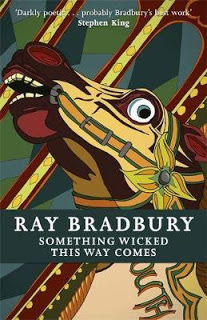 Now ... okay, stay calm. I’m NOT comparing myself with those geniuses. To start with,
SEASON OF MIST
is only 40,000 words in length – which means that when the paperback comes out, it will probably stretch to about 130 pages. But yes, when I wrote it I was unashamedly mining that same seam of fond childhood recollection, of sexual awakenings and of a transforming society (and at the same time giving it a much darker edge).
Now ... okay, stay calm. I’m NOT comparing myself with those geniuses. To start with,
SEASON OF MIST
is only 40,000 words in length – which means that when the paperback comes out, it will probably stretch to about 130 pages. But yes, when I wrote it I was unashamedly mining that same seam of fond childhood recollection, of sexual awakenings and of a transforming society (and at the same time giving it a much darker edge). Of course, there were some differences.
While Mr King wrote about Derry, Maine, Mr McCammon about Zephyr, Alabama, Mr Simmons about Elm Haven, Illinois, and Mr Bradbury about Green Town, Illinois, I opted for Ashburn, Lancashire, a thinly-veiled Wigan, which, when I was young was still an industrial blot on the Northern English landscape, a sooty sprawl of colliery spoil-land, derelict mills and rows of condemned terraced housing.
We had woods too though, and parks, and farms and quiet country lanes on the outskirts of town – I’m not channelling George Orwell here. But fair or foul, it was all one big playground to me and my mates. We were scarcely ever indoors whatever the weather, and had some truly wonderful times, but some spooky ones too – and that’s the point today. Some really spooky ones - when the leaves shrivelled, and the nights drew in, and the season of mist was upon us.’
Okay … sorry for that dollop of half-assed purple prose. I couldn’t resist. Back to business. As I say, the ebook of SEASON OF MIST can now be acquired, and at the bargain price of £1.99. Within the next month or so, we’ll be bringing out the paperback as well, so, if you’d rather be flicking pages than looking at a screen, keep watching this space.
THRILLERS, CHILLERS, SHOCKERS AND KILLERS …
An ongoing series of reviews of dark fiction (crime, thriller, horror and sci-fi) – both old and new – that I have recently read and enjoyed. I’ll endeavour to keep the SPOILERS to a minimum; there will certainly be no given-away denouements or exposed twists-in-the-tail, but by the definition of the word ‘review’, I’m going to be talking about these books in more than just thumbnail detail, extolling the aspects that I particularly enjoyed … so I guess if you’d rather not know anything at all about these pieces of work in advance of reading them yourself, then these particular posts will not be your thing.
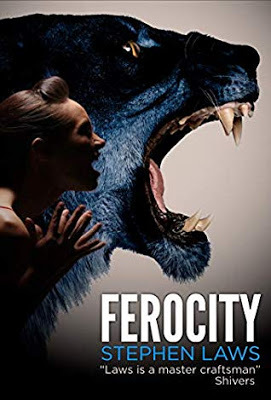 FEROCITY
FEROCITY by Stephen Laws (2007)
Cath Lane is a very talented and successful British author. She is only in her early 30s and seemingly has the world at her feet. Then, one rainy night in New York, in the midst of negotiating another lucrative deal, and just having given birth to her first child, Rynne, Cath and her husband, David, are attacked by a down-and-out, who knifes the latter brutally before fleeing the scene.
Five years later, Cath, now a withdrawn widow, has moved back home to England and lives with her daughter in a remote stone farmhouse on the Northumbrian moors. It’s something of a solitary existence, though Rynne, who has almost no memory of her father, goes to school locally, at Nicolham, and they have the assistance of Faye Roche, a spirited sixty-something, who knows the area well and now acts as their housekeeper and live-in babysitter.
Cath is attempting to get her career back on track, but is lonely and sorrowful, and constantly haunted by nightmares about that terrible night. However, the first hint of normality returns to her life when she makes friends with Drew Hall, a young and rugged local farmer, who is almost knocked down outside her house by a fast-moving car belonging to reckless millionaire businessman and playboy, Kapler Dietersen.
There would perhaps be an immediate attraction between Cath and Drew were it not for the shadow that lies between them. And this is not Dietersen, who, though he’s not popular in the district, is seen as something of a joke rather than a threat; it is Drew himself, who has many demons of his own, some of which might well be real and could even be prowling the dreary moorland at this very moment, combing for their next victim.
Drew also lost his spouse, though in this case his wife was killed in an accident involving a mechanical harvester, which he now keeps locked up in a dilapidated outbuilding and won’t touch, almost in a real-world attempt to keep the ghastly memory at bay. But one way in which he’s managed to genuinely distract himself from this troubling past is with his determined quest to prove that big cats are abroad on his land.
Several times now, Drew has actually encountered these ferocious panther-like beasts, plus he’s seen how depleted his livestock has become, a clear indication that a breeding population of such killers is covertly flourishing in the district, hidden from prying eyes even though it is very evidently at the top of the food-chain. With no natural enemies, this makes it an extremely dangerous entity. Hall is certain that it’ll only be a matter of time before a human is killed by them.
Of course, he isn’t able to prove any of this, and as his obsession has come to fill his entire life, he has allowed his farm business to run down and his home to turn ramshackle, which means that he’s now viewed in the area as a figure of sympathy (other farmers have lost sheep too) but also as something of an eccentric. A knock-on effect of this is that Cath, who, five years after her own loss, is now unconsciously yearning to re-energise her love life, is also slightly wary of him.
And yet, Drew Hall is not the oddest person in the area. The arrogant Kapler Dietersen affects the attitude of lord of the manor, and though he is an awkward and difficult customer, especially as he shares none of the locals’ affection for this wild, rural corner of England, nor respects any of its customs – for which reason he is at daggers drawn with Hall in particular – even he is not the main menace in everyone’s midst.
That honour may belong to a newcomer, an outsider, a mysterious individual called Tully. But then again, perhaps even Tully might have met his match when it comes to those dark, sleek, flesh-eating forms now roaming this district by night with ever-greater confidence …
I was delighted to learn that Ferocity , which was first published in 2007, had received a new lease of life this year, courtesy of The Brooligan Press – in fact, the sensational cover I’ve used to accompany this review is the brand new one. Other Laws masterpieces of yesteryear are also getting a makeover in 2019, Darkfall last March for example, also from Brooligan, and Ghost Train in November from Valancourt Books, among others.
However, if this gives you impression that Stephen Laws is a name from the horror past, you couldn’t really be more wrong. Yes, he has a huge track-record in the industry. But he is still going strong, and the reissue of his earlier novels – like Ferocity , which in truth wasn’t that long ago – is purpose-designed to his bring his work, which is as fresh and vital as ever, to a new generation of horror readers.
And what a worthy ambition that is.
However, in that regard, Ferocity is perhaps an unusual example of his output, because it isn’t strictly a horror novel. Don’t get me wrong. It has a dark, brooding atmosphere, is packed with suspense and features several moments of full-on terror, but such is the surprising route this enjoyable countryside romp takes that I’d classify it as more of – perhaps, possibly, maybe – a thriller, though there are undoubtedly some horror elements.
For example, the quest to uncover England’s big cats comes straight out of the folk-horror playbook. For those not in the know, the UK officially no longer has any native big cat species, and yet sightings continue to be made in the English heartlands, and farm stock continues to be damaged by such semi-mythological entities as the Surrey Puma, the Fen Tiger and most famous of all, the Beast of Bodmin Moor, whom Laws himself wrote interestingly about HERE after he went on a bona fide Beast of Bodmin hunt himself. All of these legends possibly owe to the existence in the British wild of panthers and leopards, which may have formed breeding populations after they were illegally released from captivity on introduction of the Dangerous Wild Animals Act of 1976. There is also a story that a number of US regiments based in the UK during World War Two kept big cats as live mascots and were also forced to release them into the wild when they were redeployed to the European battle zone.
Whether there is anything in this or not – whether it’s a rumour based on solid fact, or drawn from credulous imagination – who can say, but it’s one of the great urban legends of modern Britain, though in truth that should read ‘rural legend’. And it’s marvelous to finally see these mysterious creatures finally get ‘their own book’ if you know what I mean.
Needless to say, Laws goes at it full tilt in Ferocity , packing his narrative with as much big cat mythos as he possibly can, and jacking up the tension tremendously when he finally gets it through to his characters, and to us, the readers, what exactly it would mean if a huge predator was lurking in our spinneys and hedgerows, one smart enough to evade humans but savage enough to effortlessly kill them if the situation demands, and fully capable of wreaking blood-soaked havoc on a wide scale if it felt genuinely threatened.
That’s very much the world we’re in with Ferocity , though in truth it’s even more dangerous than that. Because these particular cats have an added advantage over teeth, claws and superpowered strength and aggression. They have camouflage too. This fascinating avenue isn’t fully explored by Laws in my view; I was a little bemused as to how it could actually happen – but in truth, it works very well. Though we get the occasional glimpse of life from the perspective of the predator, how could we possibly expect it to list for us and explain all its unique attributes? This leaves us with no choice but to accept that the deadliest hunters of all are those we don’t yet know about, in which case the reason for their success must remain something of a mystery.
Of course, in Ferocity , the nameless big cats stalking the fells and moors of England’s Northeast aren’t the only danger. They’re not the worst danger either. As usual, that honour is bestowed upon Man himself. I won’t go too much more into the synopsis for fear of spoiling it for you, but suffice to say that, no matter how brutal and merciless Nature can be, it will always find a counterpart in humanity. And that’s all done very believably here.
Of course, for fictional villainy to have impact, it must square off against genuine virtue, and Laws doesn’t let us down on that score either. Cath Lane and Drew Hall appeal to us immediately because they’ve suffered bereavement, as a result of which both are to an extent lost. Lane is a successful novelist, but to meet her you wouldn’t realise that; thanks to her tragic loss, she’s now shrunk back from the limelight and seems bereft of purpose. Moving across the Atlantic and settling in County Durham, with its endless woods and bleak moorland, she has almost personified her desolate state of mind. She doesn’t really know why she’s here; it was a wild flight to who knew where.
Hall, on the other hand, has found greater purpose. Despite the premature death of his wife, he remains the bluff, blunt hill-farmer that he was before, but he now throws most of his energies into uncovering the truth about the big cats that he is sure are stalking his land, a downside of which is the neglect he shows to his everyday means of existence - and at some point this will cost him dear.
Ferocity is a thoroughly exciting and engaging action-thriller of a type you wouldn’t normally expect from a horror maestro like Stephen Laws, though it’s got a dark edge as well, and it steeps us deep in the mystery and tradition of Northern England’s ancient, mist-shrouded landscape. It’s also smoothly and accessibly written, and gambols along with the jaunty energy of the fearsome beasts at the very heart of it. A bouncing page-turner, which I guarantee you’ll enjoy.
And now, as always – and as always, probably unwisely – I will attempt to cast Ferocity just in case those behind any possible film or TV version need some advice beforehand. Just a bit of fun, of course. I mean, who’d ask me?
Cath Lane – Freema AgyemanDrew Hall – Tom CullenFaye Roche – Celia ImrieKapler Dietersen – Hilton McRaeTully – Phil Daniels
(Thanks to Lonely Planet for the Bonfire Night image).
Published on September 03, 2019 00:51
At least, the SEASON OF MIST is upon us!
 Well, August was a bit of a disappointment. We had a couple of nice days, admittedly, but on the whole it was an early taste of autumn. And now, inevitably, the real thing has arrived.
Well, August was a bit of a disappointment. We had a couple of nice days, admittedly, but on the whole it was an early taste of autumn. And now, inevitably, the real thing has arrived. However, this provides an exciting opportunity for me, because now, at last, I can talk properly about SEASON OF MIST, a 40,000-word novella of mine, which is available right now in ebook format (with the paperback following in about a month’s time).
Obviously, you can see the front cover here, and I’m sure you’ll agree that it comprises some majestic artwork from Neil Williams. I’ll give you the full skinny on this in a second, because I should also mention that this week I’ll be reviewing and discussing another dark British thriller with a strong folk-horror vibe: FEROCITY, by Stephen Laws.
Laws, as many of you will recall, is a writer with a great horror pedigree and many best-sellers under his belt. If you’re only here for that review, you’ll find it, as always, at the lower end of today’s blogpost. Feel free to dive straight down there, if you so wish. However, if you’ve got a little more time before then, we can talk about …
Season of Mist
To start with, here’s the back cover blurb:
Our last autumn of innocence. Star-spangled nights. Mist-wreathed woodland. A twisted shape watching coldly from the shadows.
Industrial Lancashire, 1974.
The kids in the coal-mining town of Ashburn love the waning of the year. Fancy dress and scary stories for Halloween. Fireworks and treacle toffee on Guy Fawkes Night. And a month after that, snow and the approach of Christmas.
But this particular autumn will be memorable for entirely different reasons.
Because this year someone is killing the children of Ashburn.
Or should that be SOMETHING?
While police and parents search for a maniac, Stephen Carter and his schoolmates know better. They may be on the cusp of adulthood, but there’s still enough of the youngster left in each of them to recognise the work of an evil supernatural being unique to these deserts of slagheap and coal-tip.
***
This book is a reprint; I should come clean about that straight away. It first appeared as a short novel in my collection, WALKERS IN THE DARK (below right), from AshTree Press back in 2010. But that was several years ago and I like to think that I’ve picked up a few more readers since then, particularly from among the crime and thriller crowd. And for that reason alone, I’m very hopeful that this particular tale can fly again.
 Because
SEASON OF MIST
, apart from being among my personal favourites of all the things I’ve ever written, is at least as much a crime-thriller as it is a horror (though there is strong horror in it, not to mention much supernatural folklore).
Because
SEASON OF MIST
, apart from being among my personal favourites of all the things I’ve ever written, is at least as much a crime-thriller as it is a horror (though there is strong horror in it, not to mention much supernatural folklore).The back-cover blurb gives about as much of the outline away as I’m prepared to countenance, and so I won’t go into any more detail about it than that. But here’s a thumbnail background on what inspired it ...
Origins
SEASON OF MIST springs directly from my love of two things when I was a child.
Firstly, the autumn, that ‘season of mists and mellow fruitfulness’ (Keats), which, when we were youngsters, always seemed to steal upon us very quickly once the school summer holidays had ended. Before we could blink, the evenings were darker, longer, our local woods had become desolate and eerie. Yet, we always seemed to adjust to it subconsciously; instead of building camps, tree-houses and rope-swings, our attention switched naturally to scarier games, to telling ghost stories and, of course, to preparing for those two great autumn festivals here in the UK: Halloween and Bonfire Night.
In the early 1970s, Halloween wasn’t such a big deal in Britain, not like now. But all that this meant was that we kids had to improvise our own parties, our own costumes, and our own trick-or-treating expeditions. What this added up to was that, on October 31, and probably for several days leading up to it, ours was a world without adult supervision. Which meant that it could sometimes get out of hand, but also that there was no limit to the terror you could inflict on each other, and most important of all, that there was no one there to help if a real ghost or monster showed up.
 Conversely, meanwhile, Bonfire Night was bigger back then than it is now. Ever since the Millennium, fireworks have become a staple form of entertainment at everything from weddings to birthdays, from Midsummer to New Year’s Eve. But back in the early ’70s, it was only really November 5 when we used to light up the skies, which meant that this was a particularly exhilarating time for youngsters. You made your Guy Fawkeses out of any old clothes you could scrounge, you built you bonfires anywhere you could (no Health & Safety back then, remember), you acquired fireworks by any means possible (usually older siblings, or understanding parents), and you very stoically navigated the macabre TV warnings that suddenly started cropping up during children’s television, depicting burnt kids from the previous year.
Conversely, meanwhile, Bonfire Night was bigger back then than it is now. Ever since the Millennium, fireworks have become a staple form of entertainment at everything from weddings to birthdays, from Midsummer to New Year’s Eve. But back in the early ’70s, it was only really November 5 when we used to light up the skies, which meant that this was a particularly exhilarating time for youngsters. You made your Guy Fawkeses out of any old clothes you could scrounge, you built you bonfires anywhere you could (no Health & Safety back then, remember), you acquired fireworks by any means possible (usually older siblings, or understanding parents), and you very stoically navigated the macabre TV warnings that suddenly started cropping up during children’s television, depicting burnt kids from the previous year.And of course, once these two major main events of the autumn were over, you still had December to look forward to. The opening of Advent calendars, the flowery frost patterns on bedroom windows in the mornings, the early winter snowfalls (which were so common in Lancashire in the 1970s), and after all that, of course, Christmas itself. Yes, the waning of the year was the most exciting time ever when I was a nipper.
The second thing that inspired this book was personal nostalgia.
 It seems to me that, over the years, many big-name American horror authors have felt they owed themselves at least one hefty tome chronicling the events of their final days of childhood, saying important stuff about coming of age, a changing society etc, but also spicing it up with all kinds of supernatural terror.
It seems to me that, over the years, many big-name American horror authors have felt they owed themselves at least one hefty tome chronicling the events of their final days of childhood, saying important stuff about coming of age, a changing society etc, but also spicing it up with all kinds of supernatural terror.Just off the top of my head, Stephen King wrote It , Robert McCammon wrote Boy’s Life , Dan Simmons wrote Summer of Night . Hell, Ray Bradbury probably started it with that all-time October classic, Something Wicked This Way Comes .
 Now ... okay, stay calm. I’m NOT comparing myself with those geniuses. To start with,
SEASON OF MIST
is only 40,000 words in length – which means that when the paperback comes out, it will probably stretch to about 130 pages. But yes, when I wrote it I was unashamedly mining that same seam of fond childhood recollection, of sexual awakenings and of a transforming society (and at the same time giving it a much darker edge).
Now ... okay, stay calm. I’m NOT comparing myself with those geniuses. To start with,
SEASON OF MIST
is only 40,000 words in length – which means that when the paperback comes out, it will probably stretch to about 130 pages. But yes, when I wrote it I was unashamedly mining that same seam of fond childhood recollection, of sexual awakenings and of a transforming society (and at the same time giving it a much darker edge). Of course, there were some differences.
While Mr King wrote about Derry, Maine, Mr McCammon about Zephyr, Alabama, Mr Simmons about Elm Haven, Illinois, and Mr Bradbury about Green Town, Illinois, I opted for Ashburn, Lancashire, a thinly-veiled Wigan, which, when I was young was still an industrial blot on the Northern English landscape, a sooty sprawl of colliery spoil-land, derelict mills and rows of condemned terraced housing.
We had woods too though, and parks, and farms and quiet country lanes on the outskirts of town – I’m not channelling George Orwell here. But fair or foul, it was all one big playground to me and my mates. We were scarcely ever indoors whatever the weather, and had some truly wonderful times, but some spooky ones too – and that’s the point today. Some really spooky ones - when the leaves shrivelled, and the nights drew in, and the season of mist was upon us.’
Okay … sorry for that dollop of half-assed purple prose. I couldn’t resist. Back to business. As I say, the ebook of SEASON OF MIST can now be acquired, and at the bargain price of £1.99. Within the next month or so, we’ll be bringing out the paperback as well, so, if you’d rather be flicking pages than looking at a screen, keep watching this space.
THRILLERS, CHILLERS, SHOCKERS AND KILLERS …
An ongoing series of reviews of dark fiction (crime, thriller, horror and sci-fi) – both old and new – that I have recently read and enjoyed. I’ll endeavour to keep the SPOILERS to a minimum; there will certainly be no given-away denouements or exposed twists-in-the-tail, but by the definition of the word ‘review’, I’m going to be talking about these books in more than just thumbnail detail, extolling the aspects that I particularly enjoyed … so I guess if you’d rather not know anything at all about these pieces of work in advance of reading them yourself, then these particular posts will not be your thing.
 FEROCITY
FEROCITY by Stephen Laws (2007)
Cath Lane is a very talented and successful British author. She is only in her early 30s and seemingly has the world at her feet. Then, one rainy night in New York, in the midst of negotiating another lucrative deal, and just having given birth to her first child, Rynne, Cath and her husband, David, are attacked by a down-and-out, who knifes the latter brutally before fleeing the scene.
Five years later, Cath, now a withdrawn widow, has moved back home to England and lives with her daughter in a remote stone farmhouse on the Northumbrian moors. It’s something of a solitary existence, though Rynne, who has almost no memory of her father, goes to school locally, at Nicolham, and they have the assistance of Faye Roche, a spirited sixty-something, who knows the area well and now acts as their housekeeper and live-in babysitter.
Cath is attempting to get her career back on track, but is lonely and sorrowful, and constantly haunted by nightmares about that terrible night. However, the first hint of normality returns to her life when she makes friends with Drew Hall, a young and rugged local farmer, who is almost knocked down outside her house by a fast-moving car belonging to reckless millionaire businessman and playboy, Kapler Dietersen.
There would perhaps be an immediate attraction between Cath and Drew were it not for the shadow that lies between them. And this is not Dietersen, who, though he’s not popular in the district, is seen as something of a joke rather than a threat; it is Drew himself, who has many demons of his own, some of which might well be real and could even be prowling the dreary moorland at this very moment, combing for their next victim.
Drew also lost his spouse, though in this case his wife was killed in an accident involving a mechanical harvester, which he now keeps locked up in a dilapidated outbuilding and won’t touch, almost in a real-world attempt to keep the ghastly memory at bay. But one way in which he’s managed to genuinely distract himself from this troubling past is with his determined quest to prove that big cats are abroad on his land.
Several times now, Drew has actually encountered these ferocious panther-like beasts, plus he’s seen how depleted his livestock has become, a clear indication that a breeding population of such killers is covertly flourishing in the district, hidden from prying eyes even though it is very evidently at the top of the food-chain. With no natural enemies, this makes it an extremely dangerous entity. Hall is certain that it’ll only be a matter of time before a human is killed by them.
Of course, he isn’t able to prove any of this, and as his obsession has come to fill his entire life, he has allowed his farm business to run down and his home to turn ramshackle, which means that he’s now viewed in the area as a figure of sympathy (other farmers have lost sheep too) but also as something of an eccentric. A knock-on effect of this is that Cath, who, five years after her own loss, is now unconsciously yearning to re-energise her love life, is also slightly wary of him.
And yet, Drew Hall is not the oddest person in the area. The arrogant Kapler Dietersen affects the attitude of lord of the manor, and though he is an awkward and difficult customer, especially as he shares none of the locals’ affection for this wild, rural corner of England, nor respects any of its customs – for which reason he is at daggers drawn with Hall in particular – even he is not the main menace in everyone’s midst.
That honour may belong to a newcomer, an outsider, a mysterious individual called Tully. But then again, perhaps even Tully might have met his match when it comes to those dark, sleek, flesh-eating forms now roaming this district by night with ever-greater confidence …
I was delighted to learn that Ferocity , which was first published in 2007, had received a new lease of life this year, courtesy of The Brooligan Press – in fact, the sensational cover I’ve used to accompany this review is the brand new one. Other Laws masterpieces of yesteryear are also getting a makeover in 2019, Darkfall last March for example, also from Brooligan, and Ghost Train in November from Valancourt Books, among others.
However, if this gives you impression that Stephen Laws is a name from the horror past, you couldn’t really be more wrong. Yes, he has a huge track-record in the industry. But he is still going strong, and the reissue of his earlier novels – like Ferocity , which in truth wasn’t that long ago – is purpose-designed to his bring his work, which is as fresh and vital as ever, to a new generation of horror readers.
And what a worthy ambition that is.
However, in that regard, Ferocity is perhaps an unusual example of his output, because it isn’t strictly a horror novel. Don’t get me wrong. It has a dark, brooding atmosphere, is packed with suspense and features several moments of full-on terror, but such is the surprising route this enjoyable countryside romp takes that I’d classify it as more of – perhaps, possibly, maybe – a thriller, though there are undoubtedly some horror elements.
For example, the quest to uncover England’s big cats comes straight out of the folk-horror playbook. For those not in the know, the UK officially no longer has any native big cat species, and yet sightings continue to be made in the English heartlands, and farm stock continues to be damaged by such semi-mythological entities as the Surrey Puma, the Fen Tiger and most famous of all, the Beast of Bodmin Moor, whom Laws himself wrote interestingly about HERE after he went on a bona fide Beast of Bodmin hunt himself. All of these legends possibly owe to the existence in the British wild of panthers and leopards, which may have formed breeding populations after they were illegally released from captivity on introduction of the Dangerous Wild Animals Act of 1976. There is also a story that a number of US regiments based in the UK during World War Two kept big cats as live mascots and were also forced to release them into the wild when they were redeployed to the European battle zone.
Whether there is anything in this or not – whether it’s a rumour based on solid fact, or drawn from credulous imagination – who can say, but it’s one of the great urban legends of modern Britain, though in truth that should read ‘rural legend’. And it’s marvelous to finally see these mysterious creatures finally get ‘their own book’ if you know what I mean.
Needless to say, Laws goes at it full tilt in Ferocity , packing his narrative with as much big cat mythos as he possibly can, and jacking up the tension tremendously when he finally gets it through to his characters, and to us, the readers, what exactly it would mean if a huge predator was lurking in our spinneys and hedgerows, one smart enough to evade humans but savage enough to effortlessly kill them if the situation demands, and fully capable of wreaking blood-soaked havoc on a wide scale if it felt genuinely threatened.
That’s very much the world we’re in with Ferocity , though in truth it’s even more dangerous than that. Because these particular cats have an added advantage over teeth, claws and superpowered strength and aggression. They have camouflage too. This fascinating avenue isn’t fully explored by Laws in my view; I was a little bemused as to how it could actually happen – but in truth, it works very well. Though we get the occasional glimpse of life from the perspective of the predator, how could we possibly expect it to list for us and explain all its unique attributes? This leaves us with no choice but to accept that the deadliest hunters of all are those we don’t yet know about, in which case the reason for their success must remain something of a mystery.
Of course, in Ferocity , the nameless big cats stalking the fells and moors of England’s Northeast aren’t the only danger. They’re not the worst danger either. As usual, that honour is bestowed upon Man himself. I won’t go too much more into the synopsis for fear of spoiling it for you, but suffice to say that, no matter how brutal and merciless Nature can be, it will always find a counterpart in humanity. And that’s all done very believably here.
Of course, for fictional villainy to have impact, it must square off against genuine virtue, and Laws doesn’t let us down on that score either. Cath Lane and Drew Hall appeal to us immediately because they’ve suffered bereavement, as a result of which both are to an extent lost. Lane is a successful novelist, but to meet her you wouldn’t realise that; thanks to her tragic loss, she’s now shrunk back from the limelight and seems bereft of purpose. Moving across the Atlantic and settling in County Durham, with its endless woods and bleak moorland, she has almost personified her desolate state of mind. She doesn’t really know why she’s here; it was a wild flight to who knew where.
Hall, on the other hand, has found greater purpose. Despite the premature death of his wife, he remains the bluff, blunt hill-farmer that he was before, but he now throws most of his energies into uncovering the truth about the big cats that he is sure are stalking his land, a downside of which is the neglect he shows to his everyday means of existence - and at some point this will cost him dear.
Ferocity is a thoroughly exciting and engaging action-thriller of a type you wouldn’t normally expect from a horror maestro like Stephen Laws, though it’s got a dark edge as well, and it steeps us deep in the mystery and tradition of Northern England’s ancient, mist-shrouded landscape. It’s also smoothly and accessibly written, and gambols along with the jaunty energy of the fearsome beasts at the very heart of it. A bouncing page-turner, which I guarantee you’ll enjoy.
And now, as always – and as always, probably unwisely – I will attempt to cast Ferocity just in case those behind any possible film or TV version need some advice beforehand. Just a bit of fun, of course. I mean, who’d ask me?
Cath Lane – Freema AgyemanDrew Hall – Tom CullenFaye Roche – Celia ImrieKapler Dietersen – Hilton McRaeTully – Phil Daniels
(Thanks to Lonely Planet for the Bonfire Night image).
Published on September 03, 2019 00:51
August 20, 2019
Back from the grave: a brood of aged tales
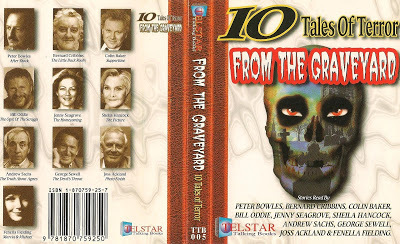
Something a little different this week. I’m going to talk about a bunch of short stories I wrote for Telstar Records back in the early 1990s, when the word ‘audible’ didn’t exist and we called it ‘spoken word’ instead.
True to form, they were all horrors and thrillers. Yes, some things never change. But in truth, it was almost 30 years ago, and so imagine my surprise when I recently came across quite a few of them, repackaged and for sale online.
It was a surprise, to be honest, but something of a delight too. There are a couple of interesting anecdotes I can share about this long-ago project – so bear with me.
On a not dissimilar subject – short, dark fiction – I’ll also be reviewing in today’s post Tom Cox’s very interesting collection of rural weirdness, HELP THE WITCH.
If you’re only here for the Tom Cox discussion and review, that’s perfectly fine. Head on down to the bottom of this blog, which is where all my reviews usually go. You’ll find it there under the ‘Thrillers, Chillers’ section. However, if you’ve got a bit more time on your hands, let’s chat a little about …
Past treasures unearthed
Okay … that might sound a little conceited, to assume that any of the short stories I wrote during my earliest days of professional authorship could ever be construed ‘past treasures’. But it was a while ago and it was an interesting time.
In the early 1990s, my police days were behind me and I was working as a journalist in Wigan, primarily, or so it seems, covering sport. I was learning my craft at the time. I hadn’t even moved over to Manchester at this stage. One area, however, where I like to think I was fairly well advanced was in short story writing.
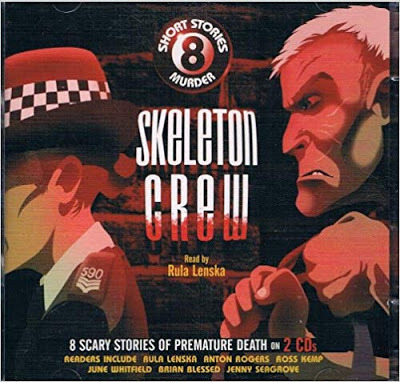
Having been raised on a diet of short, sharp horror fiction – the likes of the Pan and Fontana Horror anthologies but also the writings of such classic age scare-meisters as MR James, HP Lovecraft and Algernon Blackwood – I’d long been writing spooky stories in my spare time. Even when I was a cop, though in those very earliest days, out of necessity I’d been using a pseudonym: Robert Eastland.
Of course, way back then, my score rate was fairly low. I still remember the euphoric feeling when I received my first ever short story acceptance. It seems an awful long time ago now, but it was on a Saturday morning and I was lying in the bath when the post arrived downstairs. Oh yes, there was no Internet back then … in those days, a visit from the postman could actually mean something.
It was only a small thing, if I remember rightly. A thousand and a half words accepted for a short-lived, small-circulation British small press mag, but I was elated.
This was around 1990, but you know, it’s amazing how quickly you can hone your craft – any craft in truth – if you’re prepared to work hard on it and learn the lessons of rejection. Soon, as what was then referred to as ‘the Golden Age of the British Inde Press’ truly began to flower, providing endless opportunities for new young writers (many of whom are big names today), I was fortunate enough to sell more and more stories, and at the same time, because of my police background, to blag my way onto The Bill . It was this latter that secured me a literary agent, and from that point on, everything changed.
Spoken word
For example, not long after signing with my new agent, which was around 1993, I was asked into the office concerning an offer that had just come in from Telstar Records. In short, they were looking for writers who specialised in ghost, horror and crime stories, said writers – or writer (as in singular) – to produce a whole series of chilling tales for a new ‘spoken word’ series they were planning.
Yes, that was a brand-new thing back then. It was called ‘spoken word’ – in other words, actors reading fiction on tape (it wasn’t even on CD at this stage) and it was a truly fledgling form of entertainment.
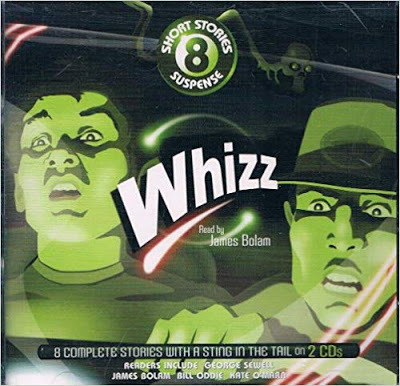
Even so, who was I to turn down such an offer? I got to it industriously. I seem to remember writing something like one short story every two or three days for the best part of two months. Almost all of them were accepted by Telstar, who planned to kick off the series with an antho called From the Graveyard (see at the top), and who, when it came to the actual recording, attached some phenomenal actors. People like Hannah Gordon, Joss Ackland, Honor Blackman, Colin Baker, Ross Kemp, Dennis Waterman, Peter Bowles, James Bolam, Roger Daltrey and others.
My brief encounter with Roger Daltrey was particularly amusing as he was selected to read a story of mine called Fancy Dress Night , which concerns a murderous misanthrope who attends a New Year’s Eve fancy dress party dressed as the Hunchback of Notre Dame, but with a tank of fuel concealed in his hump, which he intends to slowly discharge all over the crowded dance-floor. Before the night is over, of course, he will ignite it, and then flee the scene. But the best-laid evil plans rarely work out … am I right?
Anyway, Roger seemed to like the story, and suggested one slight change – which I approved of. But we had this discussion when he rang me at the Wigan Observer editorial office. I found him very amiable and chatty, and we were on the phone for a good ten minutes. When he hung up, I turned around and the entire office was standing behind me, ear-wigging.
Word that Roger Daltrey was on the line had got around fast.

In the end he did a great job for me, but so did most of the other readers. Bill Oddie, then known mainly as a comedian, read a tale called The Ogre of the Scraggs , which told the story of a group of kids taking their scrambler bikes over an extensive area of spoil-land and slagheap, and meeting something very unpleasant during the process. He literally could not have done a better job (despite being a naturalised Brummie, he got the Wigan accent bang-on).
The late, great Jon Pertwee also graced me with a reading. In fact, someone told me once that they thought A Glitch in Time , which centred around a series of nightmarishly problematic time-travel experiments at a secretive US Airforce base was the last piece of professional work he ever did, which, if true, would have been an honour beyond my wildest dreams given that Mr Pertwee was, and still is in my view, the quintessential Dr Who.
The list goes on, basically. Rula Lenska was equally superb in her reading of Skeleton Crew , which focussed on an understrength police station in a rough inner-city area on the night a deadly and vengeful cop-killer gets loose from jail. For those interested, this tale went down so well that I was later able to enlarge it, develop it, hack it, chop it, change it etc, into an episode of The Bill called Protect and Survive , which I wrote sometime in the early 2000s.
I could go on like this for a while, but I don’t want to get too boring about it. I’ll just reiterate that the spoken word versions of quite a few of these stories – maybe all, I honestly don’t know! – seem to have been repackaged again during the early 2000s (even though I only discovered them quite recently; they’ve been repackaged more than once since they were first put out, I suspect – I sold the audio rights at the time, so there was no necessity that I be kept in the loop). But their latest incarnations appears to be these collections, the jackets to which I’ve posted throughout this blog.
Sorry, but for all the reasons laid out, I don’t actually know the tables of contents and should point out at this stage that not all the stories collected in them are mine (or Robert Eastland’s, who, as I say, is also me). Other writers did contribute, though I think I provided the lion’s share. It’s probably also worth mentioning that quite a few of these tales will have appeared in print format since then, so be warned, there’s a possibility, if you go for them, that you might double up.
Anyway, that’s it on the subject of these. On the subject on another older story soon to be unearthed, a 40K-word novella of mine, Season of Mist , which originally appeared in the Ash-Tree Press collection, Walkers in the Dark in 2010, will shortly be republished, both electronically and in print (and maybe via Audible too) hopefully in time for this autumn. If you’re interested, keep watching this space.
THRILLERS, CHILLERS, SHOCKERS AND KILLERS …
An ongoing series of reviews of dark fiction (crime, thriller, horror and sci-fi) – both old and new – that I have recently read and enjoyed. I’ll endeavour to keep the SPOILERS to a minimum; there will certainly be no given-away denouements or exposed twists-in-the-tail, but by the definition of the word ‘review’, I’m going to be talking about these books in more than just thumbnail detail, extolling the aspects that I particularly enjoyed … so I guess if you’d rather not know anything at all about these pieces of work in advance of reading them yourself, then these particular posts will not be your thing.
 HELP THE WITCH
HELP THE WITCH by Tom Cox (2018)
The debut collection of stories from a highly accomplished novelist, journalist and essay writer, who previously has written profoundly and entertainingly about animals and the countryside, but also about music and sport. This is his first collection of supernatural(ish) fiction, and, perhaps unsurprisingly, it’s strongly flavoured with folklore.
Initially, rather than simply list all the stories contained here and tell you what happens in each one of them, I’ll let Unbound’s official online blurb do the talking as it strongly hints at the spooky stuff lurking inside:
Inspired by our native landscapes, saturated by the shadows beneath trees and behind doors, listening to the run of water and half-heard voices, Tom Cox’s first collection of short stories is a series of evocative and unsettling trips into worlds previously visited by the likes of M. R. James and E. F. Benson.
Railway tunnels, the lanes and hills of the Peak District, family homes, old stones, shreds fluttering on barbed wire, night drawing in, something that might be an animal shifting on the other side of a hedge: Tom has drawn on his life-long love of weird fiction, folklore and nature s unregarded corners to write a collection of stories that will delight fans old and new and leave them very uneasy about turning the reading lamp off.
After all that, the main problem with Help the Witch is going to come if readers tune in expecting a bunch of traditional rural or folk-themed horror stories, because if they do that, they are almost certain to be disappointed. The blurb above describes Tom Cox as a kind of heir-apparent to MR James and EF Benson, but in my opinion that’s a little misleading.
Of course, both James and Benson were a lot more than simple ghost story writers, the former a medievalist scholar and provost of King’s College, Cambridge, the latter a famed novelist, biographer and archaeologist. But everything about Help the Witch , from its jacket art, to the splendid illustrations inside, to the blurb on the book’s inner sleeve implies that what we’re in for here is a collection of stories cut from the cloth of the uncanny.
That isn’t solely the case, though I don’t mean to say that Cox – who’s a truly excellent writer – doesn’t delve more than a little bit into that eerie world. Two stories in particular, the titular Help the Witch and Just Good Friends (of which more about later), are both exquisite chillers centred around real characters with complex emotions, and hauntings (of a kind) which come at us very subtly and genuinely frighteningly (even though Cox is not aiming for anything like the degree of terror that James and Benson routinely achieved).
Also classifiable as ghost and/or horror stories are Listings , an account of a weird haunting as relayed through a succession of news reports, magazine items etc running far into the future, and The Pool , wherein the turning seasons cause the malignant energy lurking beneath a woodland pool – an intriguingly unknowable entity – to wax and wane in terms of its power. Both comprise top quality wordsmithery by Cox, though the first tale is almost experimental in terms of its narrative style, while the second is a detailed and very lyrical study of the natural environment of the English woodlands rather than an actual scary story. (Again, more about these two later).
Beyond that, though, I’m not sure that every piece in Help the Witch did it for me. Perhaps I just didn’t think deeply enough, but contributions like Seance and Nine Tiny Stories About Houses seemed like existential oddities, even though the former is quite amusing, while another one, Robot , had the air of something that had been penned quickly and without a great deal of purpose.
I reiterate, however, that Tom Cox is a fine writer. Even those stories that didn’t endear themselves to me as chillers are skilled and poetic in their execution. But overall, it wasn’t quite what I felt I’d been led to expect. Folk-horror is a subgenre of supernatural fiction already well populated by established masters and mistresses of the form – Reggie Oliver, Steve Duffy, Helen Grant, Adam Nevill, Sarah Singleton, to name but a few – and that would be stiff competition for anyone.
But ultimately, it’s in the eye of the beholder. I can only say what I personally felt, and even I, who am not 100% sold on Help the Witch , consider that at least half the book, if not more, is well worth the price I paid for it. So, go on … grab a copy, yourself, and see what you think. There is a bit of something here for everyone.
And now …
HELP THE WITCH – the movie.
Just a bit of fun, this. No film-maker has optioned this book yet (as far as I’m aware), but here are my thoughts on how they should proceed if they do.
Note: these four stories are NOT the ones I necessarily consider to be the best in the book, but they are the four I perceive as most filmic and most right for a compendium horror. Of course, no such horror film can happen without a central thread, and this is where you guys, the audience, come in. Just accept that four strangers have been thrown together in unusual circumstances which require them to relate spooky stories.
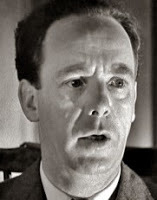 It could be that all find themselves in an idyllic country home, where a nervous renovator needs reassurance about his various nightmares (al la Dead of Night) or are the subjects of unsolved paranormal cases handed by one retired and decrepit investigator to a young up-n-comer (al la Ghost Stories – but basically, it’s up to you.
It could be that all find themselves in an idyllic country home, where a nervous renovator needs reassurance about his various nightmares (al la Dead of Night) or are the subjects of unsolved paranormal cases handed by one retired and decrepit investigator to a young up-n-comer (al la Ghost Stories – but basically, it’s up to you.
Without further messing about, here are the stories and the casts I would choose:
Just Good Friends: Helen, a beautiful 30-something, is unlucky in love until she meets the gentle, enigmatic Peter, who she is strongly attracted to despite their relationship remaining platonic. Things are finally warming up between them when Peter inexplicably claims that he’s always known her and has been following her since she was young. Unnerved by such weirdness, Helen breaks the relationship off and gets a new boyfriend, only to develop an urge to return to her native Cornwall to see her ailing mother, Alice, and investigate the mysterious old seaside house that she increasingly remembers from childhood …
Helen – Claire Foy Peter – William Moseley
Listings: The story of a bad place on the edge of the Somerset marshes. A human habitation, but a spot where various houses, pubs and the like have all been troubled by a mysterious, malevolent entity who may or may not be Tunk, the fearsome, sheep-headed goblin of local West Country myth …
(It’s up to the screenwriter to come up with a cast-list for this one, as no individual of significance stands out in the original short story).
The Pool: A scenic woodland pool with a mysterious, anonymous something lurking in its opaque depths exerts a subtle evil influence over all those who venture near it, no matter how fun-loving they are or innocent their motives. ...
(Again, it’s up to the screenwriter to come up with a cast-list for this one, as no specific character provides a focus for the tale).
Help the Witch: Jeff, an academic on the run from an irrevocably broken relationship, heads north into the Derbyshire Peaks, where he takes a primitive cottage high on a valley edge just in time to get snowed in by a terrible winter. It is probably not the best time to discover that the cottage is haunted by a spirit still lingering after the ghastly carnage of the plague era …
Jeff – Ben WhishawCatherine (voice only) – Lena Headey
Published on August 20, 2019 01:30



